

23 Must-Dos in Kakadu National Park + Itinerary Ideas (2024)
Looking for things to do in Kakadu National Park? This guide highlights the very best, along with some suggested Kakadu itinerary ideas.
Kakadu National Park is a vast and diverse landscape located in the Top End of Australia. It’s usually top of visitors’ Australia bucket list experiences , with cultural sites, wildlife, flora, fauna and scenery unlike anywhere else in Australia – or even on Earth.
Not far from the Northern Territory capital city of Darwin, Kakadu is an Australian icon. While it’s no longer Australia’s largest national park (that crown was taken by Munga-Thirri/Simpson Desert National Park in 2021), it’s a HUGE park – almost a third of the size of Tasmania!
Having just spent almost a week in this UNESCO World Heritage-listed site, I’ve pulled together a guide to what I think are the must-dos for anyone visiting Kakadu, as well as some handy travel tips.
There’s no shortage of things to see and do in Kakadu National Park and it can be overwhelming to visit, so I’ve also created some suggested itineraries to help you plan your trip.
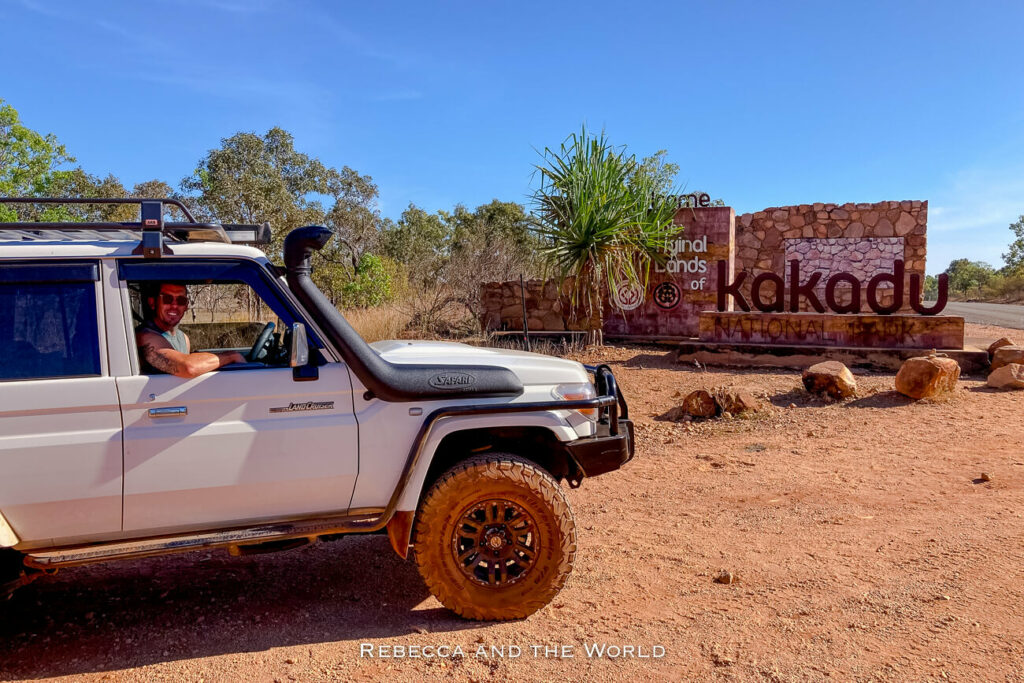
This blog post may contain affiliate links, meaning if you book or buy something through one of these links, I may earn a small commission (at no extra cost to you).
What's in this article (Click to view)
Need to know before you visit Kakadu National Park
Is it free to visit kakadu national park.
You’ll need to buy a Kakadu National Park Pass to enter. You can buy this online in advance or at the visitor centre when you arrive at the park.
A 7-day pass costs $40 for adults and $20 for kids.
While you may already have an NT Parks Pass if you’ve visited Nitmiluk National Park or Litchfield National Park , it won’t work here.
Is there mobile phone reception in Kakadu?
Mobile reception is very patchy in Kakadu. We only had reception in Jabiru and at Cooinda Lodge (sometimes). It still surprises me how bad mobile coverage is in remote parts of this country!
Visitor centre
I recommend stopping in at the visitor centre before you head further into the park.
The Bowali Visitor Centre is located at the northern entrance to the park and is a great place to learn about the traditional owners of Kakadu, their culture and the environment.
Make sure you pick up a Kakadu Visitor Guide – it’s the best printed resource about the national park. You can also download a copy online here .
There was a visitor centre at the south entrance, but it’s now closed (although the toilets are usually open). This is why I recommend (if you can) entering Kakadu from the north rather than the south. But, of course, that’s not always possible.
Plan your Kakadu visit
As I’ve already said – and will say again – Kakadu is huge. You really do need to plan your visit around key sites, otherwise you’ll be driving a lot! This may mean you’ll need to change accommodation throughout your visit so that you can be closer to different sections of the park.
I’ve got some itinerary ideas later on in this article to help you with this.
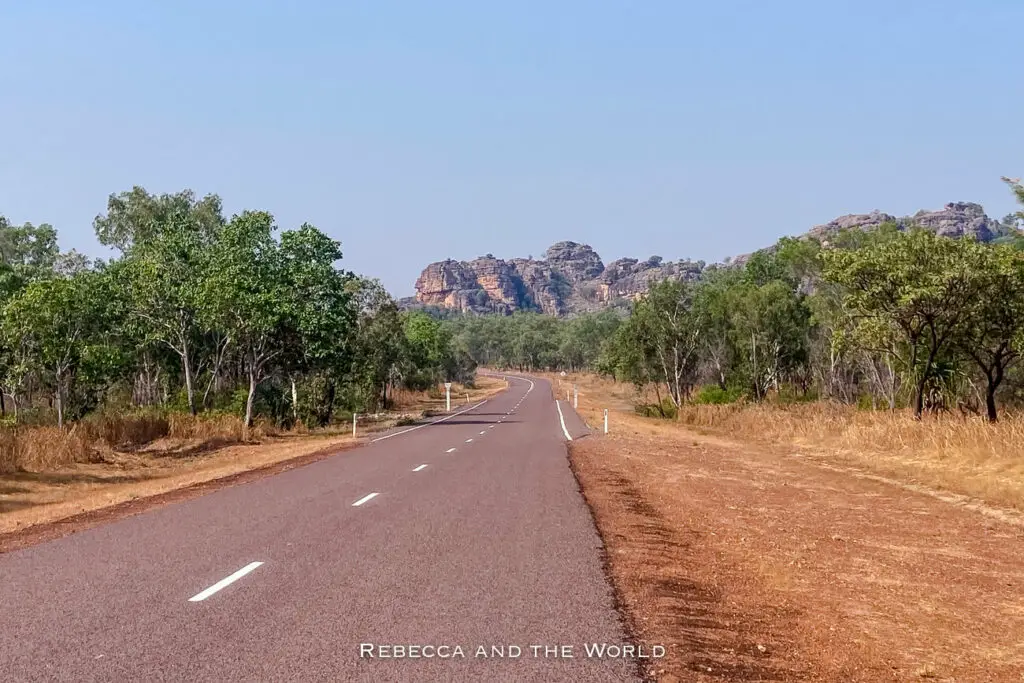
Is Kakadu open?
Parts of Kakadu can close – whether that’s due to damage, flooding or something else. Check the latest status of Kakadu attractions online here .
Map of Kakadu National Park
Everything I mention in this article is laid out on this Kakadu National Park map.
Things to do in Kakadu National Park
As I’ve already said, Kakadu is huge, so I’ve broken this article up into the 7 regions of the national park. This will help you plan your days around activities in each region, so you’re not driving back and forth.
These 7 regions are:
South Alligator region
Jabiru region, east alligator (erre) region, burrungkuy (nourlangie) region.
- Yellow Water region
- Jim Jim / Twin Falls Gorge region
Mary River region
If you’re coming from Darwin to Kakadu, the South Alligator region is where you’ll enter the national park.
1. Mamukala Wetlands
Mamukala Wetlands is a twitcher’s heaven. Head to the observation platform to see hundreds of birds, including magpie geese, ducks and herons, feeding in the wetlands.
If you have extra time, take a walk along the boardwalk to learn about Aboriginal use of plants and animals in this area. The 3-kilometre trail takes a leisurely 1-2 hours to complete.
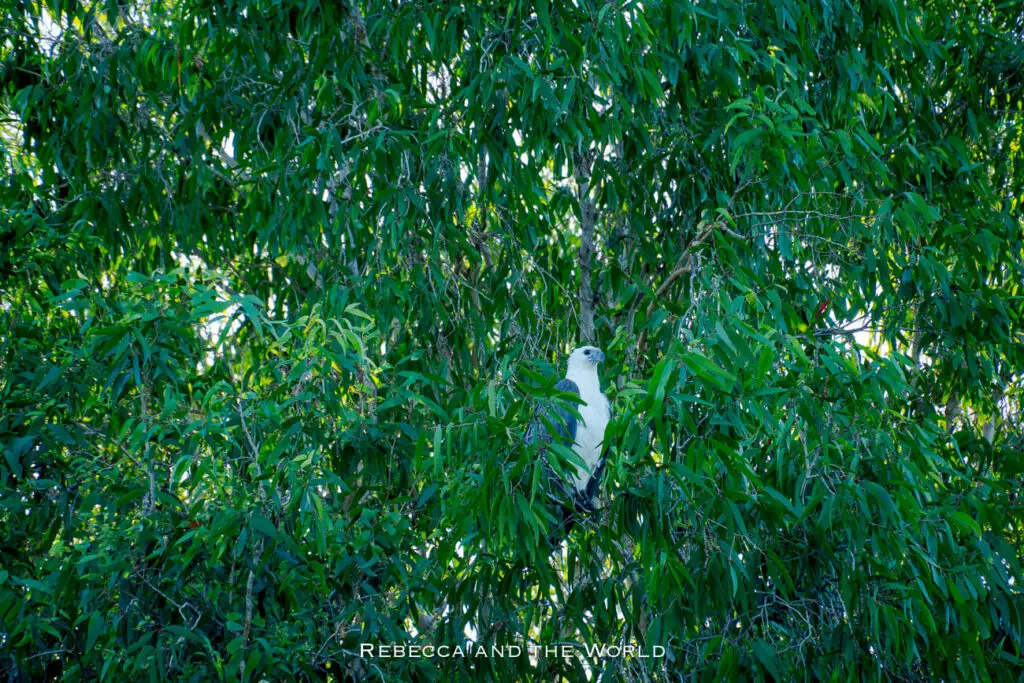
2. Boating/fishing
The South Alligator area is also a popular spot for fishing and boating for intrepid travellers. There are a few boat ramps to access the South Alligator River, some of them remote and only accessible by 4WD.
Fun fact: Why alligator and not crocodile? When the Kakadu area was first visited by Europeans, they mistakenly thought the reptiles were alligators. The rivers were named East Alligator River and South Alligator River. But as we of course know, they’re actually saltwater crocodiles. Despite that, the original alligator name has stuck.
The main town of Kakadu is called Jabiru and it has a supermarket, petrol station, mechanic, pharmacy and post office.
There are also a few hotels here, so it’s a good spot to base yourself at the beginning of your visit to Kakadu.
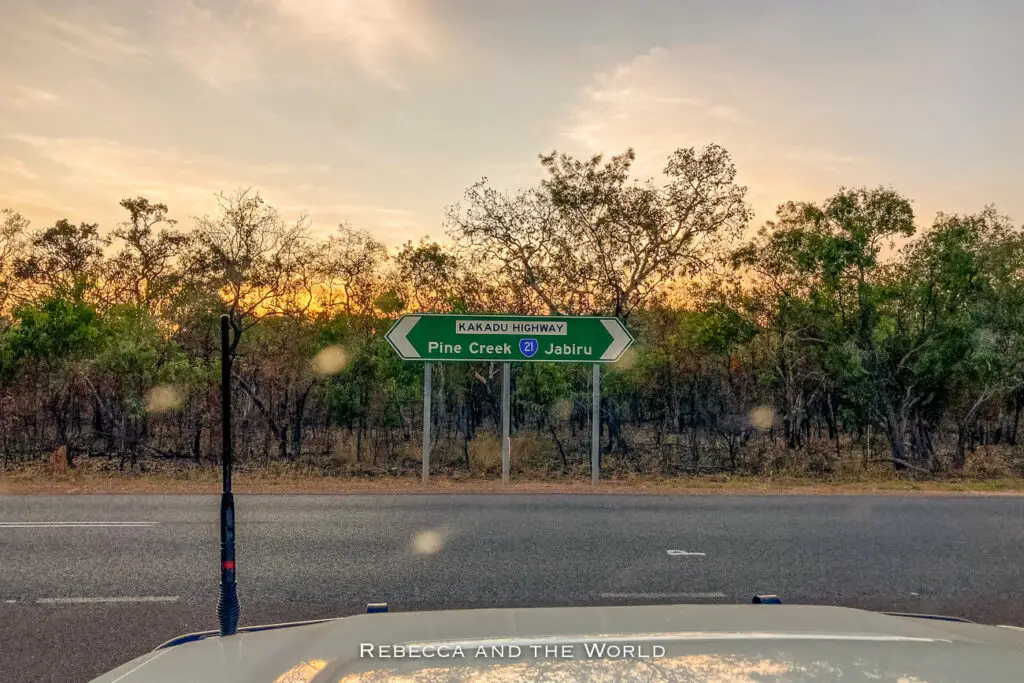
3. Bowali Visitor Centre
As I mentioned earlier, the Bowali Visitor Centre should be your first stop in Kakadu. Pick up a Kakadu Visitor Guide and chat with the rangers about what’s open and closed. They have great tips about the best time to visit certain spots for views and lighting.
If you haven’t bought your Kakadu park pass online, you can buy one here.
There are some interesting exhibitions about the flora and fauna of Kakadu and the Traditional Owners of the area, so spend some time here learning more about the national park
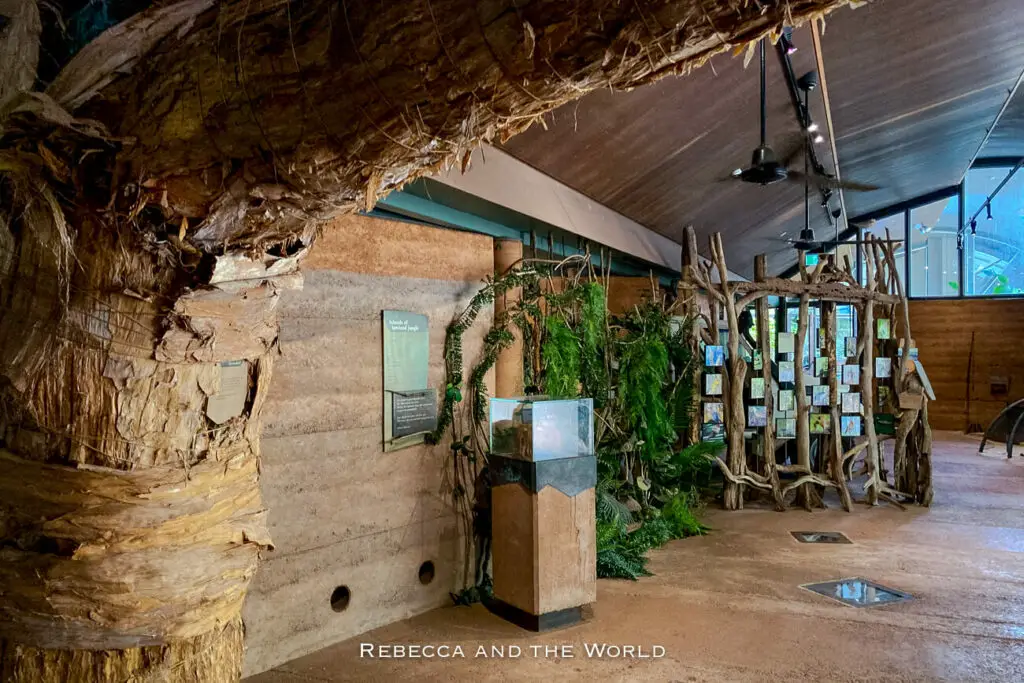
4. Bowali Track
Start your time in Kakadu by tackling a smaller hiking trail. The Bowali Track is a 4-kilometre return that takes you through woodlands. Keep an eye out for birds, wallabies, and maybe even a buffalo.
The trail begins opposite the Mercure Kakadu Crocodile Hotel – a hotel that’s shaped like a croc!
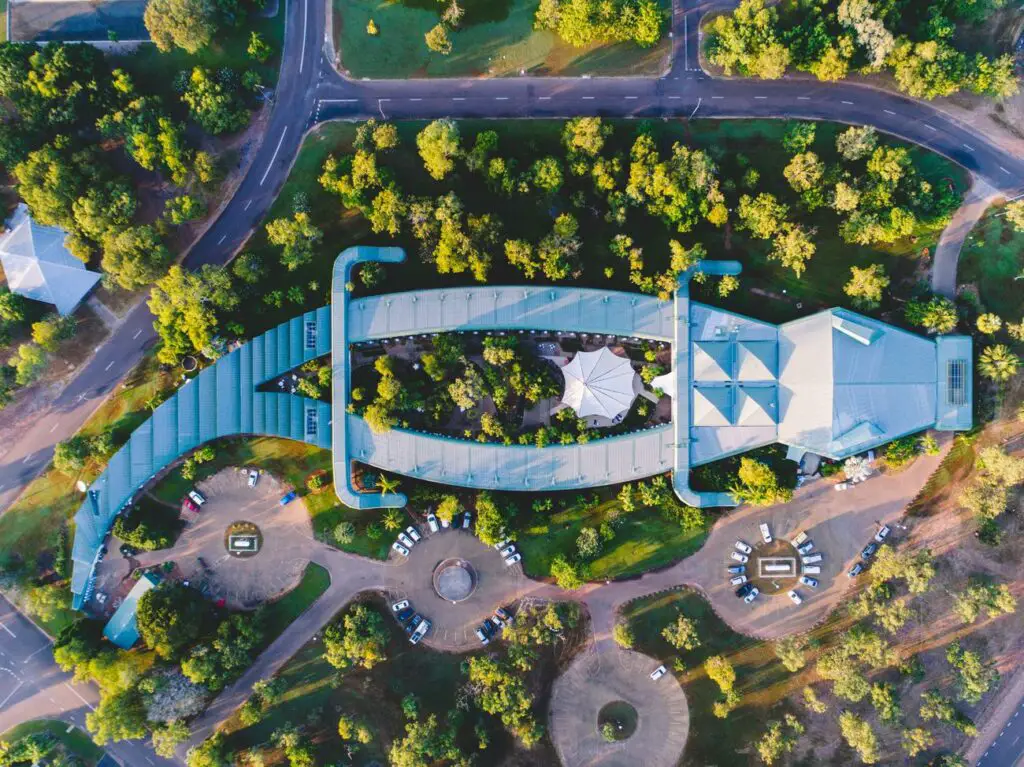
5. Marrawuddi Arts & Culture
Owned by the Mirarr Traditional Owners, the Marrawuddi Arts & Culture centre is a great place to see and buy authentic Indigenous art and crafts from across Kakadu and West Arnhem Land.
You can find everything here from bark paintings to weavings and sculptures, screen-printed T-shirts, jewellery and artworks on canvas.
There’s a studio space here, too, so you can often see artists at work creating intricate and beautiful artworks and designs.
The cafe here has good coffee – and it’s open 7 days.
The East Alligator River is the boundary between Kakadu and Arnhem Land.
One of the absolute highlights of visiting Kakadu is watching the sun set from Ubirr.
At the top of this rock formation, from the Nadab Lookout, you’ll find incredible views stretching out over the vast Kakadu floodplains all the way to Arnhem Land.
Follow the track to the rocky lookout, stopping to see Aboriginal rock art sites. There are several galleries with artworks from different time periods. The oldest paintings here date back thousands of years.
We took a free guided tour led by one of the Indigenous rangers. It was interesting, although our guide seemed far more focused on cracking jokes than sharing useful information. It was worth it, though, as we did learn a few things along the way.
The trail is flat but you’ll need to climb up the rocks to get to the lookout.
This is one of the most popular things to do in Kakadu and it gets really busy here at sunset, so come early to get a good spot. Bring a picnic (no alcohol allowed).
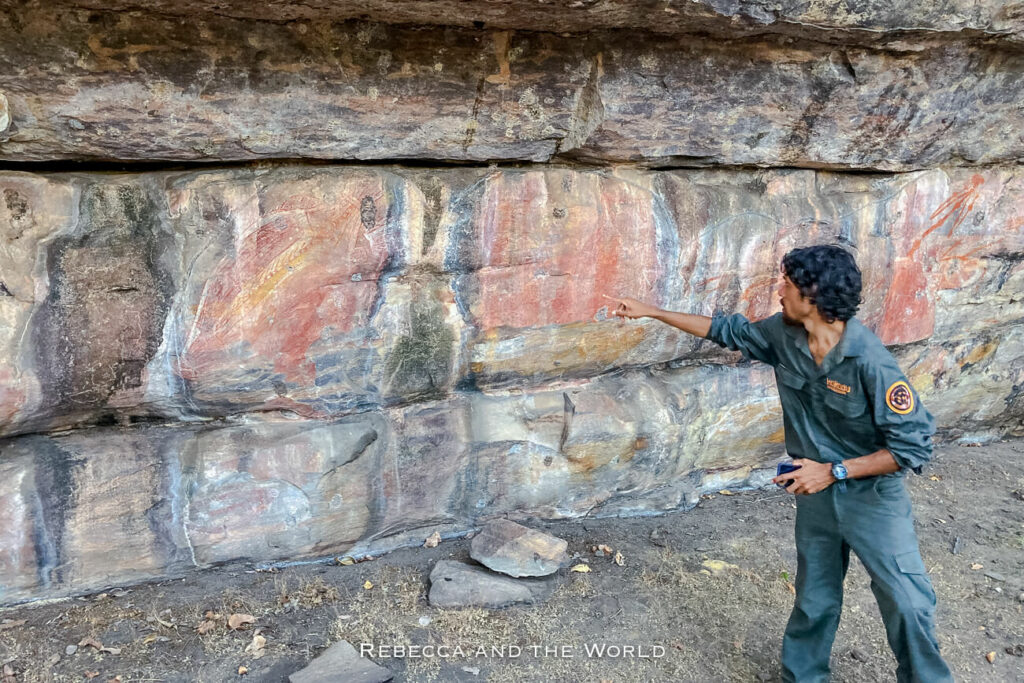
7. Cahills Crossing
If you want to see some crocodiles, Cahills Crossing is the place to be. Located at the East Alligator River, this crossing is a popular spot for fishing and also for watching saltwater crocodiles in their natural habitat. There’s a spacious viewing platform that’s mostly shaded.
This is a tidal river, so time your visit here for high tide when the crocodiles come looking for fish.
I couldn’t believe how many crocs we saw floating down the river or surfacing right by the crossing – and we weren’t even there at high tide.
We saw a few cunning crocs making a beeline when someone fishing reeled in a catch.
If you’re here in the evening during the dry season, there’s an informative talk – led by a ranger – about Kakadu and its resident crocodiles.
Lots of people cross here by car for fun and then turn back. You need a permit if you’re planning on driving further into Arnhem Land.
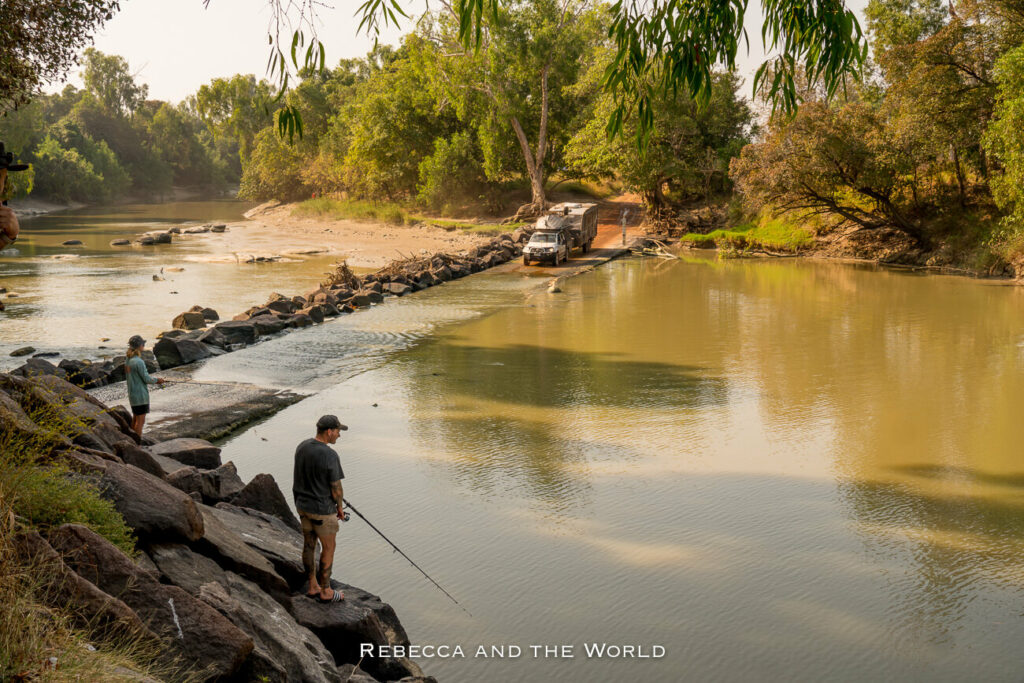
8. Guluyambi Cultural Cruise
Kakadu has a lot to offer when it comes to adventure and exploration, but it’s also a special place for the Traditional Owners of this land. The Guluyambi Cultural Cruise is a must-do experience to gain insight into the Indigenous way of life in Kakadu.
The one-hour cruise takes you along East Alligator River, which separates Kakadu and Arnhem Land, with a knowledgeable guide providing commentary on the history and traditions of the local people.
You’ll even get to go on the Arnhem Land side of the East Alligator River for a hunting and gathering display.
It’s one of the most interesting things to do in Kakadu National Park if you’re interested in learning about culture.
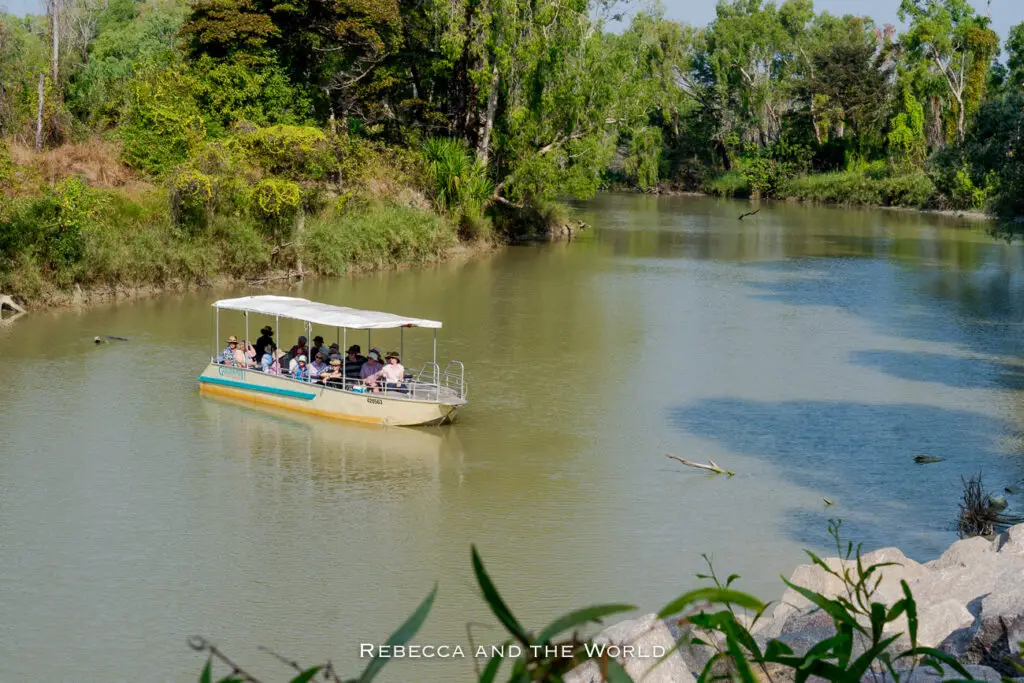
9. Manngarre Rainforest Walk
After you’ve gazed at rock art or spotted crocs, take one of the three loop trails that make up the Manngarre Rainforest Walk.
The trails range from 0.6 kilometres to 1.5 kilometres, and meander through the monsoon rainforest.
10. Injalak Arts Centre
This remote art hub is in West Arnhem Land, just a 25-minute drive from Ubirr. This centre has been around since 1989.
More than 200 artists make and sell beautiful weavings, bark paintings, jewellery, carvings and textiles. Everything here is unique – and ethically sourced and sold.
You will need to arrange permits to visit Gunbalanya (the community where Injalak Arts is located). Information about how to do this is online here .
This region is home to incredible art sites and more stunning lookouts.
11. Burrungkuy (Nourlangie)
This area has a long history of occupation – more than 20,000 years.
Follow the 1.5km return trail – a mix of earth trails and boardwalks – to see rock art painted over thousands of years in shelters used by Aboriginal people.
At Burrungkuy (Nourlangie), you’ll see paintings of people, kangaroos and fish, as well as the famous Lightning Man. Namarrkon (Lightning Man) is depicted as a grasshopper-like creature who makes the powerful lightning and thunderstorms every summer.
You’ll also see Nabulwinjbulwinj, a dangerous spirit who eats women after killing them. You’re asked not to photograph this rock art site.
If you continue on the trail, you’ll reach Gunwarrdehwardeh (also spelt Kunwarddewardde) Lookout. From here you can see for miles over Kakadu National Park, including over to where Namarrkon lives. It’s said that if his home is disturbed, trouble will come.
It’s a really peaceful place and the only noises you’ll hear (other than people) are the sounds of birds and the wind gently swishing the trees.
If you have the energy (and food and water supplies), you can continue from here onto the Barrk Walk, a 12km loop that’s a difficult hike. It loops up with the Nanguluwurr rock art site. We would have loved to do this – but weren’t prepared with enough water.
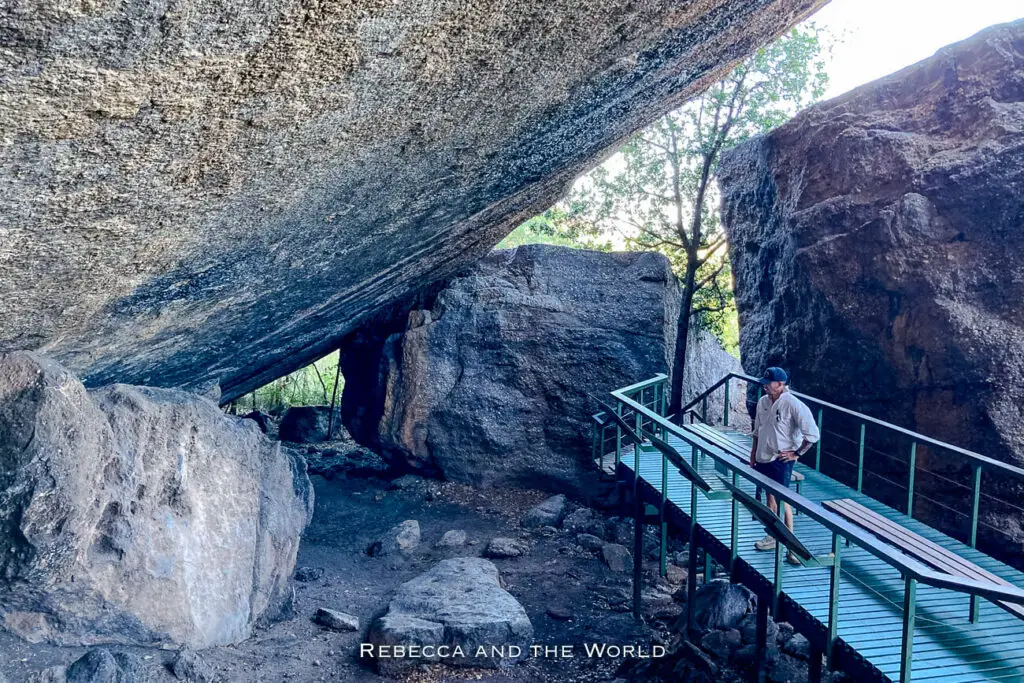
12. Nawurlandja Lookout
Nawurlandja Lookout is at the end of a short walk (600m return). It’s a steep-ish track over the rock face – I was puffing by the time I reached the top!
This lookout has spectacular views over Anbangbang Billabong, Burrungkuy (Nourlangie) and Arnhem Land.
It’s particularly stunning at sunset, with the sky turning orange and pink and purple. We found it was much quieter here than Ubirr at sunset.
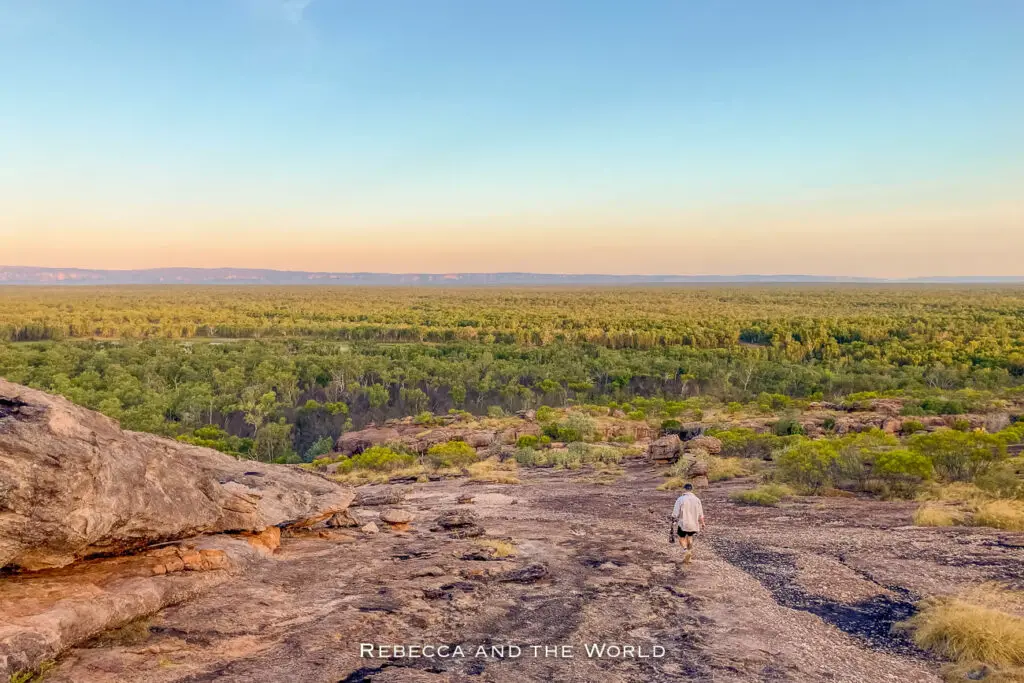
13. Nanguluwurr
This was one of our favourite rock art sites in Kakadu – not only for the fascinating art but also because we had it all to ourselves. I’m not sure if that’s common, but it was pretty incredible to be able to take in the history here without being disturbed by any other visitors.
It’s an easy, 4km return walk to the Nanguluwurr art gallery. It’s here you’ll see the painting of a masted sailing ship – a representation of early contact between Aboriginal people and Europeans.
There are also handprints and the typical animals in x-ray style, all painted in ochre.
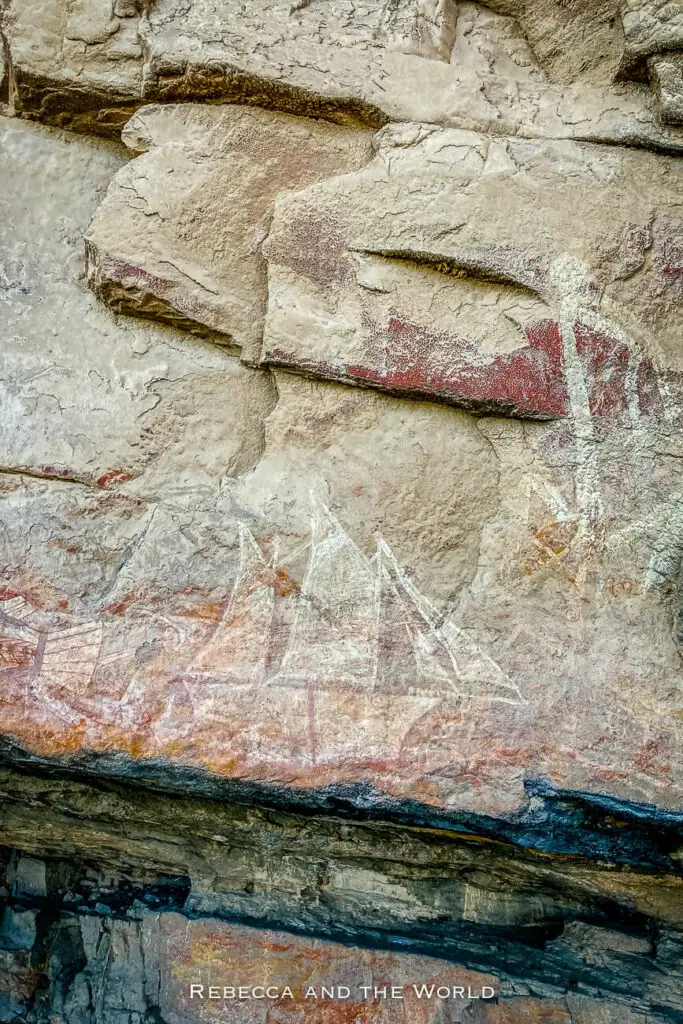
14. Anbangbang Billabong
Not far from Burrungkuy (Nourlangie) is Anbangbang Billabong, a peaceful and picturesque wetland. It’s a great spot to see birdlife (and probably some crocodiles, too – although we didn’t see any here).
Take the 2.8km easy loop around the billabong, passing through paperbark forest and savanna woodlands.
It’s also incredibly peaceful and usually not crowded at all. There are some picnic tables here.
I recommend coming here in the afternoon, either before or after visiting the rock art sites at Burrungkuy (Nourlangie), and then heading up to Nawurlandja Lookout for sunset.
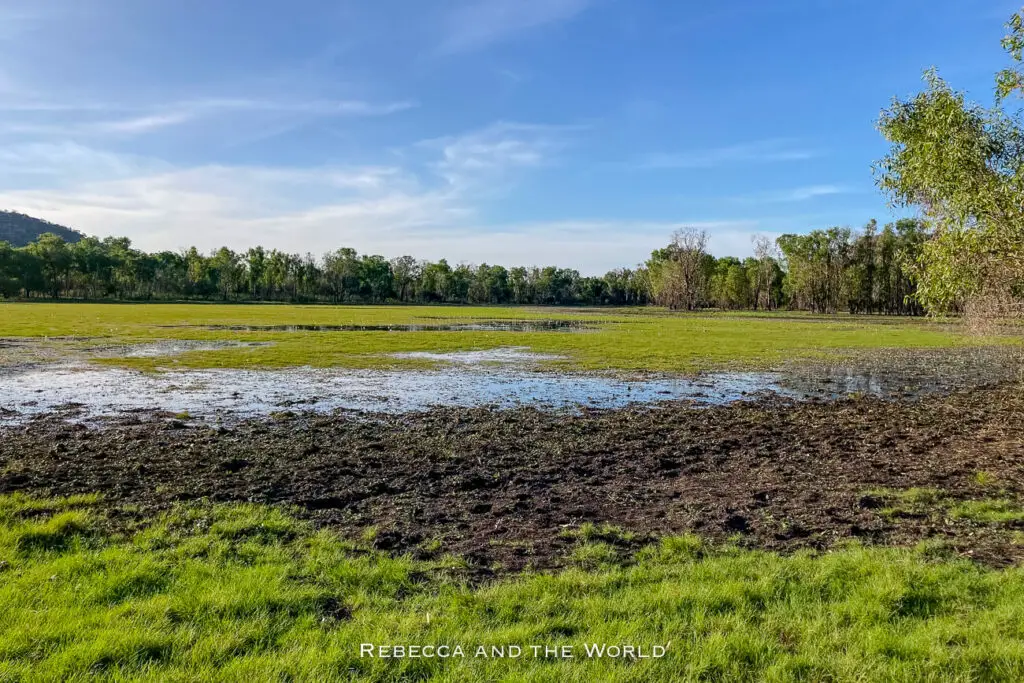
Yellow Water (Ngurrungurrudjba) region
Apart from the Jabiru region, this is the busiest part of Kakadu. Cooinda Lodge has a range of accommodation, so this can be a good base to explore the southern part of the park.
15. Yellow Water Cruise
After exploring the land and learning about its history, it’s time to take a cruise on Yellow Water Billabong (Ngurrungurrudjba) and the South Alligator River.
This 1.5 hour boat ride is one of the must-do experiences in Kakadu National Park. It’s such an informative tour and the scenery is remarkable.
You’ll cruise through beautiful wetlands teeming with wildlife – from birds to saltwater crocodiles. We even spotted several water buffalo roaming the floodplains.
Our guide, Jess, was excellent. She shared so much about the flora and fauna of the region, as well as the cultural significance of Yellow Water Billabong to the Traditional Owners, the Bininj/Mungguy people. We learned some of the traditional names of the animals as well.
Crocs are of course the highlight of this boat trip. I started counting them at the start but gave up after a while – they are everywhere . There are estimated to be more than 10,000 crocodiles in Kakadu.
But there was also a huge focus on fascinating birds. We saw magpie geese, rainbow bee eaters, a few white-bellied sea eagles (the second-largest bird of prey) and the nankeen night heron, which we learned loves to stare at itself in the water.
I recommend taking a sunrise or sunset cruise for the best light and to get out of the heat of the day (although the boats are covered). It was incredible to see the huge orange sun sinking over the water.
Book well in advance – these tours sell out very quickly.
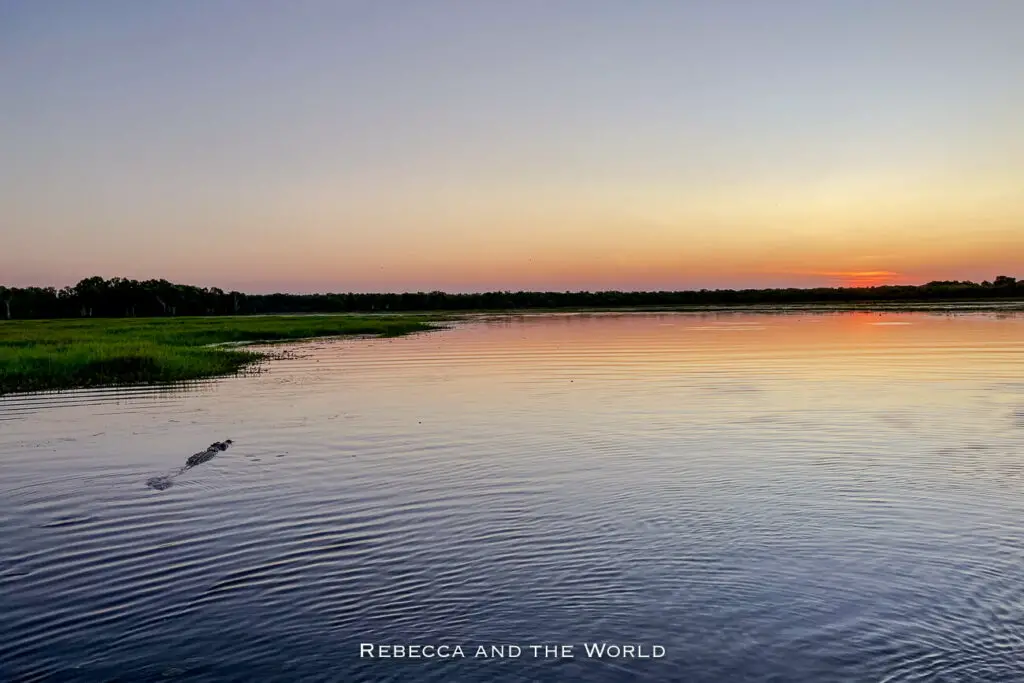
16. Warradjan Aboriginal Cultural Centre
The Warradjan Cultural Centre focuses on the Aboriginal heritage of Kakadu through interactive displays and exhibits.
Warradjan means pig-nosed turtle, and this impressive building is built in the shape of this marine reptile.
There are informative exhibits on the moiety system, the six different seasons of Kakadu, the wildlife of Kakadu and Creation stories.
But there are also displays about the arrival of the balanda (Europeans) and the history of mining in Kakadu, both of which have had devastating impacts.
Top tip! The building is also air-conditioned, so it’s a nice place to escape the heat of the day and learn about the rich culture and history of Kakadu.
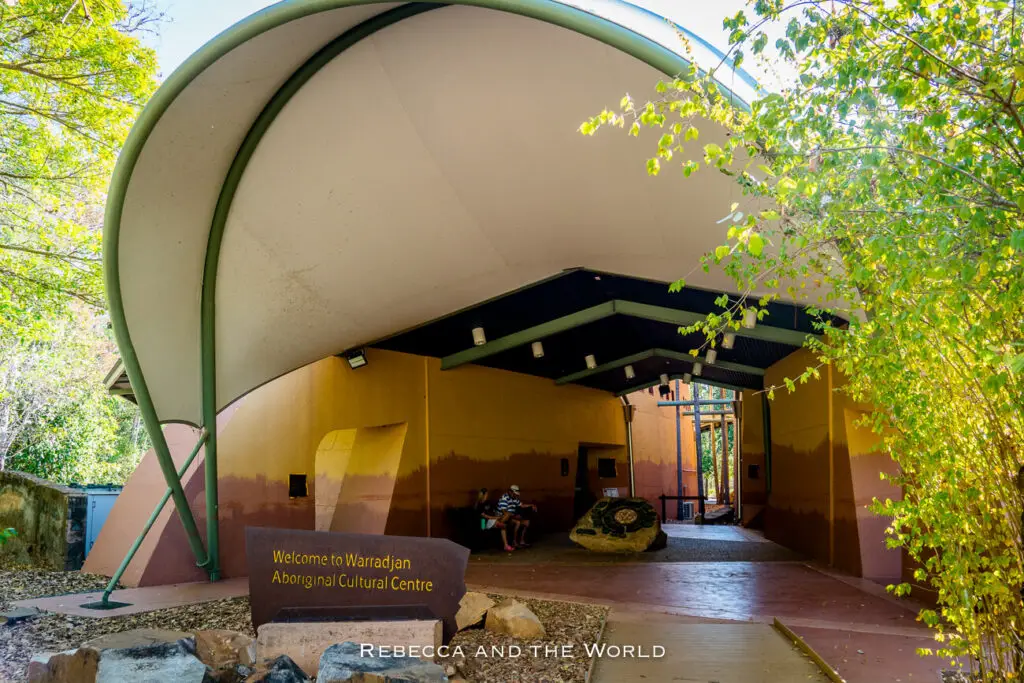
17. Cooinda Lodge
If you’ve been camping in Kakadu (as we were), then Cooinda Lodge will be a welcome stop.
There’s a restaurant here as well as food tents at night, a fuel station, a store selling snacks and drinks – and it’s also the place where you can book tours.
There’s also (very) limited phone reception to catch up – we could only ever get patchy 3G coverage.
18. Take a scenic flight over Kakadu National Park
For a bird’s eye view and a truly breathtaking experience, consider taking a scenic flight over Kakadu National Park.
You’ll be able to see the vastness of the landscape, the winding rivers, and even spot wildlife from above.
This is the best way to see Kakadu in the Wet – when you may not be able to get on the ground but will be able to see waterfalls at their mightiest from above.
There are several companies that offer scenic flights over Kakadu , so shop around and compare prices and itineraries.
Flights depart from Cooinda and Jabiru.
Jim Jim / Twin Falls region
The highlight of Kakadu are these two waterfalls – Jim Jim and Twin Falls Gorge.
19. Jim Jim Falls
Jim Jim Falls is a stunning waterfall located in the southern region of Kakadu National Park.
The falls can only be accessed by 4WD vehicles and require a short hike to reach. But the effort is well worth it once you see the crystal clear water cascading over the red cliffs.
During the dry season, the waterfall dries up from about July, but you can still hike to the plunge pool at the bottom of the cliffs. Salties have been known to appear here, so keep an eye out – and check with the rangers before you take a dip!
The dirt road to Jim Jim Falls can be pretty hairy. Friends we met on our trip had their back window smashed by rocks, so make sure to cover it with cardboard or a yoga mat, just in case!
Don’t have a 4WD? Take a 4WD day tour .
During the wet season, the falls can become impassable and dangerous due to heavy rainfall and flooding. So your best bet at this time of year is to see the falls via a scenic flight.
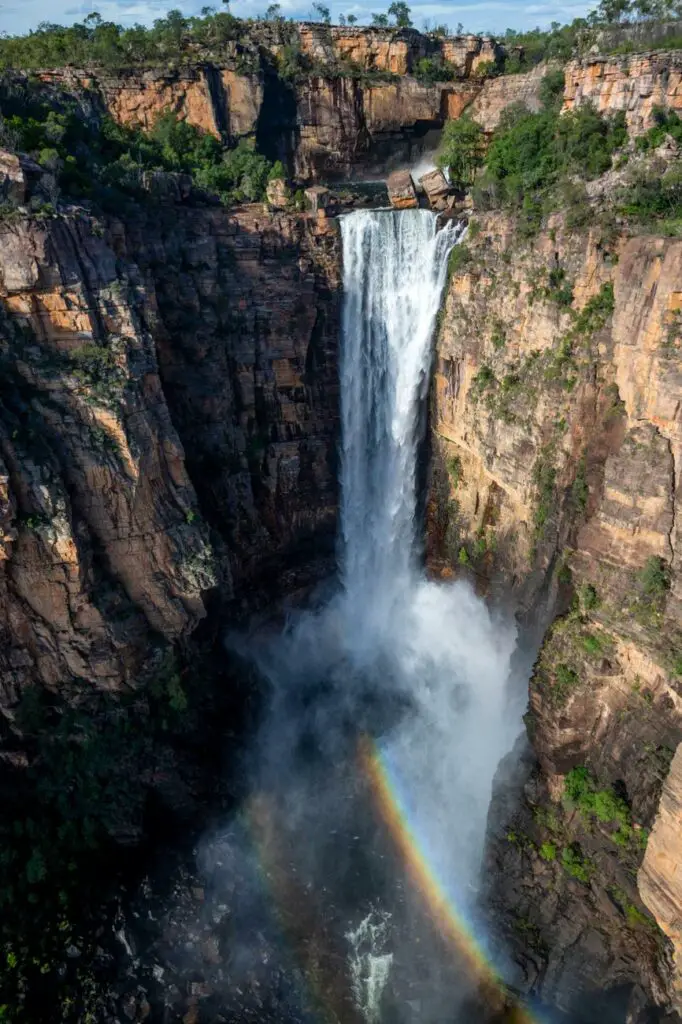
20. Twin Falls
Twin Falls is another must-see attraction in the Jim Jim / Twin Falls region of Kakadu National Park.
This spectacular 150-metre-high waterfall is surrounded by towering cliffs. The waterfall is just a trickle during the dry season, but it’s still worth a walk – the scenery is incredible.
While the walk to the base of the falls is currently closed for an upgrade, you can hike along the top along the Twin Falls plateau walk. This 6km return trail has amazing views down into the gorge and the falls.
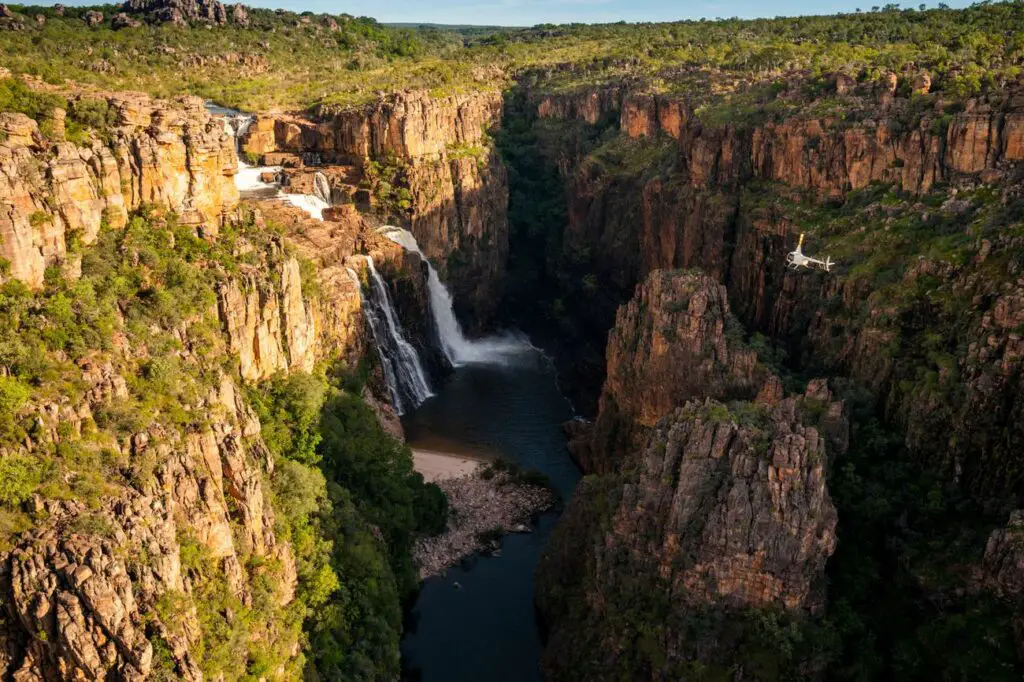
The southernmost region of the national park is easily accessible from the Stuart Highway and is where you’ll find some of Kakadu’s best swimming holes.
21. Maguk Falls
Maguk Falls is a stunning swimming spot – my favourite place in Kakadu National Park.
While the waterfall isn’t as high as Jim Jim or Twin Falls, this place is still spectacular. The water cascades over the rocks and into a deep plunge pool, a much-needed escape from the heat.
To reach Maguk Falls, you’ll need to take a short 1-kilometre hike through lush rainforest, which then gives way to rocks and boulders – watch your step in this part!
Once at the falls, you can swim in the crystal clear waters or relax on the rocky bank. It’s so easy to while away a few hours here. Bring a pool noodle or something inflatable to laze about on.
The road to Maguk is an unsealed, 4WD track, but we saw 2WD cars tackling it easily in the dry season.
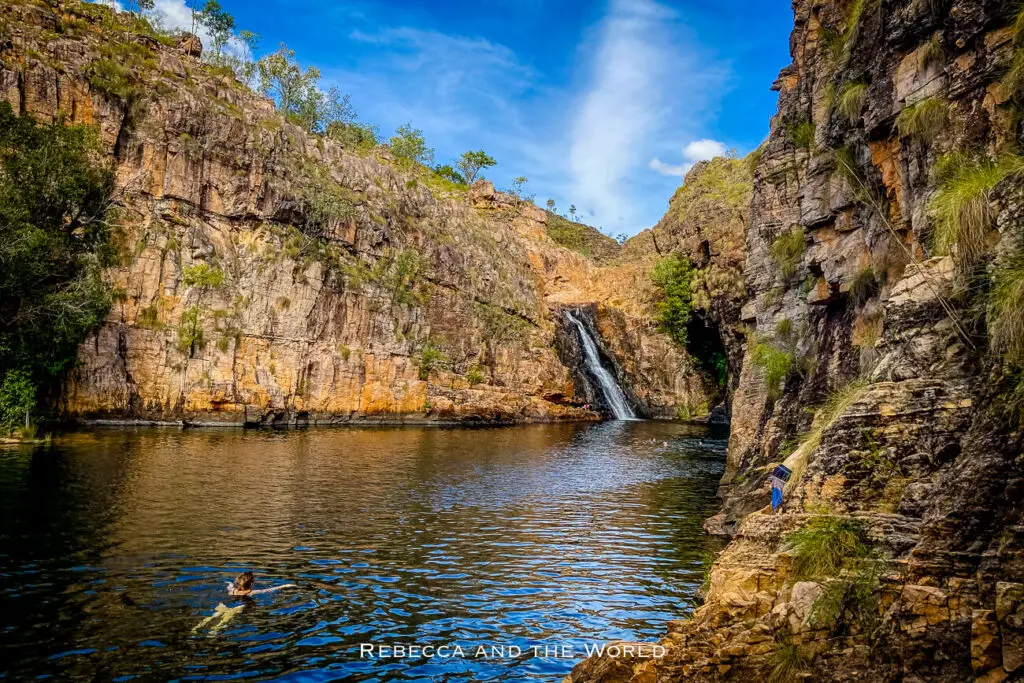
22. Motor Car Falls
Head to Motor Car Falls, one of the lesser visited spots in Kakadu.
The 7.5km return hike is one of the three Yurmikmik Walks.
Motor Car Falls is best during the wet season – although it can close due to flooding in the peak of the season, so you need to time your visit right.
However, it’s still worth visiting during the dry season. While the waterfall won’t be impressive (and may not be flowing at all), the walk is a chance to spot birds and wildlife.
23. Gunlom Falls
Gunlom Falls is where you’ll get the ultimate Instagram shot.
The walk to the falls takes you through lush monsoon forests, before opening up to a beautiful viewpoint over the valley below.
The falls themselves are a series of natural rock pools, perfect for swimming and cooling off on a hot day.
But the real highlight at Gunlom Falls is the infinity pool at the top of the falls. This natural infinity pool overlooks the South Alligator River and offers unbeatable views for a truly unique swimming experience.
Unfortunately, Gunlom Falls was closed when we visited – and has been for some time. So, check the Kakadu status page for updates.
View this post on Instagram A post shared by 👣Hike Australia👣 (@hike_australia)
Kakadu itinerary ideas
So, you’ve now seen that there’s a LOT to do in Kakadu. To help you make the most of your time here, I’ve pulled together a couple of suggested itineraries. These are Kakadu self-drive itinerary ideas, as I’ve assumed you’re visiting independently and not on a tour.
3 days in Kakadu National Park
Three days will give you a good taster of Kakadu National Park.
- Drive from Darwin to Jabiru.
- Stop by Bowali Visitor Centre to pick up a Kakadu Visitor Guide and chat with the rangers.
- Head to Cahills Crossing for a chance to spot crocodiles and other wildlife.
- Catch the sunset at Ubirr Rock, where you can see ancient rock art and enjoy panoramic views of the park.
Stay: Mercure Kakadu Crocodile Hotel , hotel/camping at Aurora Kakadu Lodge or Malabanjbanjdju or Burdulba campgrounds (Merl campground is the closest to Ubirr – but it’s known for having a LOT of mosquitos).
- Visit Burrungkuy (Nourlangie) to see ancient rock art and learn about the local Indigenous history.
- See more rock art at the Nanguluwurr art gallery.
- Head up the Nawurlandja Lookout for stunning views or take a stroll around Anbangbang Billabong.
- Take a sunset cruise on Yellow Water Billabong to see the diverse birdlife and spot saltwater crocodiles.
Stay: Cooinda Lodge or camp at Mardukal campground .
- Visit the Warradjan Cultural Centre to learn about Indigenous culture and history.
- End your trip to Kakadu at one of the following swimming holes for a refreshing swim: Maguk, Gunlom (if it’s open) or Motor Car Falls.
- Head back to Darwin.
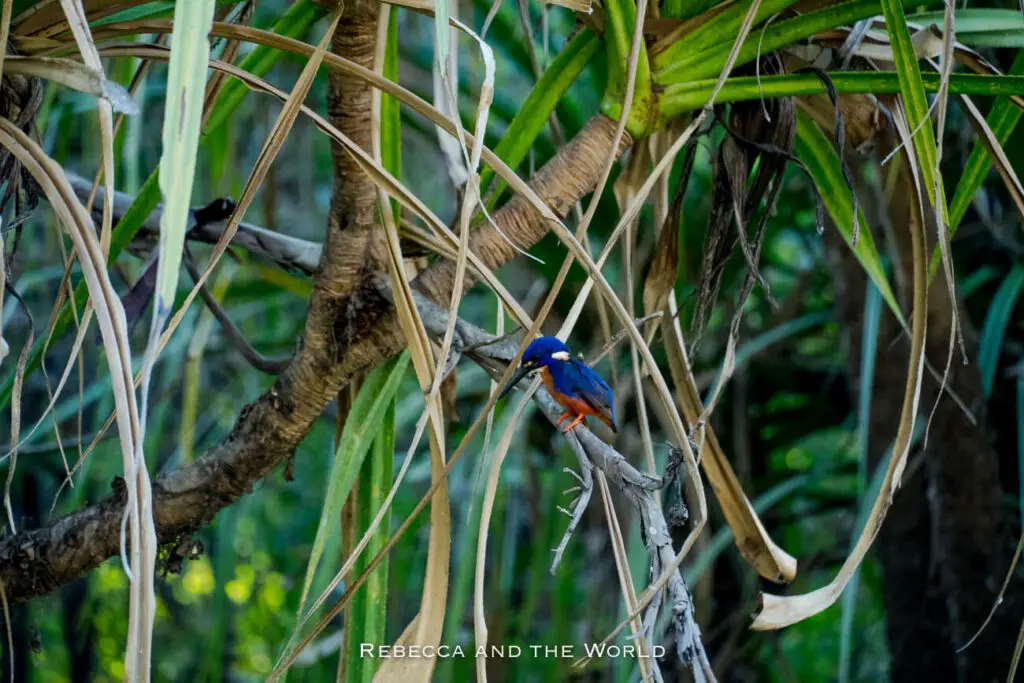
5 days in Kakadu
Five days is a great amount of time to explore more of Kakadu National Park.
- Head to Cahills Crossing to spot crocodiles.
- Catch the sunset at Ubirr Rock, where you can see ancient rock art and enjoy panoramic views over the floodplains all the way to Arnhem Land.
Stay: Mercure Kakadu Crocodile Hotel or camping at Aurora Kakadu Lodge or Malabanjbanjdju or Burdulba campgrounds (Merl campground is the closest to Ubirr – but it’s known for having a LOT of mosquitos).
- Take a Guluyambi Cultural Cruise on the East Alligator River to see more wildlife and learn about the local Aboriginal culture.
- Head out to Injalak Arts to see incredible Aboriginal art (arrange your permit ahead of time).
- Head up to Nawurlandja Lookout for stunning sunset views.
- Visit the Warradjan Cultural Centre to learn about the local Indigenous culture and history.
- Explore the Jim Jim and Twin Falls area, taking in the impressive waterfalls and stunning landscapes.
Stay: Cooinda Lodge or Karnamarr Campground .
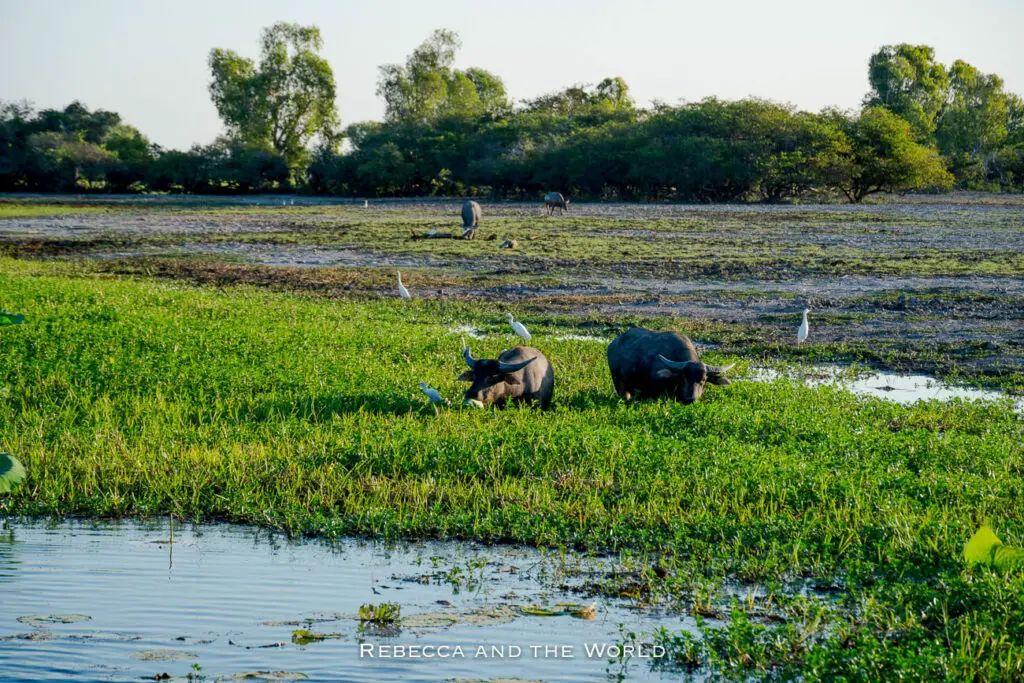
What to pack for Kakadu
Here are a few things you should bring on your visit.
- Kakadu Park Pass
- Hiking boots or sneakers
- Tevas or other water shoes – especially useful for the Maguk hike
- Water bladder (I prefer a water bladder to a bottle when I’m hiking)
- Sunscreen (at least SPF50+)
- Insect repellent
- Hat and sunglasses
- Swimming gear
- Pool noodles or inflatable – a must for the swimming holes!
- Food, snacks and plenty of water
How to get to Kakadu National Park
Kakadu National Park is located in the Northern Territory of Australia, approximately 150km southeast of Darwin. There are a few ways to get there:
- Self-drive – this is the most popular option and gives you the flexibility to explore at your own pace. Rent a car in Darwin (or in Katherine ) and make the 1.5 hour drive to the park entrance (it’ll take you about 2.5 hours to get to the Bowali Visitor Centre). Avoid driving to Kakadu from Darwin in the dark – there are lots of animals, including wild buffalo, that cause hazards.
- You can also visit Kakadu on an Adelaide to Darwin road trip or a Top End road trip !
- Organised tour – there are several companies offering day trips or multi-day tours to Kakadu from Darwin.
Darwin to Kakadu tours
There are a few Darwin to Kakadu day trip tour options . Most include pick up and drop off from your accommodation in Darwin, as well as lunch and knowledgeable guides.
Best time to visit Kakadu
The best time to visit Kakadu National Park is during the dry season, which runs from April/May to October. This is when the weather is cooler and there’s less chance of heavy rains or floods. Some parts of the park may still be closed earlier in the season, so July/August/September are good months to visit.
However, Kakadu during the wet season (October to April) can be spectacular. The monsoonal rains mean the waterfalls are at their thundering best and animals are on the move. Just be aware that some areas of the park may be closed during this time due to flooding.
The Bininj/Mungguy actually recognise six different seasons , and have used their knowledge over thousands of years to live in harmony with the land.
Keep in mind that during the dry season is when burn-offs can take place. This is an important part of caring for the land. There were burn-offs when we were there, but most of these happened overnight so we only had to deal with a bit of smoke.
Time your trip with the Taste of Kakadu festival , which celebrates bush food. Over a weekend, you can experience traditional bush tucker, cooking demonstrations, music and cultural performances. In 2024, the festival will be 24-26 May.
The Kakadu Dird (full moon) Feast also looks fabulous. A four-course meal under the stars celebrates bush tucker and the six seasons of Kakadu.
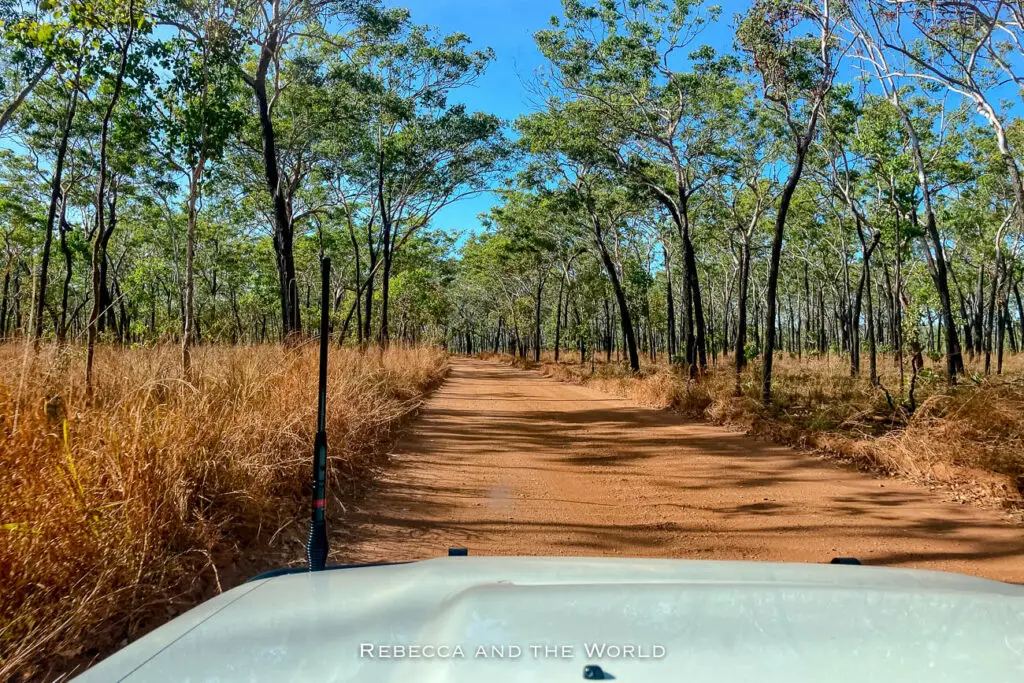
Where to stay in Kakadu
Here are options for accommodation in Kakadu National Park – I’ve included places to stay across the park.
Camping in Kakadu
I highly recommend camping in Kakadu – there’s nothing quite like the tranquility of the evening, when the only sounds are birds and insects, and the occasional bellow of a buffalo.
There are a number of campgrounds located throughout the park. National park-run campsites come in three types: managed sites (with showers, toilets and an on-site manager), unmanaged sites (pit toilets, pay to an honesty box) and free sites (no amenities). You need to bring your own drinking water to all types of campsites.
During our time in Kakadu, we stayed at Djarridjin, Mardukal and Maguk campgrounds. A full list of campgrounds can be found online .
There are also campsites at some of the hotels, including Cooinda Lodge and Aurora Kakadu Lodge .
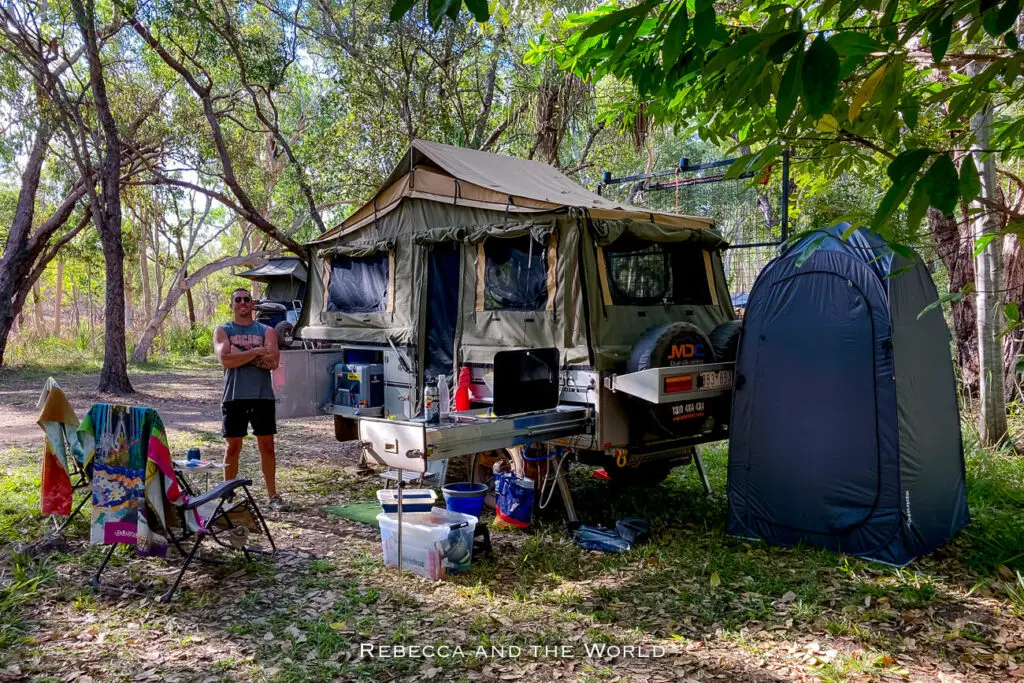
Kakadu hotels
Don’t have camping gear or want a bit of luxury? No worries – there are several hotels throughout the park.
The majority of hotels are in Jabiru:
- Mercure Kakadu Crocodile Hotel – in the shape of a croc, this full-service hotel has a pool that you’ll need at the end of a long day | Check prices online on Booking.com and Expedia
- Aurora Kakadu Lodge – has self-contained cabins (with AC) and lodge rooms, as well as powered and unpowered caravan and campsites. There’s a great pool and a bar/restaurant | Check rates online on Booking.com and Expedia
- Anbinik Kakadu Resort – has lovely suites and cabins, as well as “bush bungalows”, all of which are surrounded by lush vegetation | Check rates online
Cooinda Lodge Kakadu is further south. The resort has both hotel rooms and glamping tents, as well as access to a restaurant/bar, swimming pool, petrol station, shop and tours. | Check rates online on Booking.com or Expedia
Where to eat in Kakadu
Bring plenty of snacks with you – and if you’re camping, bring all your food and water as the stores at Jabiru and Cooinda Lodge are unsurprisingly pricier than supermarkets in Darwin.
The Manjmukmuk Restaurant and Bar at the Mercure Kakadu Crocodile Hotel in Jabiru has the usual hotel fare – but you can also try crocodile, barramundi or even buffalo curry.
At Cooinda Lodge, Barra Bar and Mimi’s Restaurant have dine-in and takeaway options. We had some fish and chips there and they were fine, if a little overprices (to be expected). At night during the dry season, a few food tents open and sell smoked meats and fish and chips to enjoy alongside the live music.
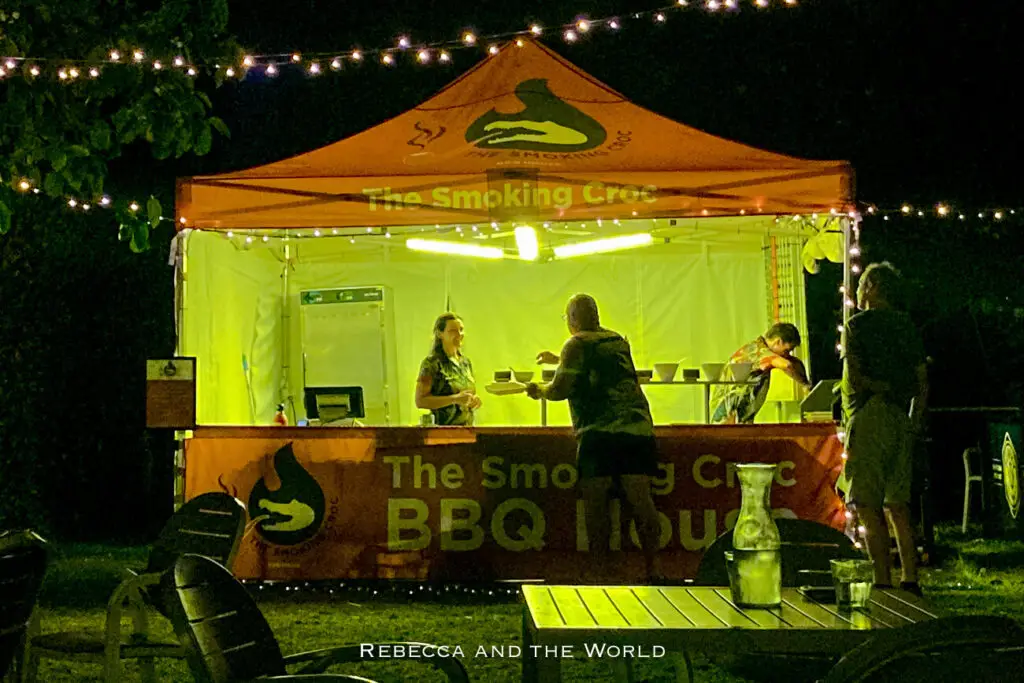
Wrap up: Things to do in Kakadu
Kakadu is one of the most stunning places to visit in the Northern Territory – and Australia. But it is huge, so you really do need to plan your trip there. Depending on how much time you have, pick a few areas and plan your Kakadu activities around those.
And while you may have a long to-do list while you’re here, make some time to simply relax in nature and appreciate the beauty of this World Heritage Site. It truly is a magical place.
What to do in Kakadu: FAQs
How many days do i need in kakadu national park.
At least 3 days are needed to see the highlights of Kakadu National Park. But ideally you should plan for a week to fully explore the area.
Are there crocodiles in Kakadu National Park?
Yes! There are more than 10,000 estuarine (saltwater) crocodiles in Kakadu. But salties can also be found in fresh water (something I learned while I was in Kakadu) so don’t think that there are no crocs there if you’re swimming in fresh water. Stay away from water unless a ranger has advised it’s okay to swim there. While rangers are always looking out for and removing crocodiles, you do enter the water at your own risk.
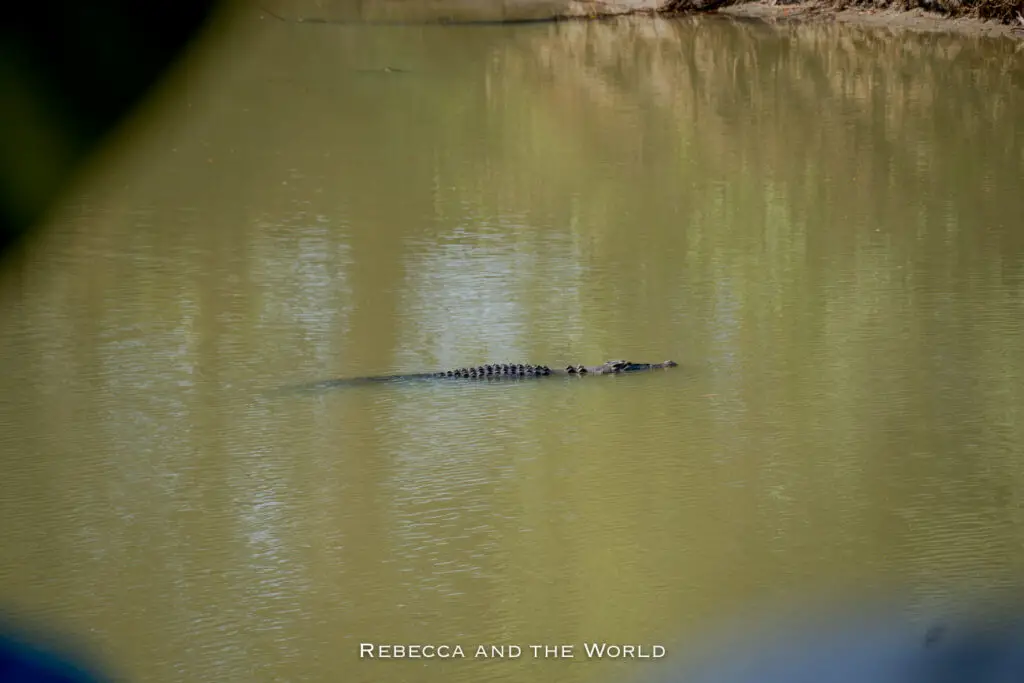
Do I need a 4WD for Kakadu National Park?
A 4WD isn’t necessary for most of the main attractions in Kakadu National Park. You can see most of the main sites I’ve listed in this article with a 2WD. However, there are some areas where you’ll need 4WD, like Jim Jim Falls and Maguk. If you’ve rented a 2WD , check with your rental car before driving on any 4WD tracks – some rental companies won’t let you take 2WD cars off road.
Can I visit Kakadu in the wet season?
Yes, you can visit Kakadu National Park in the wet season (October to April). In fact, it can be a stunning time to visit, when the waterfalls are at their peak and the rivers have flooded. Just be aware that some roads and sites may be closed due to flooding, and swimming may be restricted due to increased risk of crocodile encounters. Check the Kakadu website for closures.
Is Kakadu better than Litchfield National Park?
It’s difficult to compare Kakadu and Litchfield National Parks , as they’re both so different! While Kakadu is known for its vast wilderness, croc spotting and Aboriginal culture, Litchfield is the ultimate stop for stunning waterfalls and swimming holes. If you have time, it’s worth visiting both parks. Plus, with only about two hours’ drive between the two parks, it’s easy to do so. Other notable national parks in the area include Nitmiluk (Katherine Gorge) and Gregory National Park.
Did you find this article helpful? Consider buying me a coffee as a way to say thanks!
Have you been to Kakadu National Park?
Related posts
Before you leave… you might like these other Australia travel articles:
- The ultimate guide to Litchfield National Park
- The best things to do in Darwin, NT
- The ultimate guide to Nitmiluk National Park
- How to plan an epic Adelaide to Darwin road trip
- The best things to do in the NT
- The ultimate Top End road trip
- How to spend a few days in Alice Springs
- How to plan an epic Central Australia road trip
AUSTRALIA TRIP ESSENTIALS
- Book your flight to Australia online with Skyscanner . I like this site because it shows me which dates are cheaper.
- Find a great hotel in Australia. Check prices on Booking.com and Expedia online.
- Check out the huge range of day tours throughout Australia on GetYourGuide or Viator . There’s something for everyone.
- A copy of the Lonely Planet guide to Australia will be handy.
- One thing I always purchase is travel insurance ! Travel Insurance Master allows you to compare across multiple policy providers, while SafetyWing is great for long-term travellers and digital nomads.
- Pack sunscreen (look for SPF50 or higher), a hat and sunglasses because the sun is hot!
PIN IT FOR LATER: VISIT KAKADU NATIONAL PARK
Save this guide to Kakadu National Park to Pinterest for later.
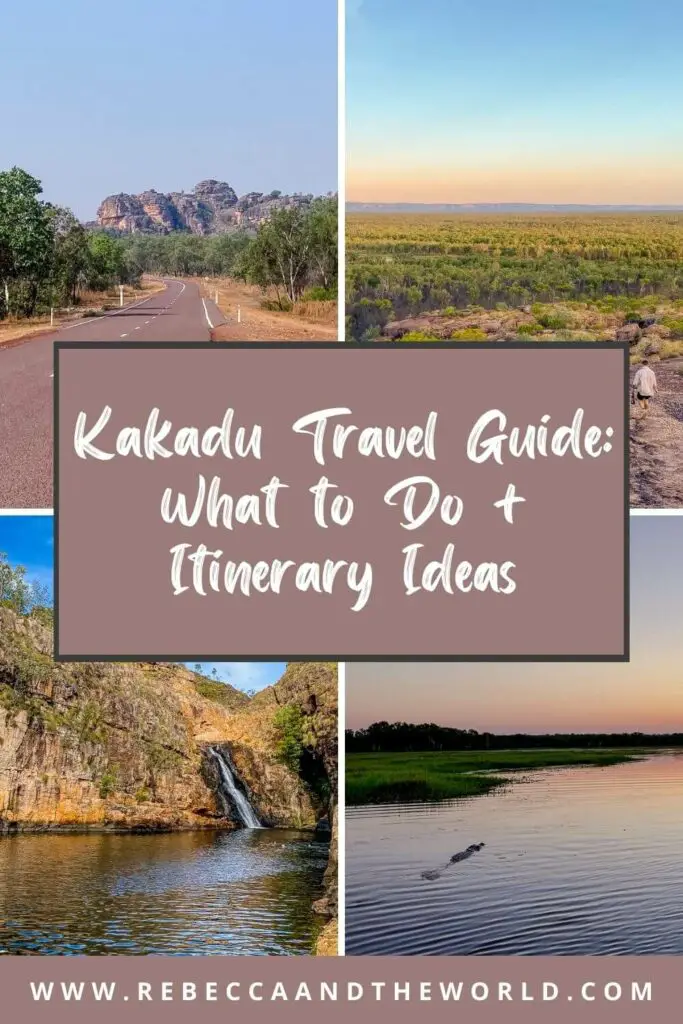
About REBECCA
I'm a travel junkie who started dreaming about seeing the world from a very young age. I've visited more than 40 countries and have a Master of International Sustainable Tourism Management. A former expat, I've lived in Australia, Papua New Guinea, Argentina and the United States. I share travel resources, tips and stories based on my personal experiences, and my goal is to make travel planning just that bit easier.
Leave a Comment Cancel reply
MORE INFORMATION
ABOUT WORK WITH ME CONTACT PUBLISHED WORK
AFFILIATE DISCLOSURE
AS AN AMAZON ASSOCIATE I EARN FROM QUALIFYING PURCHASES
© 2024 REBECCA AND THE WORLD
Privacy Policy
I ACKNOWLEDGE THE WURUNDJERI AND BOON WURRUNG PEOPLE OF THE KULIN NATION AS THE TRADITIONAL OWNERS OF THE LANDS AND WATERWAYS OF THE AREA I LIVE ON. I PAY MY RESPECTS TO ELDERS PAST AND PRESENT AND CELEBRATE THE STORIES, CULTURE AND TRADITIONS OF ALL ABORIGINAL AND TORRES STRAIT ISLANDER PEOPLE ACROSS AUSTRALIA.

- Privacy Overview
- Strictly Necessary Cookies
This website uses cookies so that we can provide you with the best user experience possible. Cookie information is stored in your browser and performs functions such as recognising you when you return to our website and helping our team to understand which sections of the website you find most interesting and useful.
Strictly Necessary Cookie should be enabled at all times so that we can save your preferences for cookie settings.
If you disable this cookie, we will not be able to save your preferences. This means that every time you visit this website you will need to enable or disable cookies again.
This website uses modern construction techniques, which may not render correctly in your old browser. We recommend updating your browser for the best online experience.
Visit browsehappy.com to help you select an upgrade.
- 9 Incredible Experiences in Kakadu
If you ever need an endorsement of why you should visit Kakadu, the story of intrepid UK travellers Cat and Joe should convince you. Their blog walkmyworld.com.au contains incredible adventures from around the world, but Kakadu certainly stood out for them as a must-do adventure destination. Following is an account of their experience in our beautiful backyard.
How many people’s first glimpse of Australia was Crocodile Dundee?! It was for us – a funny insight into a completely different world. For those who don’t know, Crocodile Dundee was filmed largely in the ‘Top End’, two hours from Darwin at the northern most point of the Northern Territory. This pristine wilderness is only a stone’s throw from Indonesia, and packs in many of the experiences that foreigners see as synonymous with Australia. Rugged landscape, indigenous art and culture and plenty of wildlife watching opportunities. While much has changed over the years the scenery is still as jaw dropping as it was in the movie.
Kakadu National Park is the jewel in the crown of the Top End, and should be on any nature lovers’ itinerary. Access to the national park has become much easier since the film aired over 30 years ago and it’s now one of Australia’s top places to visit.
Don’t miss these top Kakadu experiences:
Cruising Yellow Water
We loved this boat trip so much that we did it twice. Lucky for us when you’ve paid for the first one all subsequent cruises are $25pp. The sunrise trip is really beautiful and the best time to see the many bird species.
You’ll definitely spot the odd croc but the focus of the tour is the birdlife. You will stop at a good vantage point to watch the sunrise and it’s amazing how still and calm the water is. It’s a very special experience. You might also spot brumbies (wild horses) and buffalo (which are actually a pest) but we weren’t so lucky.
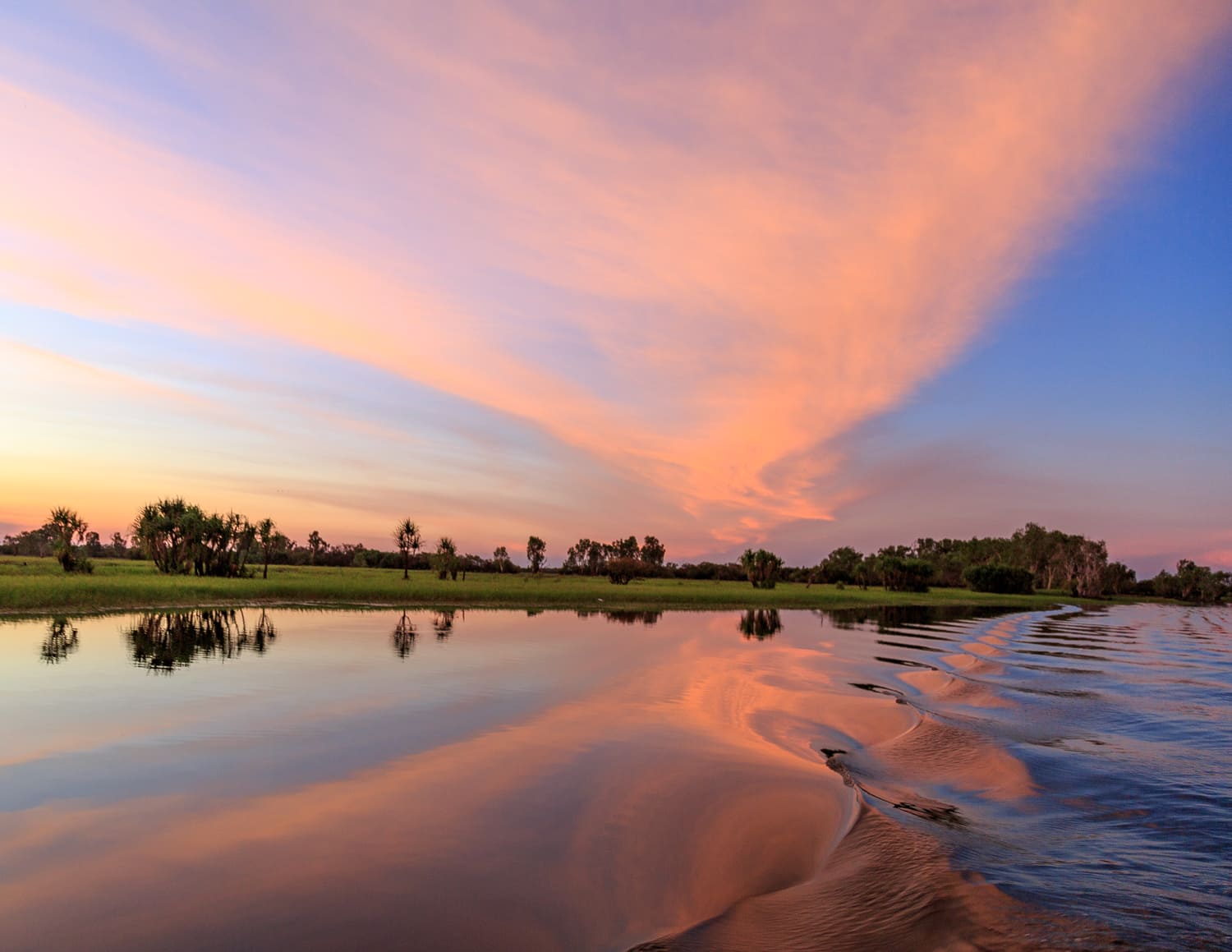
If you have the chance we’d also recommend going at sunset. The crocs are far more active, we saw huge numbers. Keep an eye out for alpha male Maxi who usurped his predecessor by chomping on his head, eeek. The sunset was also one of the most spectacular we saw on the whole trip. The trip will finish before all the colour has but you can stay on the bridge until the last rays… or until you can stand the mosquitoes no more!
Read more: The best time to visit Darwin, Kakadu & Litchfield
Seeing some of the oldest rock art in the world at Ubirr and Nourlangie
If you want to see ancient aboriginal rock art, then head straight to Kakadu. At Ubirr and Nourlangie you’ll find some of the best preserved and most vibrant aboriginal rock art in the whole of Australia.
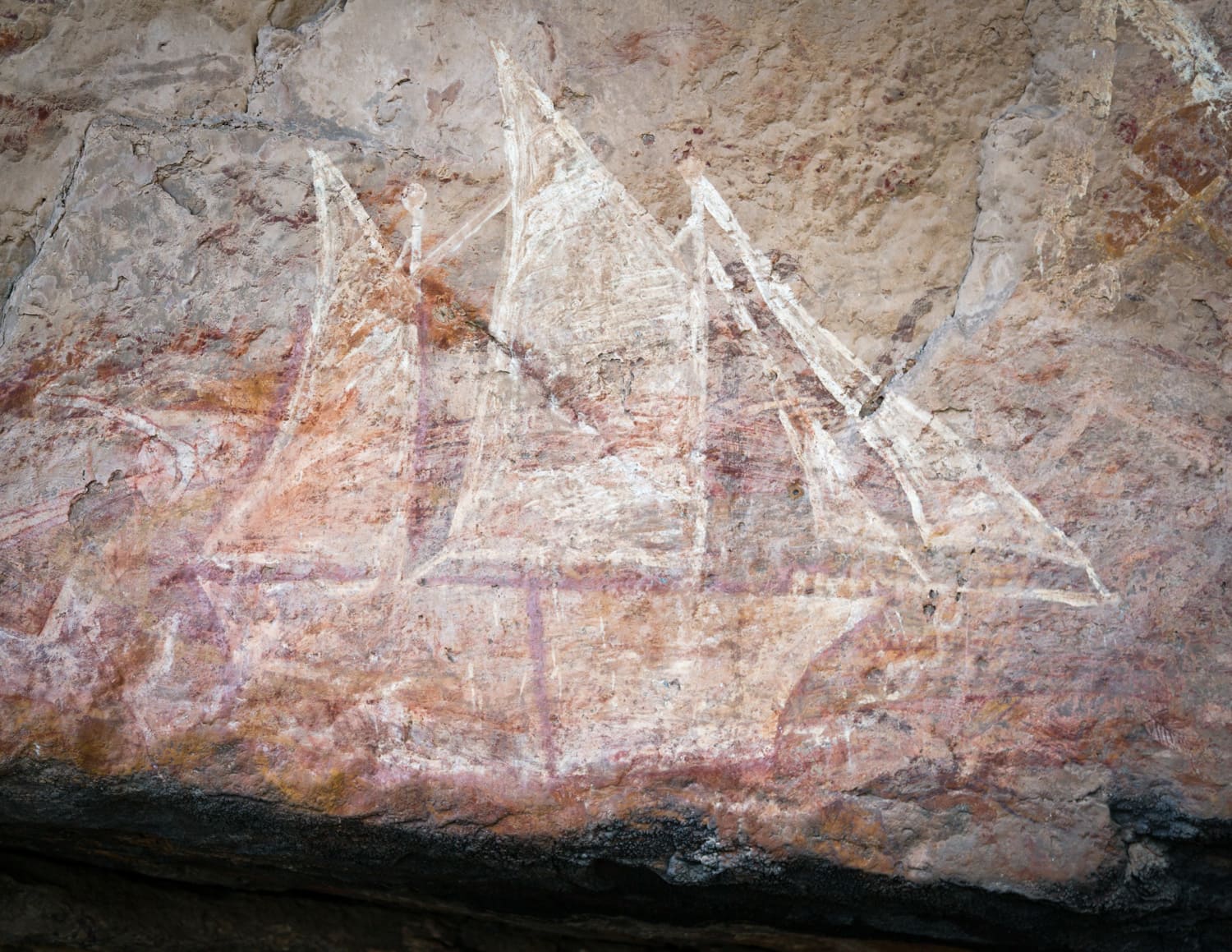
The best things to do in Kakadu: Ubirr
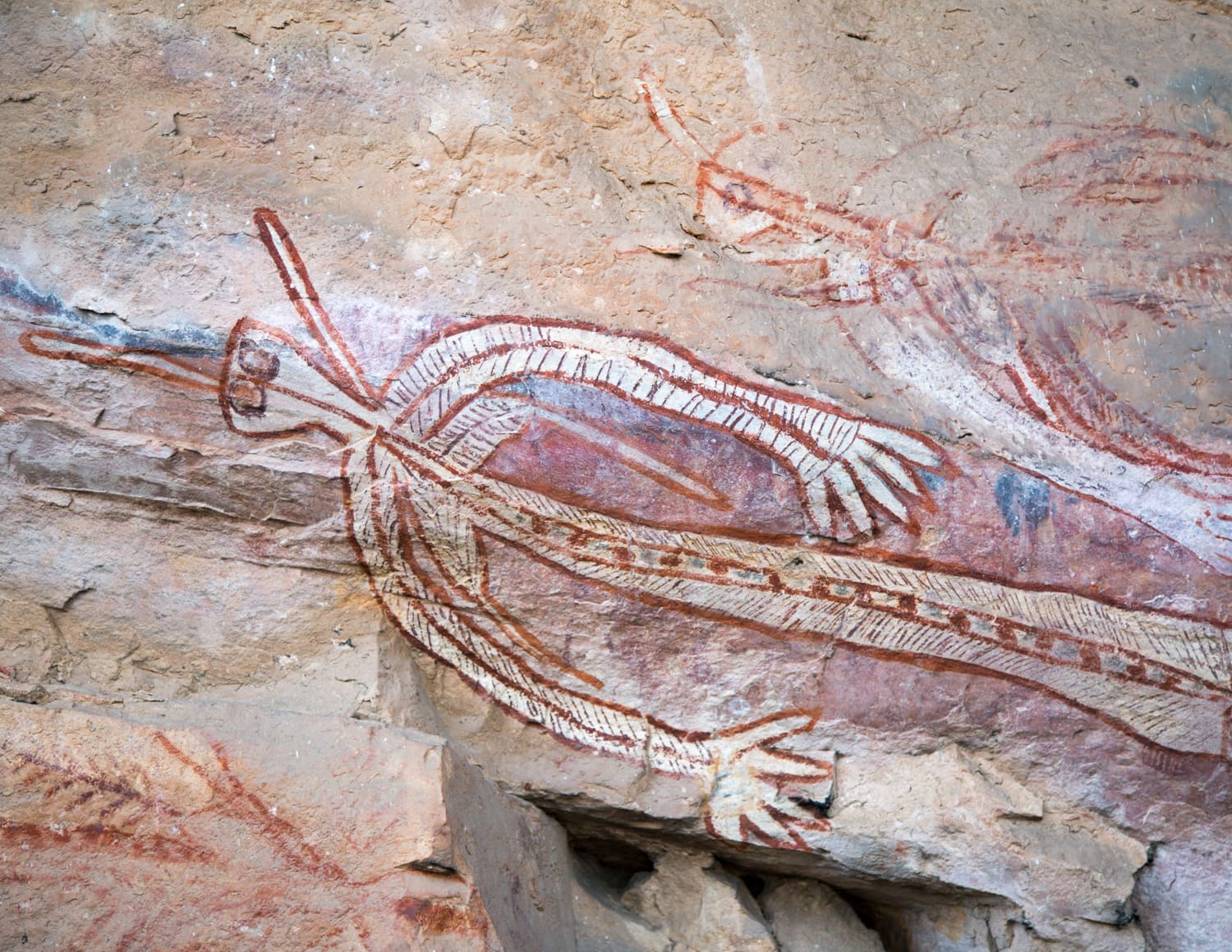
Many of the paintings in these galleries are over 20,000 years old, and the stories that are passed on over generations are fascinating. They are so bright and vivid and still in incredible condition. Many people come to Kakadu for the rock art alone.
Read more: The best things to do near Darwin
The sunsets at Ubirr
There are few places to take in the sunset like Ubirr.
Make sure you arrive in time to thoroughly explore the rock art before making your way to the hill to sit and watch the sun go down. It’s a popular activity but the area is vast so you can easily find a crag of your own and pretend you’re the only ones there. The park actually closes at 7pm and the gate is locked, so be prepared for a mad dash back to your car so you don’t get locked in.
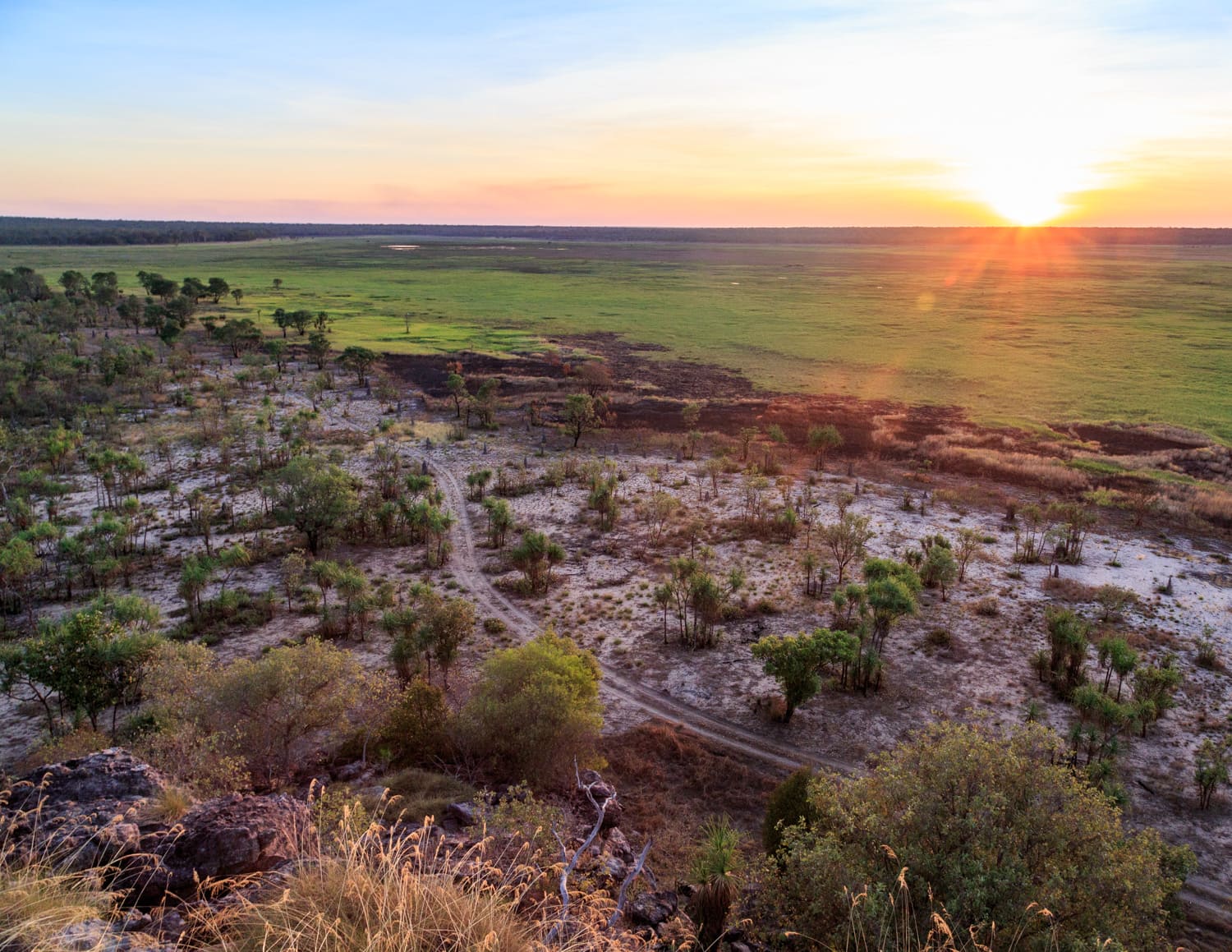
Very close to the gate there is a general store which serves great Thai food. It was the best meal we had in Kakadu so it makes for a good combo with an Ubirr sunset.
Read more: Best things to do in Alice Springs
Hiking through the outback: the Barrk Walk
We love this walk, Kakadu has some great hiking but most of the trails are pretty short, if you’re a keen hiker this is definitely the track for you. They don’t recommend starting after 8am due to the heat and the track is pretty exposed so we were glad we took this advice on board. The walk starts at the Nourlangie rock art site, we arrived at 7am to spend an hour exploring the site before starting the track.
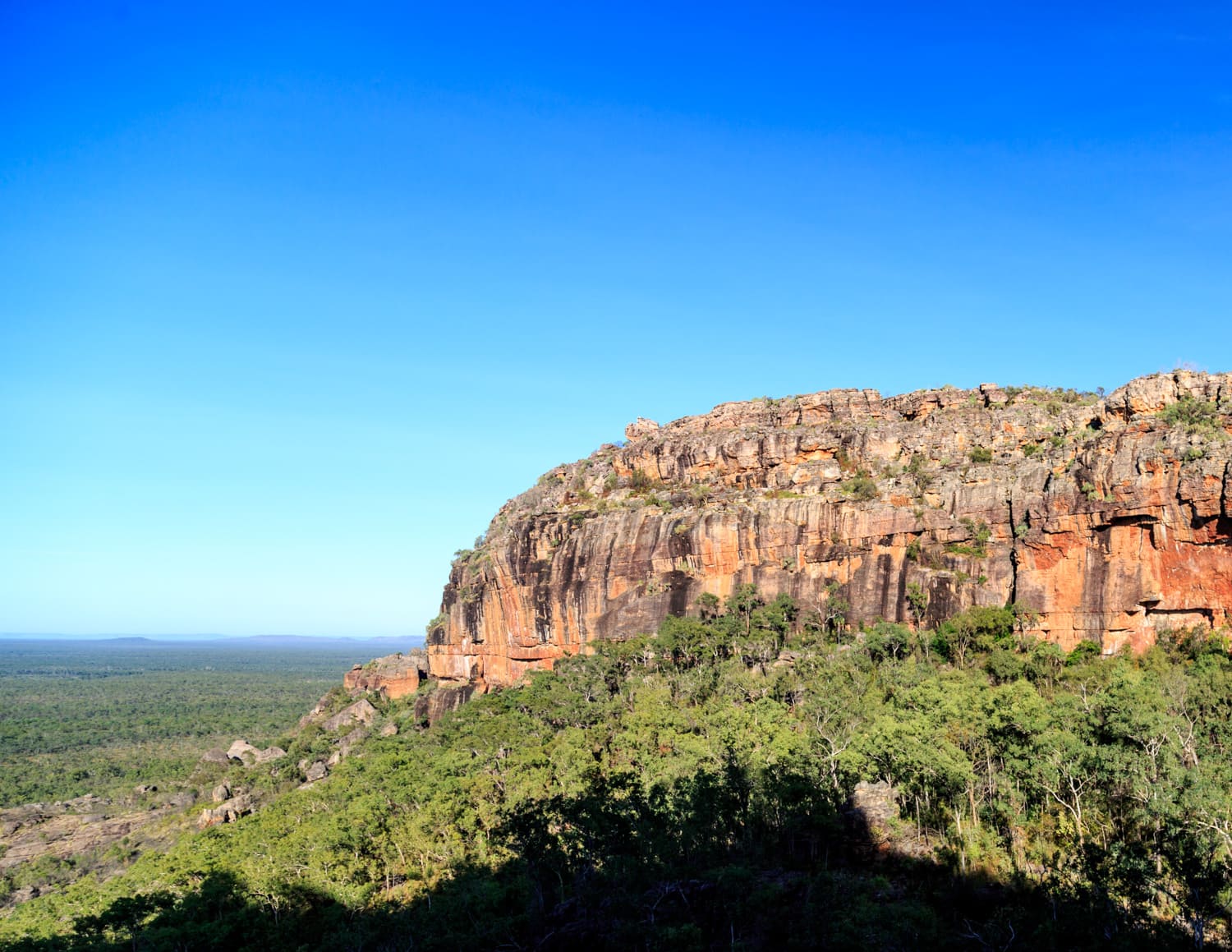
We did not see another soul on this entire 12km track which is staggering given how beautiful it is, and how popular Kakadu is. You really felt like you were in true outback wilderness and it had me yearning to walk the Larapinta trail one day.
The walk starts off quite steeply as you ascend to the top of the cliffside, and the views are spectacular. There are some exposed sections which can give you a serious case of jelly legs! There are a few steep downhill sections on loose rock so walking poles would come in handy.
At around the half way mark you come to the Nanguluwur art site. The art here is particularly well preserved. It was quite confronting to see the pictures of tall sail boats take over from the indigenous animals and spirits. This seemed to be quite a quiet site, probably due to the fact that the nearest car park is a 3.4km round trip away, whereas most of the other sites require very little walking.
From the rock art site it is a very easy walk back to your car, through sandstone outcrops and open woodland. This was perfect for us as it had started hotting up by this point.
Overall, we’d definitely recommend this walk, there is a fair bit of up and down in the first part of the track and some exposed edges and uneven terrain but definitely doable if you’ have a little bush walking experience.
Finding an azure blue waterhole: Motor Car Falls
It’s a tough call but this is possibly our favourite waterhole of them all. In a national park full of sublime spots this is really high praise. You access the falls via an 8km return walking track, so this is a waterhole you can visit later in the day and still be likely to have it to yourself, or shared with just a few others.
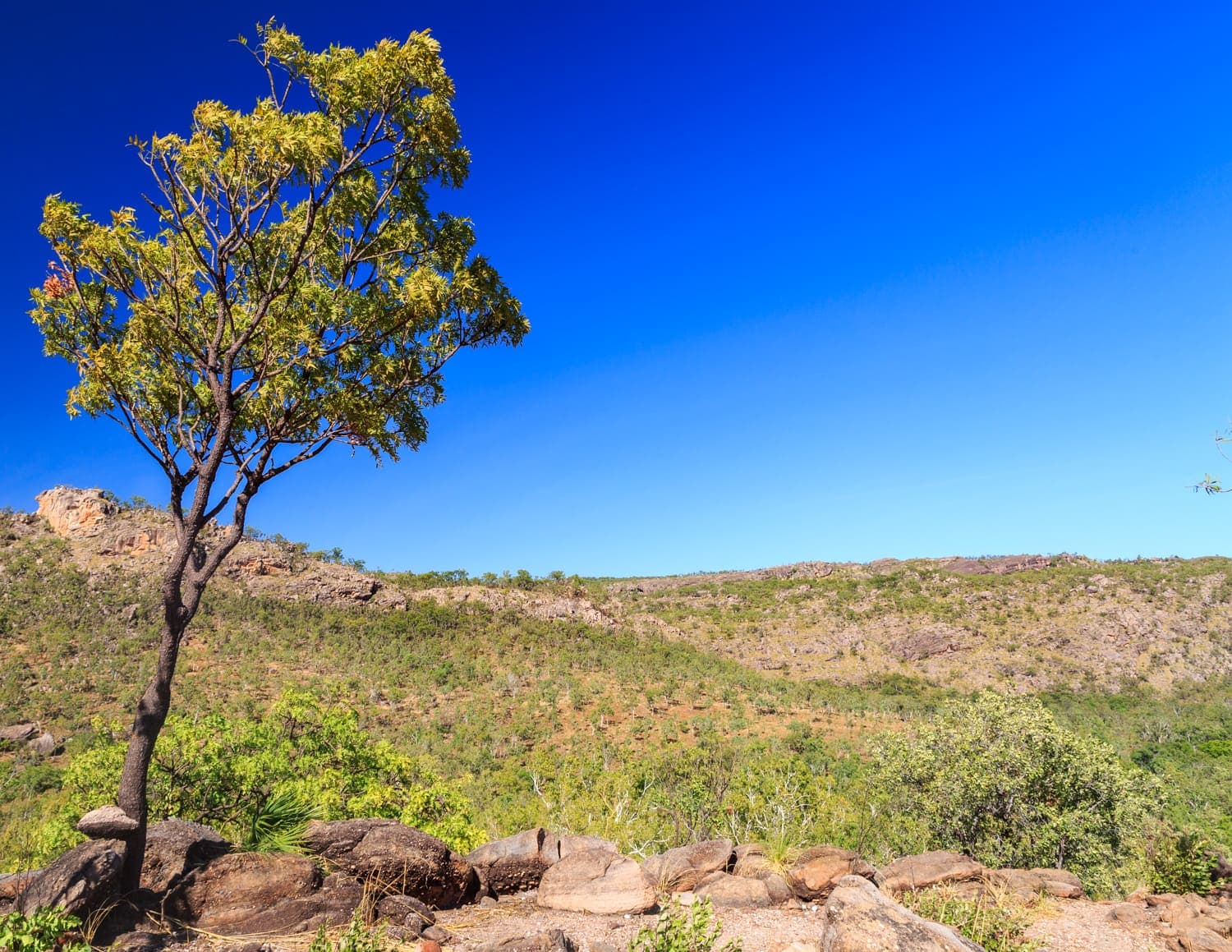
The colour of the water almost looks fake, like something straight out of a fairy tale. There are also several small waterfalls running into the pool. You access the pools by climbing behind the rocks that you will see when you first arrive at the creek. That just adds to the feeling that you’ve stumbled upon a a very special place.
Read more: Best swimming spots in the Northern Territory
An infinity pool on top of a waterfall: Gunlom Falls
This has to be one of the most spectacular and unique infinity pools we’ve ever been to. A short but very steep 500m walk takes you up to a series a falls, each with a picture perfect swimming hole. Our favourite was the one with the view over the plains. Really, it doesn’t get much better than this.
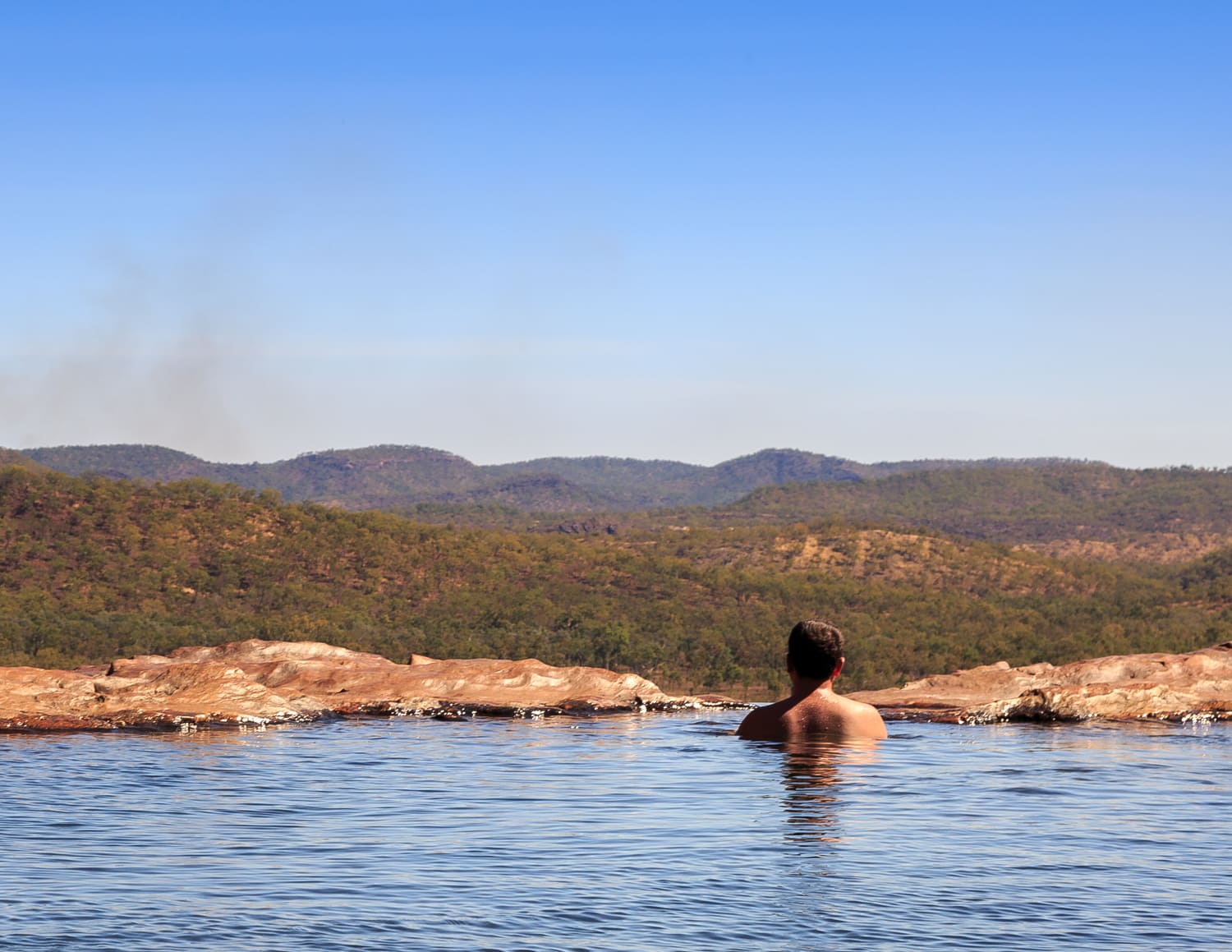
There are also pools just five minutes from the car park but these are known to be croc haunts and we wouldn’t advise swimming here (though we saw people who were). It’s a beautiful spot though, and well worth a look.
Read more: When is the best time to visit Australia
Sunset at Nawalandja Lookout
Ubirr is the most famous sunset spot in Kakadu but if you’re there for a few days we definitely recommend checking out Nawalandja too. It’s just a 300m leisurely climb from the car park to the top of the rocky plateau, offering amazing views over the plains and Nourlangie rock.
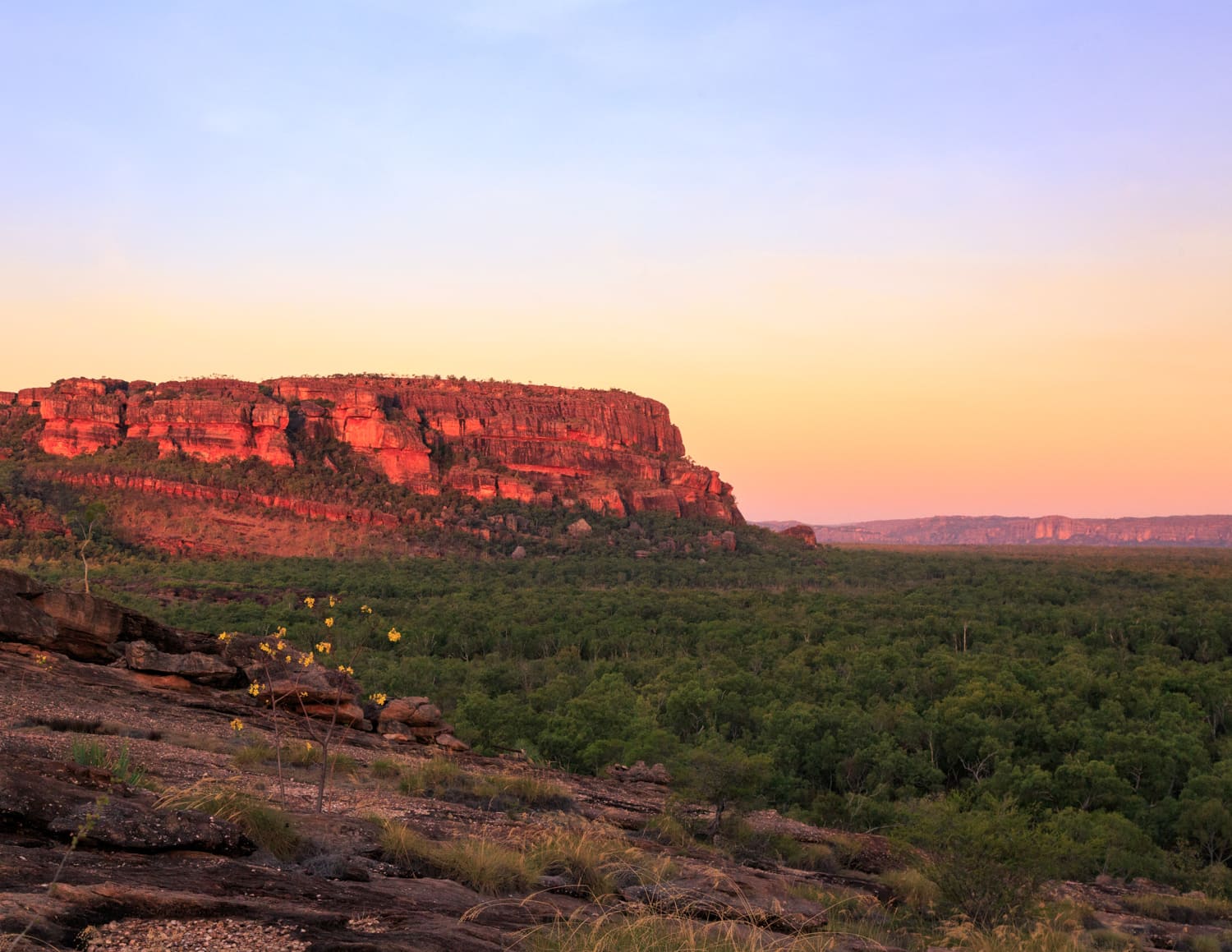
Unlike Ubirr there are no gates here so you can stay for as long as you like, soaking up the last of the rays. There were only a couple of people here when we visited and the plateau is huge so it still had that alone in the wilderness feel. It is a very beautiful, calming experience to watch the sun slowly light up the rocks in the distance.
Read more: The best places to see wild animals in Australia
Sandstone and River Walk
This easy 6.5km loop track gives you a great overview of the surrounding countryside. It follows on from the shorter Bardedjilidji Walk (2.5km), which was actually our favourite part of the track so if you’re short on time you could just do this loop.
The Bardedjilidji track takes you round a series of sandstone pillars, which feel like you’re wondering through an ancient man made city, nature is so spectacular!
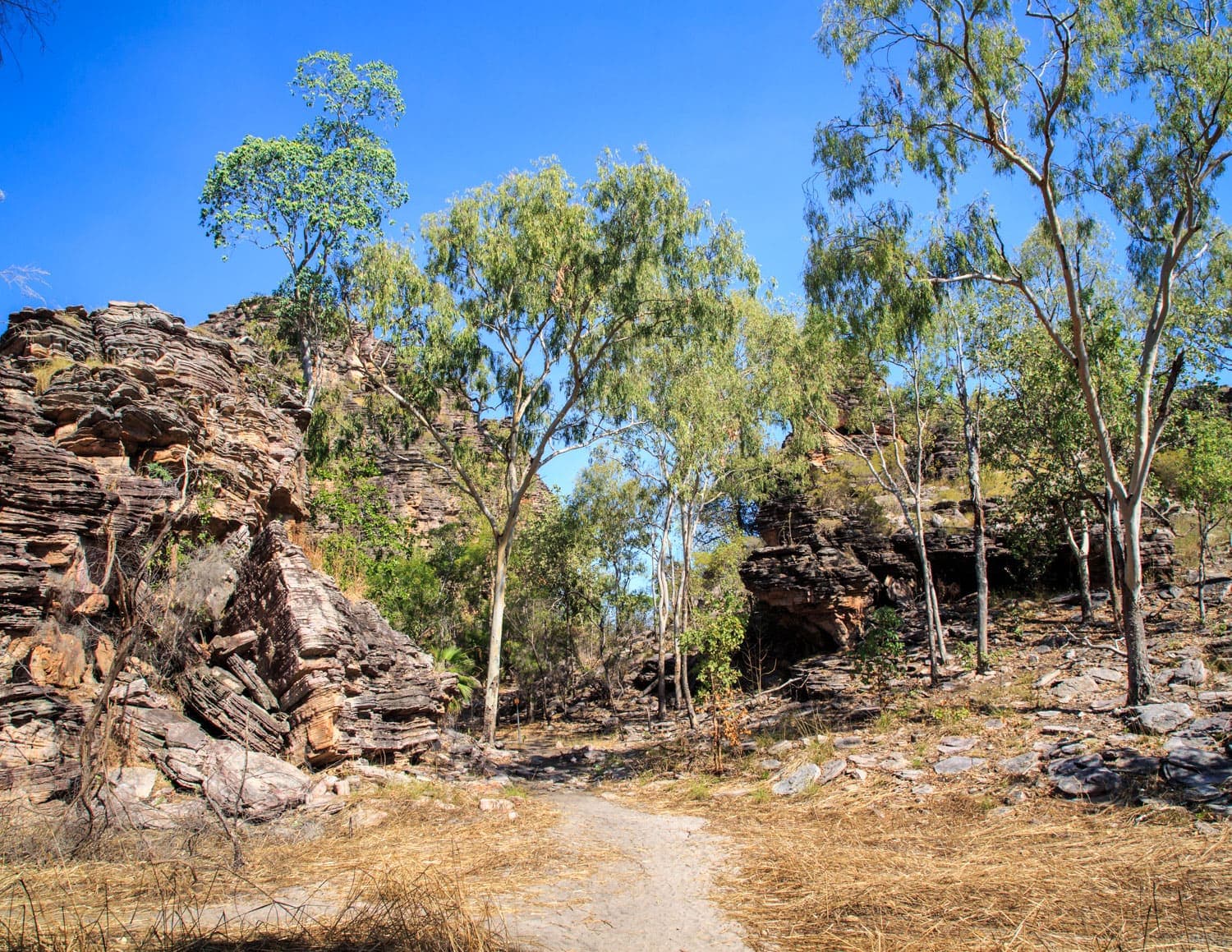
The rest of the walk largely follows the East Alligator River, and is very pretty, though at times I found the proximity to the croc infested water rather alarming! It’s also a good spot for spotting white bellied sea eagles.
Checking out this epic landscape from above
The routes are different depending on whether you are visiting in the wet or the dry so make sure you check the website closely, but a scenic flight over Kakadu and Arnhem Land is amazing. The wet season route looks far more spectacular as you pass over many of the waterfalls.
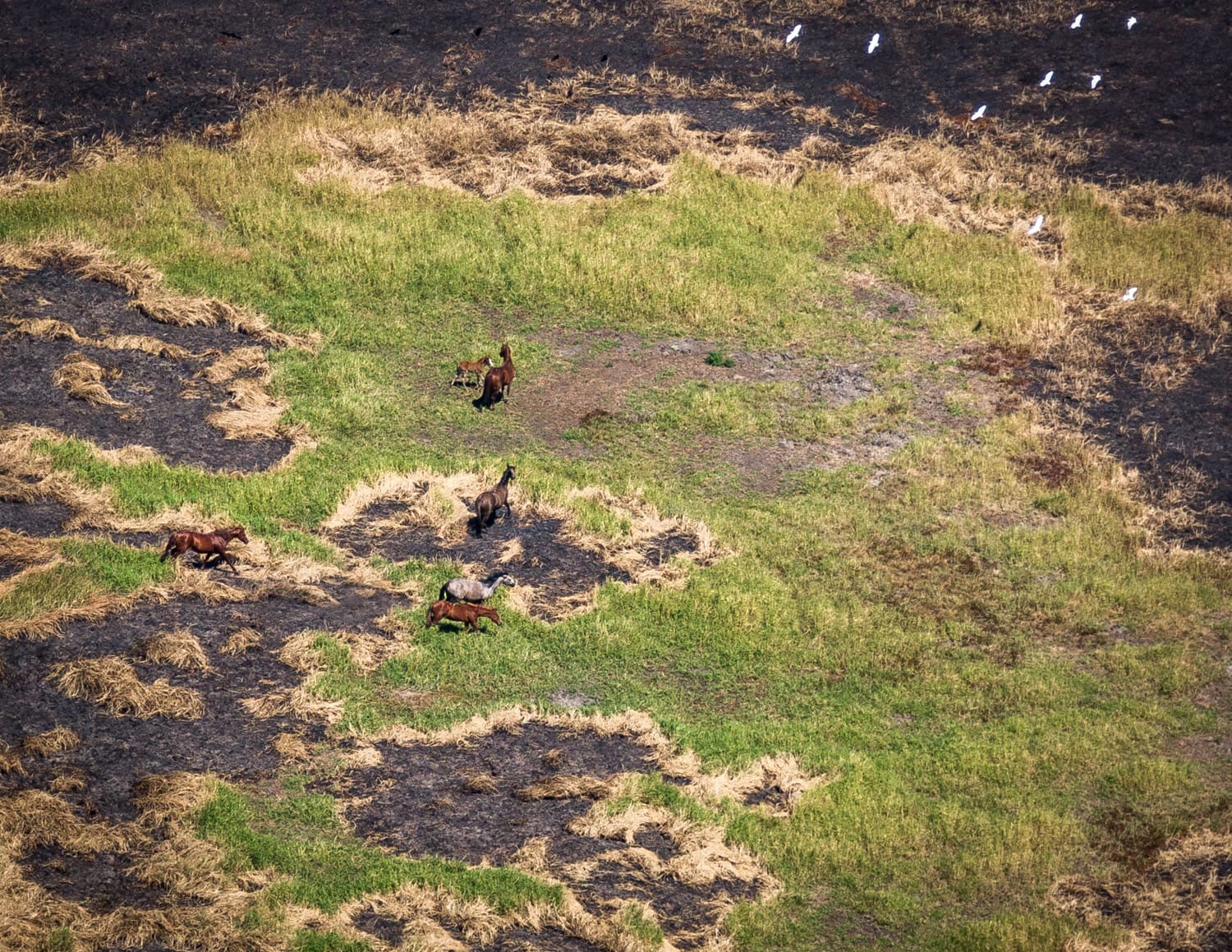
In the dry you are largely flying over escarpment and flood plains which is beautiful in its own right, but there are no waterfalls which was a tiny bit disappointing. It’s a great vantage point for spotting wildlife though, and we saw heaps of crocs and brumbies which was fantastic.
It’s also the only real way you can get any idea of the scale of the park too, which is simply staggering. I would love to try this flight again in the wet, one for next time!
Practicalities
It’s worth noting that Kakadu has two distinct weather patterns – the wet and the dry season- that will affect what you can do when you visit. The wet season runs roughly from October to March and can flood much of the area, meaning a lot of the attractions will be inaccessible.
Some are year round though, including several of the rock art sites and yellow water river cruises, and the benefits are that there will be fewer visitor numbers than in the dry.
We’d love to go back to experience a scenic flight over the roaring waterfalls too. Most people do choose to visit in the dry though as this is a time when you can access everything including the waterholes which can see crocs in the waterholes during wet season. It’s also a good time to see wildlife as they tend to congregate around the few waterholes that are left.
The park entrance fee is $25, good for 14 days, and should be purchased as soon as you arrive at the visitor centre.
We ummed and aaaahed over getting a 4wd as they are so much more expensive to rent, in the end, we did and didn’t regret it. Some of the waterholes are not accessible to 2wd unless you are prepared to risk serious damage.
We wouldn’t have taken a 2wd to Gunlom falls or Motor Car falls for example. Unfortunately, our car rental agreement despite being for a 4wd prohibited us visiting Jim Jim and Twin falls – much to our disappointment.
Check your rental agreement carefully as we heard rumours about cars being fitted with trackers and fines handed out for those who did take them there – this might not be true but we didn’t want to try our luck.
Another thing to be aware of is that all rental companies put a cap on the amount of free kilometres you can drive per day (this tends to be 100km). After this you’ll start paying per kilometre you go over. This can be frustrating as the distances are quite long and you’ll fly over this limit, so account for this before you arrive.
We’re not going to lie, you don’t come here for the food. There is a great supermarket in Jabiru though so if you have access to cooking facilities or you want to make your own lunches you’ll be fine. Sadly since our visit, the village bakery has closed down which was our go to for lunch.
The only restaurant we’d recommend (and I think we tried them all given we were there for seven days) was the Thai food at the general store. Like all food in Kakadu, it was expensive but the portions were so big it did us for lunch the next day. Small eaters should definitely share! The next best would be the food at the Cooinda lodge if you are staying out that way, or after you finish the sunset yellow water cruise.
Where to stay in Kakadu
We were in Kakadu just over a week in total and ended up trying several different accommodation options.
Mecure Crocodile Hotel
This was a nice midrange option, clean and large rooms with all the usual amenities. A similar hotel would be much cheaper in other parts of Australia, but all accommodation in Kakadu National Park are overpriced. The hotel is in Jabiru which is well placed near to the supermarket and roughly 45 minutes drive from both Ubirr and Yellow Water (in between both).
Cooinda Lodge
This hotel was in a lovely leafy and shady area, very close to where the yellow water river cruises run from (you buy your tickets from here). The rooms are individual freestanding cabin types, which have just completed a full refurb, exciting news if you’re heading to Kakadu later in the year!
If you are doing a yellow water sunrise cruise, we’d still recommend staying here as otherwise, the early start from Jabiru would be fairly brutal. The location is also very good for visiting some of the water holes, such as Gunlom and Motor Car falls, which make a very long day trip from Jabiru.
Categories: Cooinda Lodge , Indigenous Experience , Kakadu Adventure Tours , Kakadu Events , Media , Media & Trade , Mercure Kakadu Crocodile Hotel , Uncategorized , Warradjan Cultural Centre , Yellow Water Cruises
- FB icon Follow us on Facebook
- insta icon Follow us on Instagram

History tells us that Maguk should open mid to late June so keep an eye out for the announcement! Video: @joshin_around_ [Ig]

MAYALI MULIL FESTIVAL | 6 - 9 September, 2024 Located in Kakadu National Park, Mayali Mulil is a gathering of people, country, culture and enterprise, with an aim of achieving sustainable balance between two worlds. Family and community activitiesincluding: 🪃 Learn Traditional Dancing 🪃 Indigenous Music 🪃 Guided Walks & Talk on Country 🪃 Art Exhibition celebrating local artists 🪃 Bush Tucker 🪃 Cultural workshops Choose between: 🪃 Pandanus Weaving 🪃 Bark Painting 🪃 Didj & Clapstick Making 🪃 Spear & Borndok Making 🪃 Plucka Goose You can also choose to stay on-site at Kakadu Billabong Safari Camp in an Eco-hut, or camp with your caravan, campervan or tent in our unpowered sites with shower and toilet facilities.

It's World Environment Day 🌏 As a dual listed UNESCO World Heritage site, Kakadu National Park is pretty special! Within the vast landscapes of Kakadu, there are six main landforms. Each landform and the habitat it contains has a range of plants and animals. 🍃 Savanna woodlands make up 80 per cent of Kakadu, with mostly eucalypts and tall grasses. 🌱 Monsoon vine forests occur in small, isolated patches such as the Manngarre walk or Gubara. Fruit-eating birds and flying foxes connect the plants by dispersing pollen and seeds. 🌄 The southern hills and broken ridge ranges are the result of millions of years of erosion, creating a diversity of habitats that do not occur anywhere else. 👀 The dominant sandstone escarpment of the stone country contain rock shelters and outliers around Ubirr and Nourlangie. 💦 The tidal flats, mangroves and coastline include 500 square kilometres of coastal and estuarine areas lined with mangroves and are recognised internationally significant for migatory birds. 🐊 The floodplains, rivers and billabongs undergo dramatic seasonal changes where, after summer rains, a sea of shallow freshwater spreads out for hundreds of square kilometres. As it dries, waterbirds and crocodiles seek refuge in remaining wet areas at Yellow Water and Mamukala There's no place like Kakadu 💫

Our most popular activity at Kakadu is to jump onboard Yellow Water Cruises for a gentle glide through the Yellow Water Billabong. ⠀ ⠀ Sunrise to sunset, the cruise winds its way through distinct ecosystems of Yellow Water Billabong and tributaries of the South Alligator River. ⠀ ⠀ Home to numerous species of native creatures that thrive in this environment you're guaranteed to see crocs, brumbies, barra, birds... so many birds! In fact, Kakadu is home to about 1/3 of all Australian species. From the majestic black-necked stork to the tiny and sometimes elusive azure kingfisher, you'll be mesmerised by this incredible experience.⠀ ⠀ Image: @emmaphotoaus ⠀ ⠀ #kakadunationalpark #kakadukitchen #murdudjurlfamilycommunity #murumburrcountry⠀

There's no place like Kakadu!⠀ ⠀ Life in Kakadu as experienced by @our_sunset_journal ⠀ ⠀ #swimmingholes #waterholes #waterfalls #wildlife #culture⠀
Visit Kakadu
- About Kakadu
- Where to Stay
- See & Do
- Build My Itinerary
- Media & Blog
Stay Connected
Exclusive specials and announcements!

© Copyright 2023 - 2024 Kakadu Tourism
- Terms & Conditions
site by Karmabunny
Beyond Wild Places
Your guide to the wilder side of life
A Travel Guide to Kakadu National Park Without a 4WD
Kakadu is a magical place. The expansive national park is one of Australia’s largest and arguably most important, being at the core of the oldest living culture on earth. The UNESCO World Heritage Listed national park is home to some of the country’s best Aboriginal rock art, most diverse flora and fauna and some staggeringly beautiful landscapes.
It’s characterised by the rocky escarpments and floodplains of Arnhem Land, with lush forest, thundering waterfalls, rocky outcrops and a variety of wildlife. With millions of migratory birds and the intimidating saltwater crocodiles, it’s one of the most biodiverse places on earth.
The spiritual land of Kakadu National Park is one of the must visit places in the Northern Territory. While much of the park is quite remote and inaccessible for regular vehicles, there has been some improvements in recent years on the road network to allow 2WD vehicles to reach some of the most important attractions.
I recently spent a week in Kakadu travelling in my van during the dry season, so I’ve put together this guide to Kakadu National Park for those travelling with just a 2WD. This blog details all the best places to see that are accessible on a short road trip from Darwin.
Disclaimer: This post contains affiliate links which means I get a commission if you buy a product through my link at no extra cost to you. By doing so, I can keep this blog going and continue to create helpful guides for you. Read more: Privacy Policy
About Kakadu National Park
Kakadu National Park covers an impressive 20, 000 square kilometres east of Darwin in the Northern Territory’s Top End. It’s one of 20 UNESCO World Heritage Listed places in Australia, in recognition of both its natural and cultural values.
It’s the traditional home of the Bininj/Mungguy people, who have lived in the region for tens of thousands of years. The national park is jointly managed by Aboriginal Traditional Owners and Parks Australia.
Read next: 15 Best Things to Do in Darwin and the Top End

How to get there
There’s no official airport inside the park area, so by road is the only way to reach Kakadu. There are two main sealed roads that run through the national park, Arnhem Highway and Kakadu Highway, both meeting at Jabiru, the main town inside the park.
If you’re coming from Darwin , the park boundary of Kakadu National Park is just over 150km southeast of the city on Arnhem Highway.
Otherwise, if you’re coming from Katherine further south, it’s also just around 150km to the park entrance on Kakadu Highway.
You can also opt to join a tour either from Darwin or once you arrive in the park. Check some of these out from Viator.
Getting around Kakadu without a 4WD
Kakadu National Park can be explored with any kind of vehicle, thanks to the sealing of the two main highways through the park. But, it’s definitely more suited for 4WDs and you will be able to reach more sights with a high clearance vehicle. However, all of the main highlights of the park can be accessed by the sealed roads now, so you can still get to the enjoy some of the incredible places in Kakadu.
I was travelling in my old Toyota Hiace van, so I was confined to mostly exploring the more accessible places. This guide to Kakadu is aimed at those who are travelling in 2WD vehicles like me, and will focus on the spots you’ll be able to see in the dry season with a regular car or van.

When to visit Kakadu National Park
The best time to visit Kakadu is up for quite a debate. The Traditional Owners recognise six different seasons in Kakadu, each with their own characteristics and unique weather patterns. However, for visiting purposes, it can be simplified to the dry season which runs from May until October and then the wet season from November until April (although the exact beginning of the wet season varies each year).
Most people tend to visit Kakadu National Park in the dry season , as this tends to be the high tourist season for all of Northern Territory. During this time the weather is pretty predictable with clear skies and warm weather every day, with temperatures generally around 30 degrees.
On the other hand, the wet season is characterised by a few months of monsoonal rains with high levels of humidity. However, this is actually a very unique time to be in the national park, with no crowds and the chance to see the incredible wetlands and waterfalls at their best.
Be aware that travelling in the wet season comes with some road closures inside the park. A 4WD would be much more useful in the wet season, although even then some waterfalls are still unreachable. Taking scenic flights in Kakadu National Park is a great option to see some of the highlights during the wet season road closures.

Essential information about visiting Kakadu National Park
Park passes are required to visit Kakadu National Park. They are available online or at one of the Visitor Centres inside the park and are valid for 7 days. You can purchase them online here .
During the popular dry season, passes are $40 per person, while the price drops to $25 per person during the wet season from November until May. It’s cheaper for families and concessions. Kids up to 4 years old are free.
Kakadu covers an incredibly huge area of the Top End and is broken down into seven regions to help make planning your trip easier. These seven regions include:
- South Alligator Region
- Jabiru Region
- East Alligator Region
- Burrungkuy Region
- Yellow Water Region
- Jim Jim/Twin Falls Region
- Mary River Region
There are some Ranger guided activities , which are free and offer an incredible insight into the landscape and culture of Kakadu National Park. They operate all year round, with a different program for the tropical summer and dry winter. The activities are generally rock art tours that last around two hours at various sites on different days of the week. You can find out more about them here .
Early morning and late afternoon are better times to explore the park in terms of both weather and wildlife. However, you need to be very aware driving at night, as the animals are more active and accidents occur often.
Jabiru is the main town and hub of the national park. This is where you’ll find all the essential services, including a supermarket, fuel and variety of accommodation.
Phone reception can be limited inside the park. The only place you’ll find stable reception is at Jabiru, where there’s both Telstra and Optus signal.

Where to stay
Jabiru is the main town in Kakadu National Park and has a nice variety of accommodation options. It’s the perfect base from which to explore the park by car, with most of the highlights just a short day trip away. The other option is to stay near Yellow Water at the lodge.
Aurora Kakadu Lodge and Caravan Park | The most affordable place to stay in Jabiru, Aurora has a range of options including bungalows and lodge rooms, as well as, plenty of caravan park sites. From powered sites to a huge bush camping area, it’s where most people stay when travelling with a van. I stayed in the camping area in my van and really enjoyed my stay. It has a nice lagoon outdoor pool for cooling off. Check availability here .
Cooinda Lodge | Located beside Yellow Water Billabong, this is very convenient if you plan on taking an early morning or late evening tour of the wetlands. With air conditioned rooms and glamping style options, it’s a really nice place to stay in Kakadu. It also features an outdoor pool and restaurant. Check availability here .
Kakadu National Park camping
There are some basic Parks-managed Campgrounds scattered throughout the park area. Most have toilets and water, but a few also have showers. Some more basic and remote sites are unmanaged with honesty boxes, while the more popular ones are managed with an on-site manager.
Prices range from free to $15 per adult. It operates on a first come first served basis, but you can find out more information here .
Some convenient campgrounds for those with a 2WD or towing caravan are:
- Mardukal Campground, near Yellow Water
- Djarradjin Campground, which is not far from Nourlangie Rock
- Merl Campground, the closest to Ubirr
Essential gear for Kakadu
- Head torch: As soon as the sun sets, you’ll be needing a good quality headlamp to help you find your way around the campground. This Black Diamond one is USB rechargeable too.
- Camp chair: Kick back and relax at the end of the day with a comfortable and lightweight camping chair. This Helinox camp chair is a high quality option that packs away easily.
- Gas cooker: Cooking up quality meals while camping makes the experience so much more enjoyable. I recommend a JetBoil stove which is super portable and boils water rapidly for easy cooking.
- Portable solar panel: If you’re camping at an unpowered site, a small portable panel can come in handy when trying to charge your phone off the grid. This BioLite Panel is easily packable and powerful enough to charge your devices.
- Sleeping bag: A good sleeping bag is essential to keep you warm, dry and comfortable while camping out. Sea to Summit make some incredible down options, with the Spark III being a staple for many different adventures.
- Day pack: For exploring beyond camp and heading off on day hikes, a good sized day pack will help you carry all your hiking essentials. Osprey Tempest is the classic day pack I take on all my adventures.
- Water bottle: To save plastic bottles ending up in landfill, I always carry a LifeStraw Water Bottle with me so you can refill it from anywhere and be confident that the water will be safe.
- Quick drying towel: From beach swims to freshwater swimming holes, carrying a quick drying towel is a handy addition to any camping trip. Sea to Summit make great lightweight and quick drying towels of all sizes.

Things to do in Kakadu National Park with a 2WD
If you’re travelling through Kakadu National Park, these are the best things to do that you can access with a regular 2WD vehicle.
Mamukala Wetlands
A bird watchers dream in Kakadu National Park, Mamukala Wetlands is an incredible hidden gem off the Arnhem Highway. Located just before Jabiru if you’re coming from Darwin, it’s easily accessed just off the highway.
Just a short walk from the car park and you’ll come to a purpose built bird watching shelter, to sit and enjoy the view. The area is beautiful all year round, although keen bird watchers will want to aim for late dry season around September when magpie geese congregate to feed in the area.
If you want to stretch your legs then there’s also a 3km walk around the wetlands. The walk is accessible during the dry season and allows you a closer look at some of the wildlife found there.

Ubirr Rock Art
The most famous attraction of Kakadu, Ubirr is listed as a UNESCO World Heritage Site for its cultural importance. There is an easy 1km circuit that takes in the incredible rock art galleries, as well as, a 250m climb up to the top of a rocky outlook. This viewpoint offers a spectacular 360 degree across the floodplains and one of the most incredible sunsets you’ll ever seen.
Watching sunset at Ubirr is one of the most popular things to do in Kakadu, so expect plenty of other people with you during the dry season.
Ubirr is just half an hour north of Jabiru on a sealed road, with plenty of parking to accommodate all visitors. You can easily visit Ubirr in the afternoon from your accommodation in Jabiru, and maybe even combine it with a stop at Cahills Crossing.

Cahills Crossing
If you pass the turnoff for Ubirr and head for the river, there is a car park for Cahills Crossing on your left. This is where the highway crosses over the East Alligator River and continues into Arnhem Land. It has become one of the most accessible places to watch wild crocodiles, with a purpose built platform on the right side of the road for safety.
Estuarine (saltwater) crocodiles are the world’s largest reptile and are right at home in Kakadu, with a large number of them residing in the park boundaries. They tend to congregate at the crossing to feed on fish that get dragged in by the river tide over the road. It generally happens in the late wet season, when water levels are low and I saw quite a few lurking in the waters when I was there in August.

Burrungkuy (Nourlangie) and Nawurlandja
Burrungkuy (Nourlangie) rock art site is recognised along with Ubirr as some of the most impressive Aboriginal rock art in Australia. There is a beautiful 1.5km loop walk which takes you past an Aboriginal shelter and various rock art galleries from the car park. The impressive art in the Anbangbang Rock Shelter shows the history of Aboriginal inhabitants right up until first contact with Europeans. It’s an absolute must see in Kakadu National Park, despite generally being quieter than Ubirr.
It’s worth taking the walk up to Kunwarddewardde Lookout as part of the loop walk, which offers an incredible view of the Nourlangie rock and towards the Arnhem Land Escarpment.
On the road into Burrungkuy (Nourlangie) off the highway, you’ll also see a turnoff for Nawurlandja. This side trip is worth taking and takes you to a short but steep walk up to the top of a rock face to Nawurlandja Lookout. The spectacular view includes of the escarpment in the distance, Burrungkuy rock and Anbangbang Billabong. It’s one of the best places to watch the sunset in Kakadu, and is far less busy than Ubirr. When I was there in August, there was just a handful of other people at sunset time.
Burrungkuy (Nourlangie) is just 30 minutes south of Jabiru on a sealed road off Kakadu Highway.

Yellow Water (Ngurrungurrudjba)
One of the quintessential experiences in Kakadu is a tour of the Yellow Water Wetlands. As part of the South Alligator River floodplain, the wetlands attract a wide variety of wildlife, including birds and huge crocs.
While there is a few ways to explore Yellow Water, a sunset or sunrise cruise is a real highlight. The Aboriginal owned and operated wetlands cruises operate throughout the year and offer a chance to get close to some impressive wildlife.
If you’re not keen on a cruise, there is also a short boardwalk and viewing platform accessible in dry season. Nearby is also the Warradjan Aboriginal Cultural Centre , which is worth a stop to learn more about the fascinating culture of the Bininj and Mungguy people.

Kakadu National Park itinerary without a 4WD
If you don’t have a 4WD and still want to visit Kakadu, this itinerary will help you see the sights listed above within just a few days from Darwin.
Day 1 || Leave Darwin early and take the Arnhem Highway to Jabiru. On the way, stop at the Mamukala Wetlands for some bird watching and a short walk. Then continue onto Jabiru to check into your accommodation. In the afternoon, head off towards Ubir. Stop at Cahills Crossing to spot some crocs and then continue onto Ubirr. Wander past the rock art and then find a spot on top of the rock to watch the sunset over the Arnhem Escarpment and floodplains.
Day 2 || Relax in the morning at your accommodation in Jabiru and then set off in the afternoon for Burrungkuy (Nourlangie). Check out the incredible Aboriginal rock art and shelter on the loop walk and head up to Kunwarddewardde Lookout for impressive views. Return to your car and then drive just down the road to Nawurlandja Lookout in time for sunset. Climb to the top of the rock face and enjoy the changing colours of the sky with hardly anyone else around. Return to Jabiru to stay the night or camp at one of the nearby Parks managed campgrounds.
Day 3 || Leave Jabiru behind and head down to Yellow Water. Check into your accommodation at Cooinda Lodge or the campground and relax for the day. You can opt for the sunset Yellow Water Cruise, or head out on the sunrise cruise the next day.
Day 4 || Head back to Darwin or continue out via the Kakadu Highway to Pine Creek and down to Katherine.
Read next: Best Swimming Spots and Waterfalls in Litchfield National Park
Pin this post

Share this:

Walks and Waterfalls in Tarra-Bulga National Park

A Complete Guide to the West MacDonnell Ranges / Tjoritja

A Complete Guide to the Ikara-Flinders Ranges National Park

Essential Guide to Visiting Deep Creek National Park
[…] you’re heading north, then must visits are Litchfield National Park and Kakadu National Park, both outside of […]
[…] is no parks pass required for Litchfield National Park, unlike Kakadu National Park. The park is free to explore and is open all year round and at all […]
[…] it also means, places can get quite busy, especially at famous locations like Ubirr Rock Art in Kakadu and Florence Falls in Litchfield National Park. Yet, it’s still an underrated holiday […]
Leave a Reply Cancel reply
Discover more from beyond wild places.
Subscribe now to keep reading and get access to the full archive.
Type your email…
Continue reading
The ridgy-didge outdoor & adventure blog!
Guide to Visiting Kakadu in the Northern Territory
So, you’ve decided to take on Australia’s largest National Park, Kakadu. But where do you start when you have up to 20,000 square kilometres of floodplains, estuaries, waterfalls and stone country to explore? The place is so big, so bold and so beautiful, and is alive with Australian Aboriginal culture.
Understandably there are still some areas inaccessible to the public due to its cultural significance to the traditional landowners, but there are a couple of secret spots we can let you in on.
So here is a guide to get you on your way to packing your bag, loading the car or booking flights.

Noarlangie Rock at Kakadu National Park.
The top end of Australia doesn’t experience the usual four seasons. The wet season comes with the first crack of lighting on a late afternoon in November, and Kakadu goes from burnt orange to luscious green overnight.
When the wet season ramps up, so does the humidity. So a normal 35°C day starts to feel more like 45°C. It’s impossible to keep your shirt dry and there isn’t enough cold water in the world to satisfy your thirst. As beautiful as it is in the wet season, you need to know what you are doing in order to stay safe.
So with that, I suggest this hot tip, travel between May and July. At the start of the dry season, the waterfalls are still cascading heavily, the nights are cooler and the Barramundi are biting.

Walk to the top of Gunlom Falls to look out over the park.
Getting there
Kakadu National Park is 133km from Darwin and 149km from Katherine. If you are planning on flying, Darwin will be your best and cheapest option, accessible by direct flight from most capital cities.
As the Northern Territory’s capital city you’ll find plenty of options for 4WD/van/motorhome hire and accommodation options before venturing into Kakadu. Darwin is also a great place to stock up on food and fuel. Fuel prices are about 20c/L more expensive in the park.
Remember that you are about travel in to remote Australia. Although there is a good supermarket, medical centre and bank in Jabiru, near the centre of Kakadu NP, options are going to be limited.

The sunset over the Nourlangie rock lookout.
Choose your ride
It is not all bulldust and backroads like we had come to believe. So we were pleasantly surprised to be driving through the heart of the national park on the smooth surface of the Kakadu Highway. There is a good chunk of Kakadu that you can do in a standard 2WD, but if you want the full, unlimited experience we would definitely recommend a 4WD.
You do not necessarily need to be an experienced four-wheel-driver. You just need a high clearance vehicle that can make a shallow creek crossing or two and won’t rattle into smithereens on the dirt roads. Have you heard of corrugations? You will know all about these incessant bumps in the road as soon as you hit the turnoff to Jim Jim Falls, and they are relentless.

You’ll need a pass to access the wonders inside Kakadu NP.
Have you got your park pass?
You will need a park pass to access Kakadu National Park. You can buy your pass online , at the Katherine Visitor Centre or the Bowali Visitor Centre in Jabiru . Pass prices range from $12.50 for children and $25 for adults and last for up to 14 days.
Children under 4 are free and other discounts are available for families and concession card holders. 100% of this money goes right back into the park and supports the traditional landowners and general park upkeep.

Sandy Billabong is our top pick for camping in Kakadu.
Where to stay
If you can camp, camp. Kakadu offers 26 different campgrounds across the park, which range from fancy caravan parks to basic bush camping. So if you want a pool, hot showers and to treat yourself to dinner out, you can base yourself at the Cooinda Campground and Caravan Park .
But if you are like us and would prefer to light up a fire in a quiet corner of the park our top pick would be Sandy Billabong (it must be the sandy track and long drop toilets that deter a few people from getting in here). All of the big hitters like Gunlom, Jim Jim Falls and Maguk have a campground nearby so that you can really make the most of these special places. Camping fees depend on the facilities available and you will find some of the more remote sites are free of charge.
If you were not planning on camping at all, fear not, you have 7 hotels/lodges/resorts with varying degrees of luxury to choose from.

A campfire dinner at our campsite at Sandy Billabong.
What to bring
An alarm clock . There is a reason this place gets busy, so if you want to beat the crowds and enjoy some time to yourself at the top of Jim Jim Falls, set your alarm. Getting up early is also the best way to beat the heat. Speaking of heat, here are some things you will need to have with you in order to prevent heat exposure.
- Water, minimum 1L per hour of activity, or 4L per day
- Lightweight, long sleeved shirts
- Broad brimmed hat
- Respect for the wild

You’ll need sun basics such as hats and a daypack for exploring the park.
Some other things you will also need to include;
- Mosquito repellent
- Hiking boots
- Backpack for day trips which must always contain water, snacks and a basic first aid kit
- National Park map

With so many opportunities to enjoy the water, swimmers and a towel are a must.
Mother Nature did some amazing work on this playground. Blue water, glowing orange rocks and waterfalls that lead into more waterfalls. Read a bit more about it below in Secret Spots.
2. Jim Jim Falls
This one is a tour bus favourite so timing is everything. The earlier the better, or you might get lucky around 3 pm when they start loading their customers back on the bus. After making the rock scramble to the first beach on the right-hand side, we would suggest holding your backpack above your head and swimming around to the second beach to find a bit of space that is all yours. Once again, check out Secret Spots for a hidden gem close by.

Swimming through the pristine waters of Maguk.
If you are looking for an education on Australian Aboriginal history this is the place. Once a great meeting place and educational hub, the area is covered in densely intricate rock art that dates back 3000 years and tells a vivid story of life in the area. There is a Ranger-guided walk through the site that really gives you an understanding of the Aboriginal culture that is alive in Kakadu.
Ubirr is also an amazing place to watch the sunset, with floodplains on one side and stone country on the other. Give it time and watch the colours change over the landscape and the shadows lengthen across stony escarpments.
4. Yellow Water River Cruise
Ever thought of feeding your kids to the crocs? this would be the place… don’t though. The crocodiles here are brazen and about as big and bold as Kakadu itself. It is not only crocodiles you’ll see, but Asian Buffalo and wild horses on the banks.
There are plenty of Barramundi and Saratoga if you are going to wet a line. And the most beautiful water lilies stand proudly along the edges of Yellow Water.

A saltie we spotted on the Yellow Water Cruise.
5. Twin Falls
An immense waterfall that is open for a limited time each year due to high waters and a shuttle boat crossing. It would be worth looking into a helicopter flight in order to see this beauty in full flow if you can’t gain access
Secret Spots
There are a couple of places that just don’t get much hype. Or they get a lot of hype but some crucial information is missing, for example, Barrk Marlam.
Barrk Marlam
You have heard of Jim Jim Falls (I’ve definitely mentioned it a few times), but have you heard of Barrk Marlam? Well, it is one of our absolute highlights and not well marked. From the car park at Jim Jim Falls you follow the path to the falls for about 200m before turning off (there is a small sign) to the right across the creek.
The hike requires you to follow the pink ribbons hung in the trees to guide you to the top of Jim Jim Falls. Now it says that this hike is 6km return, but it is so intense it feels like twice that distance. At the top, you will be rewarded with spectacular views and private swimming holes.

Barrk Marlam is a challenging bushwalk, but well worth the hike.
Maguk’s infinity pool
Maguk’s infinity pool, we would not have noticed this sneaky spot if it wasn’t for a tiny little head that poked over the falls when we were swimming in the main gorge. To get to Maguk’s infinity pool you will need to stay on the left-hand side of the creek when the arrows tell you to cross. Look straight ahead and you’ll see the making of a well-worn path, follow it.
This walk is quite a bit easier than Barrk Marlam and just as rewarding. Be sure to take some goggles to see this gorge below the surface. If you are brave you probably won’t hesitate to swim through one of the underwater rock tunnels.
Motor Car Falls
Motor Car Falls is accessed via part of the Yirmikmik trails. 3.75km of fairly level ground will take you from a dry and dusty service road into a tropical oasis. Drape yourself over a giant boulder with sun rays pouring between prehistoric-looking trees, and then float on cool waters beneath zebra printed rocks. You are almost guaranteed to get this place to yourself any time of day.

The infinity pool at Maguk is not to be missed.

The Rockhole (Moline)
Lastly, a secret local’s hotspot, The Rockhole (Moline). Not marked on the map or signposted from the road, this one has been saved for some small tour group exclusivity. Time to put it on the map. As you are heading south down the Kakadu Highway and coming down the range, at the bottom of the hill is a right-hand turn off with what looks like a green postbox on the corner.
The road in is rocky and can be narrow in sections, with only a small turning area at the end (take care if towing). Just 200m from the carpark is a pool with natural rocky seats along its sides, a waterfall that cascades down a narrow gorge and into the water, where curious turtles pop up to check you out.

The Rockhole Moline is a spot loved by the locals.
Croc safety
The Top End is alive with crocodiles, both saltwater and freshwater. Although you can often safely swim in the same pool as a “freshie”, “salties” will not allow that same kind of luxury.
We’ve done our fair share of travel along the top end of Australia and shared the water with some big crocs on fishing trips, but we have never met crocs like the ones in Kakadu. Kakadu is the first place we have had a crocodile come in direct pursuit of our boat. These guys are no joke. Obey signs and check with Rangers on where it is safe to swim. The changing water levels in Kakadu mean that crocs can get in anywhere.
When picking a camp spot, stay at least 50m from the water’s edge and always leave at least 5m between you and the water when walking or fishing. Respect these prehistoric beasts, there’s a reason they have been around longer than us.

Make sure you obey signs of where you can swim.
That’s all from us
We hope that this has given you enough information to confidently book your flight, hire a car or drive straight in there on part of your Australia trip.
Be sure to check in at the Warradjan Cultural Centre or any of the visitor’s centres to pick up your park maps and activity timetables.
You’ll find lots of hikes, Ranger-guided activities, and birdwatching, and enough places to fish to keep you fed. It’s a Kaka-DO from us!
What have your trips to the top end been like?

Touring Australia full-time in our Nissan Patrol, Max and I live life in the slow lane. Fishing, hiking, and camping is what we do at Powershala. Our favourite place will always on a secluded beach and we are always on the search. Check out more of our adventures at @powershala
Leave a comment: Cancel reply
Your email address will not be published. Required fields are marked *
Newsletter Sign Up
10 unforgettable things to do in Kakadu National Park
Elizabeth Whitehead
Writer & Producer
30 October 2023
Before planning your trip to the Northern Territory, consider these amazing activities for your Kakadu bucket list….
Kakadu National Park is nearly one-third of Tasmania in size. So, feeling bewildered when it comes to choosing the best things to do in Kakadu is understandable. The National Park is dual-listed by UNESCO as a World Heritage site for its cultural and natural attributes – meaning there’s plenty here to explore. Below, we’ve rounded up a guide on the best things to do in Kakadu whether you’re a foodie, nature lover or a history buff.
It’s worth noting that to enter, you’ll need to purchase a Kakadu National Parks Pass, which can be organised online , or bought at one of the locations listed on the Parks’ website. But once that’s sorted, check out our pick for the best things to do in Kakadu.
1. Join a Yellow Water Billabong cruise
Best for: Families and wildlife lovers
The Yellow Water Billabong is Kakadu’s postcard shot: regular boats cruise across its great swathes of floodwaters, half-submerged paperbarks, pandanus and water lilies, while crocs cruise beneath. It’s no surprise this is one of Kakadu’s most popular things to see and do.
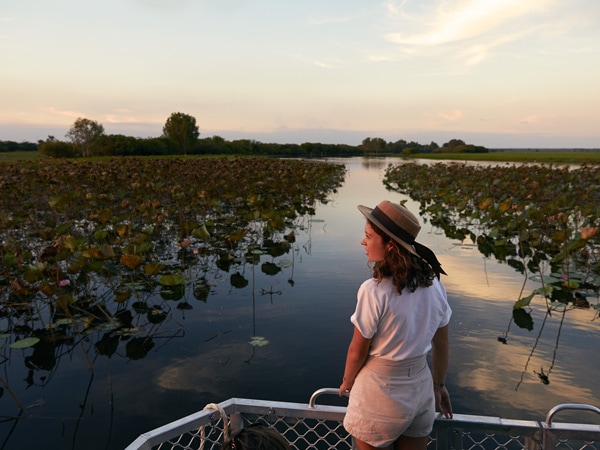
See waterlilies up close. (Image: Tourism NT/Matt Cherubino)
You can see many of Kakadu’s birds: jabiru, sea eagles, magpie geese and egrets. Cruises operate all year round; in the dry season, you can also explore the billabong on foot, via boardwalks.
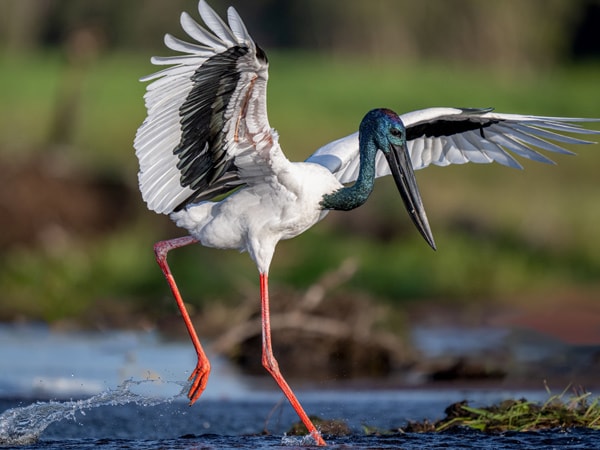
The impressive jabiru resides in Kakadu wetlands. (Image: NT/ Paul Thomsen)
If you’re after other cruises or tours in Kakadu, we’ve rounded up a guide to the best tours in Kakadu National Park.
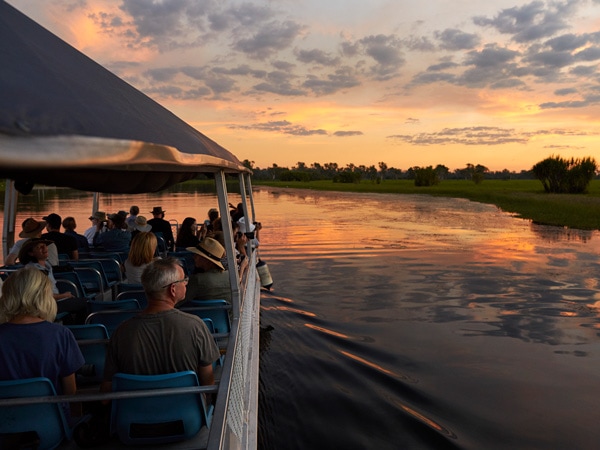
Soak up majestic sunset views during the Yellow Water Billabong Cruise. (Image: Tourism NT/Matt Cherubino)
Access information
Via 2WD in the dry (you can drive virtually up to the boat ramp); in the wet, you simply drive to the nearby hotel and hub Cooinda Lodge and hop on a shuttle bus.
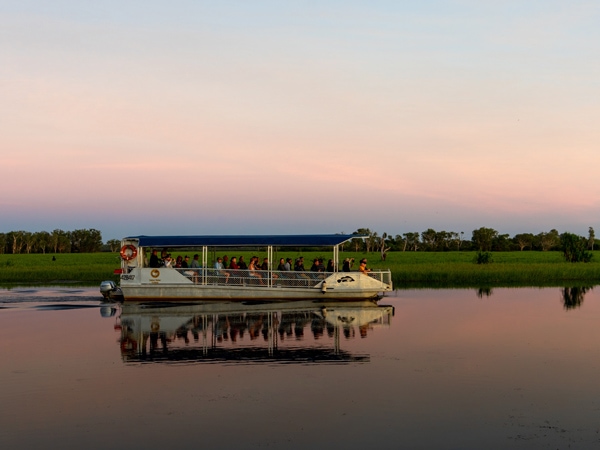
Hop on a Yellow Water Billabong cruise. (Image: Tourism NT/Bronte Stephens)
2. Watch the sunset at Nawurlandja Lookout
Best for: Travellers seeking serene vistas or photographers looking for a postcard-perfect shot
Nawurlandja lookout attracts locals, visitors and snap-happy photographers during golden hour, seeking the best vantage point to admire the surrounding rock formations as the escarpment starts to glow while the sun sets behind the vista.
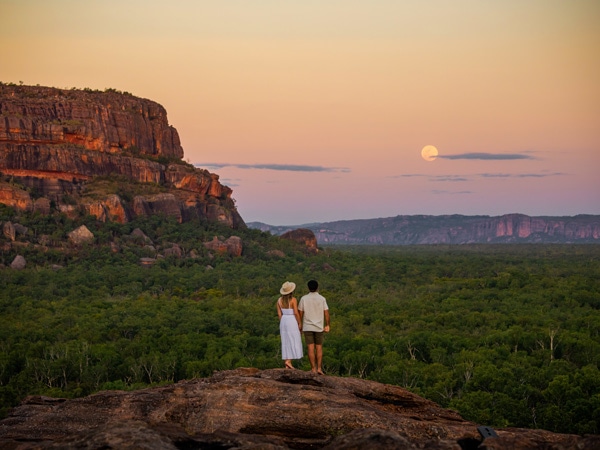
Take in breathtaking sights from Nawurlandja Lookout. (Image: Tourism NT/Kyle Hunter & Hayley Anderson)
Walk up the 300-metre incline for sweeping views over Anbangbang Billabong and towards Arnhem Land . Have your camera ready, this is one of the most picturesque spots in the park, especially when the sun starts to set.
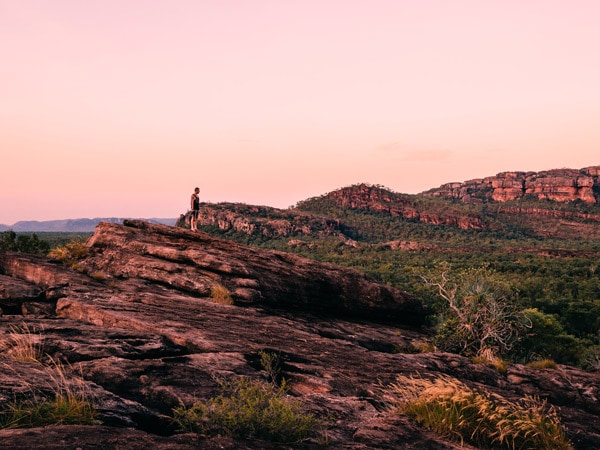
Hike up the rocky and rugged plains of Nawurlandja. (Image: Tourism NT/Jewels Lynch)
3. Swim at Maguk
Best for: Active and adventurous traveller seeking off-the-beaten-path experiences
Of all the things to do in Kakadu, a swim at Maguk is one of the more under-the-radar activities, despite being absolutely stunning. It’s only an hour’s drive south of Cooinda Lodge (one of Kakadu’s popular accommodation options ), but you’ll need to turn off the sealed highway and drive a 14-kilometre, 4WD-only track, then walk a kilometre to get here.
The effort required makes this one of the Park’s lesser-visited natural plunge pools, but it’s gorgeous to swim in, and the walk-in, via a beautiful creek and classic pandanus forest, is truly lovely. A short but steep climb will get you to the top of its waterfall, where more pools await you.
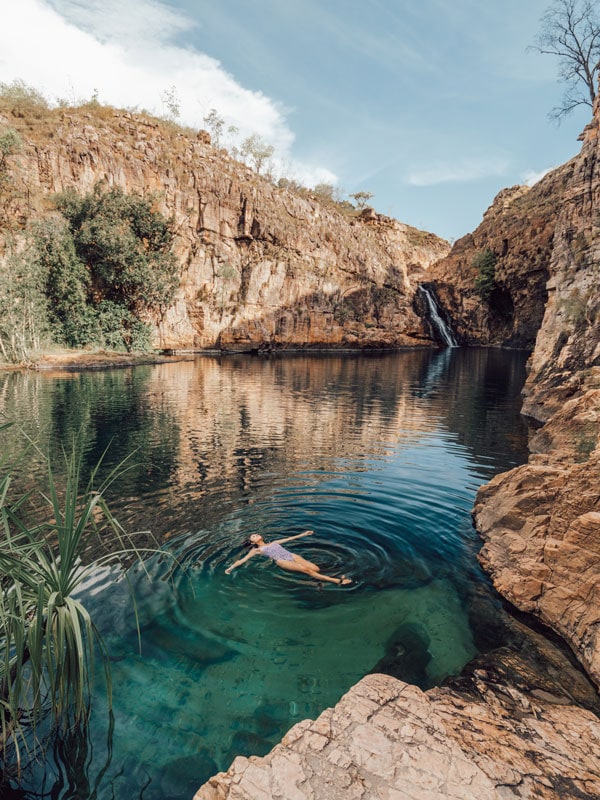
Relax on the refreshing waters of Barramundi Gorge (Maguk). (Image: Tourism NT/Adriana Alvarado)
Via 4WD in the dry; then it’s a two-kilometre, easy-to-moderate, return walk. Maguk is inaccessible in the wet.
4. Admire Kakadu rock art at Ubirr
Best For: Anyone curious about local culture
Ubirr is one of the most famous rock art sites in Kakadu . A kilometre-long circular walk from the car park takes in the Main Gallery, the Namarrgarn Sisters Gallery and the Rainbow Serpent Gallery, with the dates of art ranging from over 15,000 years old to as recent as 150 years ago.
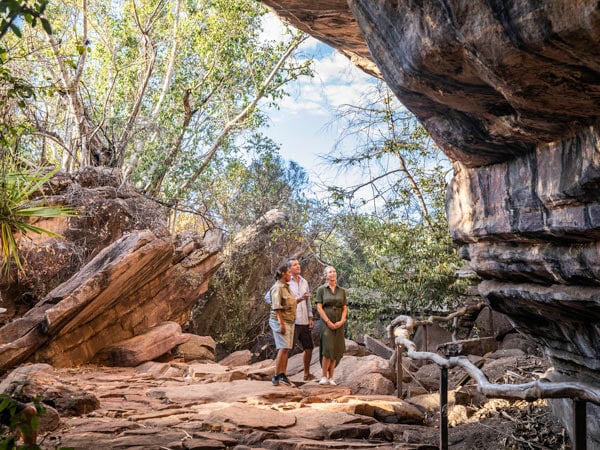
Join a cultural walk tour to Ubirr. (Image: Tourism NT/Helen Orr)
A visit to Kakadu’s rock art is one of the most educational things to do if you’re interested in Indigenous culture. You’ll witness ‘X-ray’ style paintings of animals and figures from Dreamtime folklore.
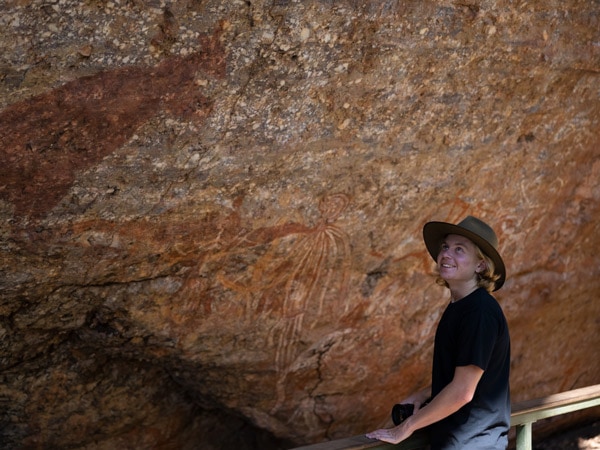
Learn about the Ubirr rock art in Kakadu. (Image: Tourism Australia)
Make sure you take the extra 30-minute moderate climb to Nardab Lookout for excellent sunset views.
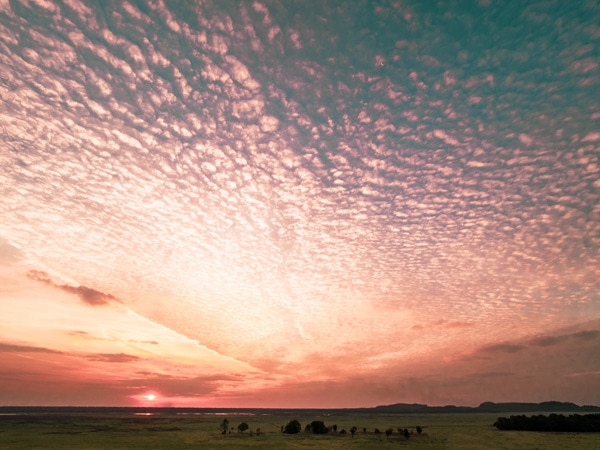
Pastel hues are majestically draped over the sky. (Image: Tourism NT/Jewels Lynch)
Via 2WD in the dry (though check road conditions early in the season). The circular track is partly wheelchair accessible. In the wet, only 4WDs can drive here; if 4WD access is also closed due to flooding, you might be lucky enough to access the site via boat, on a wet season Guluyambi Cultural Cruise.
5. See the famous Burrungkuy (Nourlangie) rock art
Best for: Anyone curious about local culture
The second of Kakadu’s most famous rock art sites, the well-preserved area of Burrungkuy (Nourlangie) offers spectacular views and a fascinating window into local Aboriginal culture. You’ll need 90–120 minutes to tour the multiple art sites, along a 1.5-kilometre circular walk that also includes the Anbangbang Shelter, providing refuge from the weather for 20,000 years for locals who whiled away the time by decorating the walls with their stories.
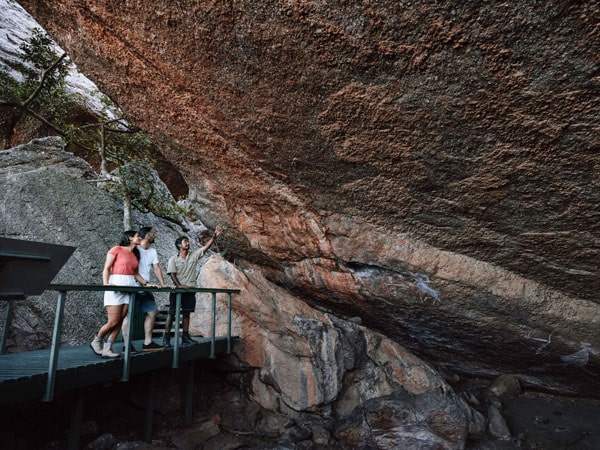
Seeing the World Heritage-listed Nourlangie Rock Art up close is a powerful experience. (Image: Tourism NT/Shaana McNaught)
If you want to enrich your knowledge and experience of Kakadu’s rock art, Yibekka Rock Art Tours is a fantastic local offering. Their Indigenous guides lead tours to Burrungkuy, sharing the incredible stories behind the rock art and the Dreaming stories held within the landscape.
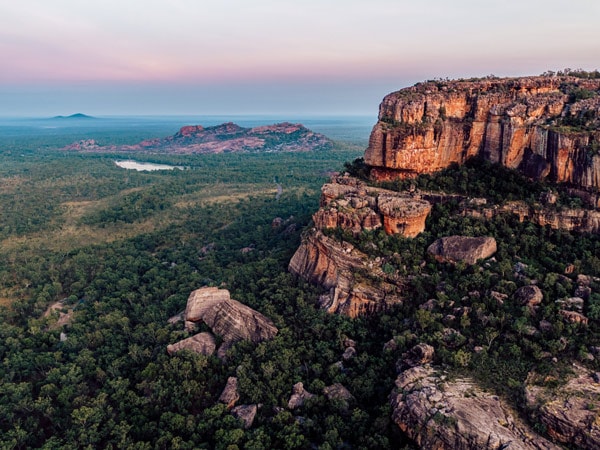
Nourlangie is one of Kakadu’s most famous rock art sites. (Image: Tourism Australia)
Via 2WD, year-round. The 1.5-kilometre walk is easy; the 600-metre climb to the lookout is moderately steep.
6. Check out Jim Jim Falls and Twin Falls
Best for: Travellers seeking a swim and some show-stopping scenery
No visit is complete without seeing Kakadu’s beautiful waterfalls – they’re key to the massive movement of water that marks the seasons . However close to each other geographically, they’re actually very different. Jim Jim Falls features vertiginous 150-metre-high cliffs surrounding a beautiful, deep plunge pool, and flows only after the wet season.
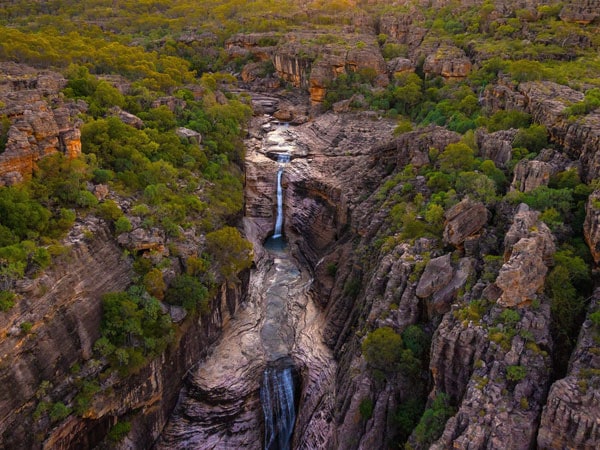
Jim Jim Falls looks stunning from above. (Image: Tourism Australia)
You can swim there in the top pool during the dry season and admire the unexpected presence of silica sand – this area was once an inland sea. Kakadu’s Twin Falls are in spectacular flow all year round, continuously gushing over a 220-metre drop onto the beach below.
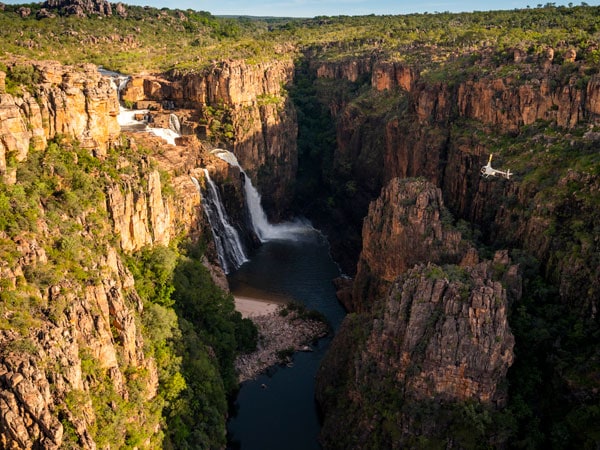
Appreciate the stunning beauty of Twin Falls. (Image: Tourism NT)
Twin Falls has a very pretty plunge pool, but you can’t swim here; saltwater crocodiles do occasionally make their home here. The plateau above it is safe for swimming, though, and well worth the hike up.
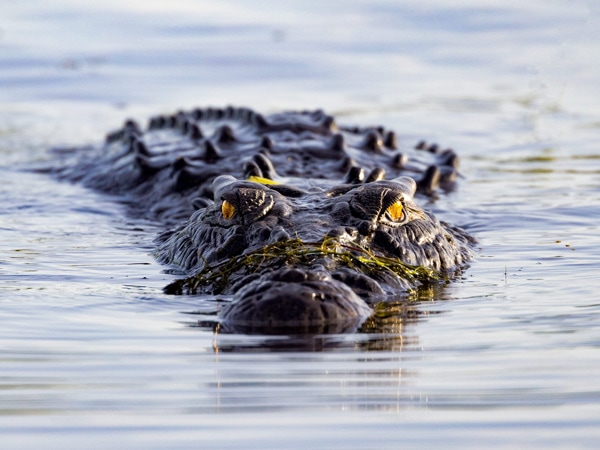
Spot saltwater crocodiles within Kakadu National Park. (Image: Tourism Australia)
You can get to Jim Jim Falls via 4WD in the dry season. From the car park, take a moderately difficult 45-minute walk over boulders to the top plunge pool where you can swim. To get to Twin Falls you’ll need a snorkel on your vehicle to get through a 0.8-metre water crossing. You then board a shuttle boat from the car park, which takes you up the gorge, before a short walk to the falls themselves.
7. Take one of the Yurmikmik Walks
Best for: Nature lovers and travellers looking to get active
The Yurmikmik walks are a series of interconnected trails exploring the wilds of the park’s southern region, and they are underutilised, underrated, local favourites. These trails are especially beautiful during the wet season, when the landscape becomes lush with greenery. You’ll also likely spot an abundance of wildlife, from wallaroos to cockatoos and finches.
The two-kilometre-return Boulder Creek Walk runs through monsoon forest and woodlands; the five-kilometre return walk to Yurmikmik Lookout takes you to the ridge for fantastic views over Yurmikmik country (pack your camera).
The 7.5-kilometre return Motor Car Falls Walk journeys along a historical track through to shady creeks and rainforest; and the ultimate Kakadu walking experience, is the 14-kilometre overnight Motor Car and Kurrundie Creek circuit, with some sections best navigated by GPS and compass (you’ll need a permit to camp here).
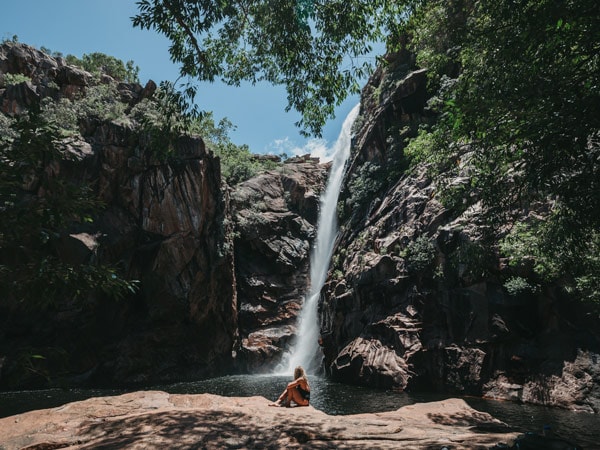
Take a refreshing dip at Motor Car Falls. (Image: Tourism NT/Jarrad Seng)
Via 4WD year-round. The area may be closed due to flooding in the wet.
8. Visit Mamukala Wetlands
Best for: Nature lovers and birdwatching enthusiasts
A hugely important part of Kakadu is its birdlife, and Mamukala has a bird hide shelter where you can have some quiet time and really enjoy the sight of thousands of magpie geese (particularly from September–October) coming together to feed, undisturbed.
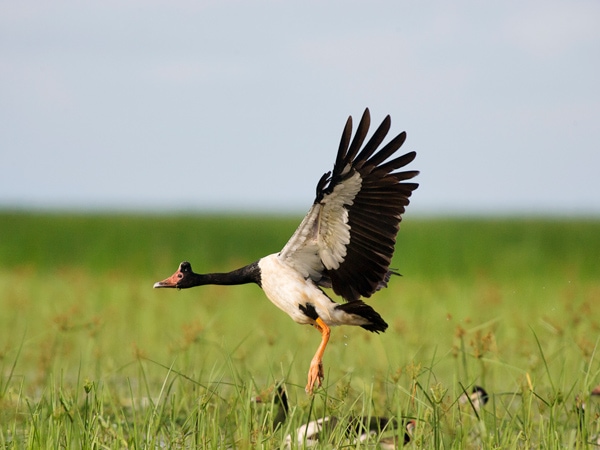
Visitors flick to Kakadu to admire the birdlife, including magpie geese. (Image: Bamurru Plains)
Take a self-guided tour on the nearby walks, ranging from one to four kilometres; the three-kilometre walk alongside the wetlands is ideal to enjoy the paperbarks, pandanus and water lilies. Beautiful and accessible for most of the year, it’s most dramatic in the late wet season when birds congregate in their thousands.
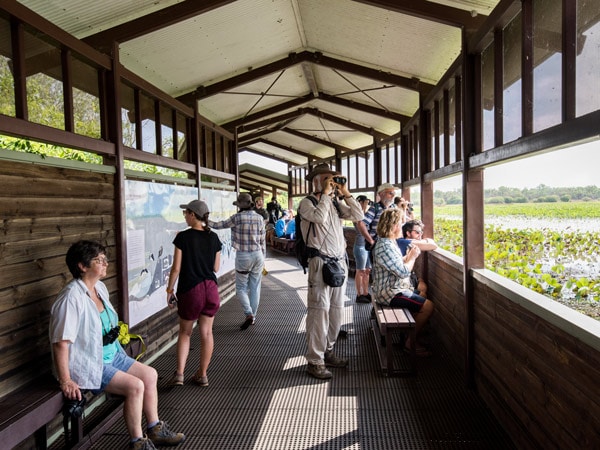
Birdwatchers gather at the Kakadu Bird Week. (Image: Tourism NT/Navin Chandr)
Via 2WD year-round, although the area may be closed due to flooding in the wet. The bird hide is accessible by wheelchair, 500-metre return; the three-kilometre loop walk is rated easy.
9. Kakadu Full Moon Feast
Best For: Foodies and culturally curious travellers
Did you know, there are six Indigenous seasons in Kakadu ? Bininj chef Ben Tyler of Kakadu Kitchen is serving up a taste of each season with Kakadu Full Moon Feast.
The feast is an unmissable dining experience held six times per year, pulling together native and foraged ingredients where guests can experience the flavours of Country and culture. In addition, the meals are accompanied by non-alcoholic beverages made with unique bush ingredients like lime leaf and green ants.
Hosted at Cooinda Lodge, the Kakadu Full Moon Feast is a great way to learn about Bininj culture and indulge in an unforgettable night of food. For lovers of good food, this is one of the best things to do in Kakadu. If your stay aligns with the feast schedule, make sure you don’t miss out!
10. Scenic Flights
Best for: Anyone with an adventurous streak
If breathtaking scenery is what you’re after, then a scenic flight is one of the best things to do in Kakadu. Take to the skies for a bird’s eye view of the UNESCO World Heritage-listed Kakadu wetlands. Seeing Kakadu from a scenic helicopter – with the doors off – you’ll be treated to an unforgettable panorama.
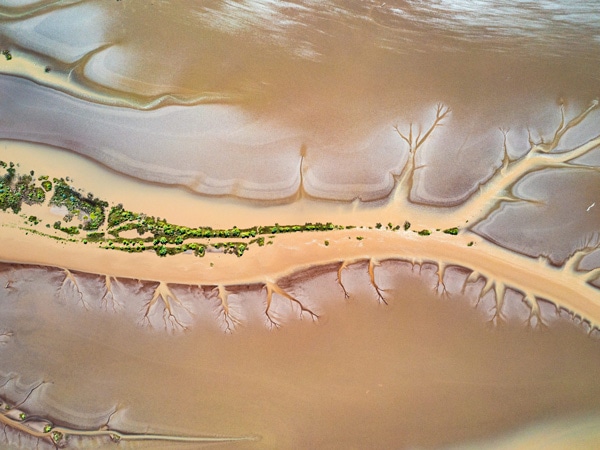
Venture across Kakadu on a helicopter. (Image: Tourism Australia)
Rise above verdant savannah woodlands, whizz past rocky escarpments and soar over exposed rocks that make up some of the world’s oldest. Watch magnificent waterfalls come into view, so close that you can almost feel the spray.
Kakadu Air Services are a local operator have scenic flights ranging from 20 minutes to an hour, and the Scenic Flight Company have flight options ranging from 30 minutes to 1 hr 45 minutes. A Kakadu scenic flight is the best way to witness the landscape and get your adrenaline pumping, too.
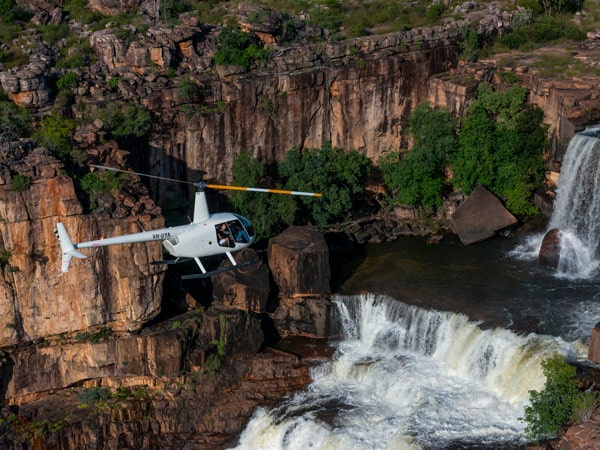
Take a scenic flight above Jim Jim Falls. (Image: Tourism NT)
Flights depart from the townships of Jabiru, Cooinda or Darwin.
If you’re planning a trip to Kakadu National Park, we’ve rounded up everything you need to know before you go .
Elizabeth Whitehead has been a travel writer since she realised the most interesting stories are the ones about the world we live in. When she’s not writing, you’ll find her baking focaccia, birdwatching or exploring in her campervan.

LEAVE YOUR COMMENT
Cancel reply.
Save my name, email, and website in this browser for the next time I comment.
Comments (2)
Awesome info, thank you!!
I was there it is beautiful, even no more beautiful than in the photos
You might also like
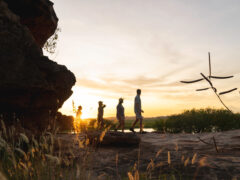
9 immersive Kakadu tours you must experience
Kakadu is not only steeped in natural beauty – it also holds 65,000 years of Indigenous history. Choosing which tours to do in Kakadu National Park...
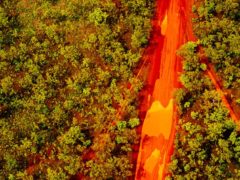
How to road trip Kakadu and itineraries for visiting
There’s no shortage of great tours on offer in Kakadu, but a do-it-yourself driving adventure holiday is pretty hard to beat, says Lee Atkinson The...
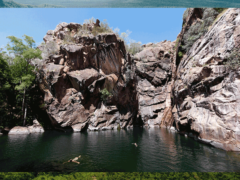
Yes, you should go to Kakadu in Wet Season
Myth has it that Kakadu is best visited during the calm and cloudless dry season. But intense weather seeds surprise, adventure and new life. We go in...
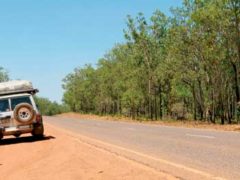
West Alligator Head Camping Adventure
Australian Traveller looks at the remote camping outpost of West Alligator Head in NT's Kakadu National Park. When it comes to camping, we’ve tried...
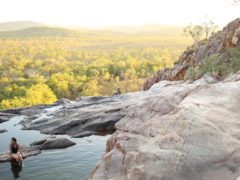
The best routes for walking and hiking in Kakadu
Kakadu National Park is a mini-world that’s better explored on foot than on wheels, and better swum inside than feared from the water’s edge. Here...
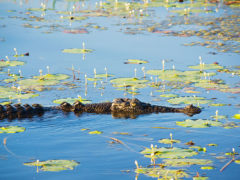
Kakadu FAQs: How, where & the wet season conundrum
Wet season or dry season? Kids or no kids? Walk or drive? Kakadu Tours or self guided? These are just some of the most frequent Kakadu questions we ...

© Australian Traveller Media 2024. All rights reserved.

The Ultimate Trip to Darwin, Litchfield and Kakadu.

One of our awesome Ultimate Travel gurus Holly Walker recently had the trip of a lifetime to the Northern Territory. Flying to Darwin from Sydney, Holly took part in a 4 wheel drive Dragonfly dreaming tour with Wayoutback Australian Safaris .
In Darwin, Holly stayed in the Youthshack hostel before heading into the national parks of Kakadu and Litchfield. Here is a rundown of what she did….
You flew up from Sydney to Darwin, which must be great this time of year as we are just heading into winter but they are just going into dry season?
It was brilliant timing! I left Sydney on a Wednesday and flew the 4 and a quarter hours to Darwin. The weather was absolutely amazing during the day (30-35 degrees) but it did rain for a couple of hours overnight. It’s just coming into dry season so it should stay dry for the next 5-6 months so now is the perfect time to head north.
After you arrived in Darwin and got checked in to your hostel, I hear you did something awesome before the tour even started?
You heard right, this isn’t normally included on the tour but if you were to spend a day either side of the tour in Darwin you could easily fit it in and it was incredible!
We visited Crocosaurus Cove for a ‘Cage of Death’ crocodile experience. This is pretty much as terrifying as it sounds but it is a once-in-a-lifetime opportunity to swim with saltwater crocodiles!
We got into our swimming gear and tried to keep down the butterflies that were careening around our stomachs and headed into the cage! This involved being lowered into the water in a tank to get up close and personal to the ‘Kate and Will’ two of the resident crocs at Crocosaurus Cove.
That sounds amazing and terrifying all at the same time! What did you do on that first evening, did you meet up with your group?
Yes, we all got together in the evening and we visited Mindil markets in Darwin to have a look around the numerous food, jewelry, trinket and aboriginal art stalls. We chilled on the beach with a few drinks, eating food from the markets whilst watching the amazing Darwin sunset.
Honestly, I’ll never forget that sunset it was truly spectacular. The way the sun dipped into the ocean was like something out of a bad romantic comedy. I took about 400 photos of it so it looks like a flick-book when you go through my Facebook album!
The next day, your big trip began. Can you give us an itinerary of what you did?
We started off the tour in Litchfield National Park exploring waterfalls such as Florence and Wangi falls. We also went to see some termite mounds between swims which was pretty cool.
We stopped off for lunch at a permanent campsite before heading to an indigenous cultural centre (a wooden construction with a cloth over the top for shade), here our aboriginal guide Graham talked us through the aboriginal history and culture.
He told us stories of ‘dreamtime,’ which is the name for the Aboriginal belief system and he discussed the way of life in aboriginal communities. We were also shown basket weaving and spear throwing.
We arrived at our campsite in the Mary River region early evening for dinner, a good old fashioned BBQ, and spent the evening searching for local wildlife, having a few drinks and counting shooting stars which was absolutely beautiful.
The next morning we went on cruise of the a Mary River wetlands. The wetlands are made up of lagoons, canals and billabongs. We saw crocodiles in their natural habitat, as the Northern Territory has the highest concentration of saltwater crocs in the world, a vast variety of birdlife (trying to not be eaten by the crocs!) and lots of beautiful scenery and flora including the beautiful water lilies and lily pads.
We then did some 4 wheel driving along the dirt tracks in Kakadu National Park which was immense! We reached Gunlom falls and hiked up to the top of the waterfall before spending the next few hours relaxing in the infinity pool and other plunge pools overlooking Kakadu. We then headed towards a different campsite to spend the night. Both campsites are permanent with access to hot showers and toilets. All tents were permanent and equipped with beds.
We started off the last day by taking a short hike up to Nawurlandja lookout overlooking Nourlangie and Anbangbang Billabong. We were then given the option of taking a scenic flight (at own expense) over Kakadu National Park to check out Jim Jim and Twin falls before heading to Ubirr for lunch.
At Ubirr we viewed a wide range of ancient aboriginal art and rock paintings which were interpreted by our guide. This was quite a unique experience, having someone who was able to tell us what these paintings mean after thousands of years was a really powerful moment.
We hiked up to the Nadab lookout for panoramic views over the floodplains and into Arnhemland. En route back to Darwin we stopped off at the famous ‘Humpty Doo Hotel’ for a drink to end our top end tour.
Wow. That sounds absolutely awesome! It’s crazy how much you can fit in one trip! I know it’ll be difficult but does anything stand out as your favourite bit?
Gunlom falls infinity pool is like nothing I’ve ever seen. It is a natural rock formation that has to be seen to be believed. Sitting in the cool waters looking out over a the breathtaking view is something I’ll never forget. The photos look awesome on Instagram too!
The Mary River wetlands cruise was great as well, seeing those crocodiles and imagining what was going on beneath the surface! The stargazing at the campsites (I’ve never seen so many stars!) was incredible too. Kakadu and Litchfield are some of the least populated areas of Australia and you really get a feeling for how vast the country is when you are alone with your group in the middle of nowhere!
Nadab lookout overlooking Arnhemland was awesome too and the sunset at the Mindil markets in Darwin was also amazing. As you can tell, it was a trip with a lot of highlights!
It sounds like it! Did anything surprise you? Did you enjoy anything more than you thought or was it all as you expected?
I was surprised how big Kakadu National Park actually is, it is as big as country (Slovenia, to be precise). You can drive along the dirt roads for hours without seeing anyone else!
I also realised how little I knew about aboriginal culture and learnt lots of interesting facts from the aboriginal cultural centre we visited. I was shocked driving past bush fires at the side of the road and to learn that parts of the national park are burnt by local aboriginal communities to maintain the land as well as being caused by the dry heat within the national parks.
I know you mentioned the crocodiles but you must have seen some other cool wildlife while you were in the outback?
I saw lots of crocs in their natural habitat which was awesome. I came across loads of frogs and toads, a huntsman spider, some wild donkeys and a random albino buffalo!
We also spotted two owls at the first campsite we stayed at and I accidentally ate a mosquito (its family nearly bit me to death after that). All in all there was lots of interaction with wild animals and insects!
If you like the sound of the trip that Holly was lucky enough to go on, get in touch with us on [email protected]
You might also like

Fantastic,travel blog.Most tourists go and visit the east coast of Australia but never visit Northen territory This is where Australia really shines and travellers will be shell shocked because of northern territories immense beauty.
Hey Louisa,thanks! We agree, the East Coast is fantastic but Australia has so much to offer that a lot of people don’t get to see … it’s our mission to get them to all these hidden gems! :0)
Leave a Reply
Leave a reply cancel reply.
Your email address will not be published. Required fields are marked *
AGENT PORTAL CONTENT CORNER/AMBASSADORS RESPONSIBLE TRAVEL TOUR PAYMENT GIFT VOUCHERS
ABOUT ULTIMATE
TOUR FAQS CONTACT US VISA INFORMATION COVID SAFE TRAVEL BOOKING & PRIVACY POLICY

Ultimate Adventure Travel Pty Ltd
806 George Street. Sydney, NSW 2000 ABN: 91 133 215 166 Member of WYSE & BOA NSW

get our latest news
Be the first to know about travel deals, destination updates, competitions and more. Unsubsribe anytime.
NEW AGENT REGISTRATION
THANK YOU FOR YOUR INTEREST
IN BECOMING AN ULTIMATE AGENT
WE WILL BE IN TOUCH SHORTLY TO CONFIRM YOUR REGISTRATION AND TO PROVIDE YOU WITH ACCESS TO OUR BOOKING PORTAL. IF YOU HAVE AN URGENT BOOKING TO PROCESS, CONTACT OUR RESERVATIONS TEAM VIA EMAIL OR PHONE
+61 02 9211 7900
ULTIMATE ADVENTURE TRAVEL PTY LTD. 2 Lee St, Sydney, NSW 2000 ABN: 91 133 215 166
ORDER STORE BROCHURES
THANK YOU FOR YOUR REQUEST
WE WILL BE IN TOUCH SHORTLY TO CONFIRM YOUR BROCHURE. YOUR BROCHURES SHOUDL ARRIVE WITHIN 5-7 BUSINESS DAYS. YOU CAN CONTACT US VIA SKYPE OR EMAIL WITH ANY FURTHER QUERIERS. [email protected]
@ULTIMATE.TRAVEL
#TRAVELULTIMATE COMPETITION
TERMS & CONDITIONS OF ENTRY
This Competition is open to all Ultimate Travel customers. Posts must have been published from 01 Jan 2019 onwards, be original content captured or produced by the traveller and must be posted to a personal Instagram account. Qualifying entries must be deemed by Ultimate Travel to reflect the style of Ultimate’s brand and reflect experiences accessible by Ultimate customers. Posts with no association to Ultimate will not qualify. The winning post will be decided at the discretion of Ultimate Adventure Travel Pty Ltd. If you qualify for a prize, your acceptance of the prize consents Ultimate to a worldwide license to use the image within its marketing material and promotional activities. Entries must include the relevant Ultimate Travel hashtags at the time of posting. These must be clearly displayed and not hidden after bulk text or hashtags. Winners must be following Ultimate Travel on Instagram. Ultimate Travel reserve the right to withdraw and end this competition at any time.
THANK YOU FOR YOUR ENTRY!
YOU'RE NOW IN THE RUNNING TO WIN A SPOT ON OUR 10-DAY ULTIMATE BALI TOUR FOR YOU & A MATE!
THE WINNER WILL BE NOTIFIED ON 4TH MARCH 2019.
WANT TO SUBMIT A VIDEO ENTRY? EMAIL [email protected].
FOLLOW US ON INSTAGRAM FOR COMPETITION UPDATES!
// APPLY TO BE AN ULTIMATE BRAND AMBASSADOR
HAVE YOU TRAVELLED WITH ULTIMATE BEFORE?
Refer to our privacy policy for information on how your data is used and stored.
THANK YOU FOR YOUR APPLICATION!
A BRAND AMBASSADOR PROGRAM COORDINATOR WILL BE IN TOUCH VIA EMAIL.
PLEASE NOTE, ONLY SUCCESSFUL CANDIDATES WILL BE CONTACTED.
FOLLOW US ON INSTAGRAM @ULTIMATE.TRAVEL
- Kakadu National Park
- Plan your trip

Bowali Visitor Centre. Photo: Shaana McNaught, Tourism NT
Kakadu National Park is open all year round and is a big place, with so much to see and do.
The first thing to consider when planning a trip to Kakadu is what time of year you plan to visit. Whether visiting in the tropical summer or the dry season, Kakadu has plenty to offer. We’ve created a few suggested seasonal itineraries to get you inspired.
The easiest way to get to Kakadu is by coach or by car from Darwin or Katherine. You will need a vehicle to get around the park, or you can join a coach or 4WD tour.
This page has information on our visitor centres, where to stay, what to pack, places to eat, facilities, internet access, and links to the passes and permits you may need while staying in the park. You can also download our visitor guide for an in-depth introduction to visiting Kakadu.
Make sure you read our tips for staying safe in the park.
You can also subscribe to our Kakadu Ranger tips emails. Through a short series of messages from our rangers, you’ll be well on your way to the adventure of a lifetime!
Buy your park pass
Download the Kakadu Visitor Guide to get all the info about visiting Australia’s national park.
Download the Holiday Planner for a snapshot of the park and larger map.
Start planning your trip today

Take the first step
A journey of 1000 miles begins with a single click.
Enter your email to get free trip planning advice from Kakadu rangers.
- Australian Government, Parks Australia
- Kakadu is dual-listed on the UNESCO World Heritage List for its outstanding natural and cultural values
- Gold, Major Tourist Attraction, 2017 Australian Tourism Awards
- Buy park pass
- Discover Kakadu
- For schools
- Things to do
- Itineraries
- Shops and facilities
- Ranger tips
- When to come
- Getting here
- Park passes
- Visitor centres
- Where to stay
- Hotels and cabins
- News and alerts
- Latest news
- Kakadu Access Report
- Media centre
- Frequently asked questions
- Growing Tourism in Kakadu
- Norfolk Island
- Christmas Island
- Pulu Keeling
- Australian National Botanic Gardens
- Australian Marine Parks
© 2013–2024 Parks Australia (Commonwealth of Australia)
We acknowledge the Traditional Owners of country throughout Australia and recognise their continuing connection to land, waters and culture. We pay our respects to their Elders past, present and emerging.
- Our Travel Map
- Philippines
- Search for:
Kakadu National Park Travel Blog

Kakadu National Park is one of the most prominent national parks in the Australian state of Northern Territory. At around 20,000km 2 , Kakadu is nearly half the landmass of Switzerland. Within this natural paradise lies a diverse range of landscapes including savanna woodlands, wetlands and sandstone ridges. An astonishing number of plants and wildlife (e.g. saltwater crocodiles, flatback turtles) resides here. Against this backdrop of geographical and wildlife wonders, the Aboriginal people had called Kakadu home for more than 65,000 years. In this Kakadu National Park Travel Blog, let us share with you how to best plan for your Kakadu trip. And what are the must-see attractions of the park!
Go ahead and share this blog with your travel buddies!
- Things to do in Darwin (Northern Territory, Australia)
- Litchfield National Park Travel Blog (Northern Territory, Australia)
- Nitmiluk National Park Travel Blog (Northern Territory, Australia)
Tip: Need helping planning your itinerary? See our blog “ 10-Days Itinerary for Darwin and Northern Territory “
Advertisements

Kakadu National Park is located an easy 3 hours’ drive (171km) southeast of Darwin. Which is the capital city of Northern Territory. The park is open year round. Though certain parts can be inaccessible due to flooding during the summer (wet) season
Other than its’ geographical and zoological aspects, Kakadu is steeped in cultural values. The Aboriginals, whom are widely recognized as the world’s oldest living culture, had resided in this region for millennia. And in the process, they managed to turn Kakadu into a massive art gallery. As evidenced by the more than 5,000 rock art sites scattered around the park.
It is with this unique combination of natural and cultural values, that Kakadu National Park was awarded dual listings in the UNESCO World Heritage list.
In the following sections, we’ll be discussing about the various aspects of planning a Kakadu trip. Plus the not-to-be-missed attractions on your visit.
*This Kakadu National Park Travel Blog is based on our Jun-2018 visit to Kakadu.
For all self-drive trips to Kakadu National Park, it is important to consider if the trip will be done via 2WD or 4WD vehicles. This is because certain sections of Kakadu are only accessible via 4WD. This is specifically the case for all the waterfalls within Kakadu National Park, which are served only by gravel roads.
Before our trip to Kakadu, we took the effort to email the park rangers regarding which waterfall we could access (in winter) if visiting via a 2WD vehicle. In reply, we were advised that all waterfalls within Kakadu National Park are only accessible via 4WD tracks.
Fortunately, there are still plenty of attractions within Kakadu National Park that are suitable for those visiting in 2WD vehicles. Including the various rock art sites, cruises, guided tours, lookout points etc. Thus, if you’re only able to visit via a 2WD vehicle (like us), do not let this be a deal breaker. Kakadu is definitely still worth visiting!

Insurance coverage for rental vehicles
Do note that if you’re renting a vehicle for your visit, most car/campervan rental companies’ insurance will not cover your vehicle on unpaved (gravel) roads. This holds true even if you’ve rented a 4WD vehicle.
Based on our experience, only a select few car/campervan rental companies would have insurance for off-road driving. And even in these handfuls of companies, some might have clauses in their insurance specifying that certain roads (e.g. in Kakadu) are excluded from their coverage.
Thus, it is paramount that you check with your car/campervan rental company to ensure that the specific unpaved road that you’re planning to travel on is indeed covered in the insurance policy.

Click here for high resolution photos
Renting Cars vs. Campervan
We assume most folks are aware of the common pros/cons for renting cars vs. campervans (e.g. driving speed, comfort, safety, convenience, cost). In this section, we’ll talk about 2 aspects that are particularly relevant to renting in the Northern Territory. (If you’re new to campervans, refer to our blog about campervans here )
#1: Limited Mileage
If you’ve done your research, you’ll noticed that most car rental companies operating in Northern Territory will only include a daily mileage of 200km. This is unlike car rentals in other parts of Australia where unlimited mileage is more common.
With the long distances associated with most attractions and national parks within Northern Territory, it is common for renters to exceed this limit. So be aware while planning your trip.
In contrast, all the campervan rental companies in the state still offer unlimited mileage for their vehicles. As such, if you’re extremely concerned with the potential mileage of your trip, it might be better off renting a campervan.
#2: Accommodation cost
For an area as vast as Kakadu National Park, accommodation options are actually quite limited. Usual resort/hotel styled accommodations numbered slightly more than a handful in the park. Thus, be prepared to pay top dollar for your stay and book well in advance. Especially so for the peak winter (dry) season.
This brings us to the point of renting a campervan for your Kakadu trip. As far as accommodations (and meals) are concerned, visiting Kakadu via a campervan and staying in campgrounds is one of the cheapest and most interesting way to explore the park.
There are about two-dozen campgrounds scattered across Kakadu National Park. Each with varying level of facilities. Ranging from commercial campgrounds with full-fledged amenities, to bush camping sites with no facilities and only accessible via 4WD tracks.
It is usually not required to make bookings for the campgrounds (even for commercial ones). However, do ensure that you arrive early on the day to take a site. This especially so during the peak seasons.
In general, commercial campground fees are slightly higher in Northern Territory as compared to other states. This holds true for the commercial campgrounds in Kakadu National Park. During peak season, get ready to pay above $50 per night for a family of 3 on a powered site.
Having said, staying in a campervan (and commercial campground) is still much cheaper compared to regular resort/hotel accommodations in Kakadu.
Review: Kakadu Lodge (commercial campground)
For our trip, we opted to stay at Kakadu Lodge . This commercial campground is one of the better ones in Kakadu National Park. In addition, it is conveniently located in Jabiru, thus allowing convenient access to the nearby petrol station and supermarket.
The campground has a big pool and good facilities. There are plenty of shades on the grass lots. Ablution blocks are well spaced, simple and clean. However, this does mean paying around $50-$55 per night for a powered site for 2 adults and 1 child. (Note: Bookings at Kakadu Lodge are only required for rooms/cabins. No bookings required for camping.)
Link to Kakadu Lodge ( Disclosure: The links to Kakadu Lodge are affiliated links. It will cost nothing to you, but we do receive a small fee if you book through these links. This small fee will go a long way to help us maintain this blog.)

Setting up our tent at Kakadu Lodge
Summary: Cars vs Campervans
Since most campervans are 2WD, it again triggers the concerns of 2WD vehicles as in the previous section. Thus, consider all the elements mentioned in the above two sections and decide which is the best mode of transport for your Kakadu trip.
Advertisements
Why we choose a rental 2WD Campervan
While planning for our Jun-2018 trip, we had initially tried to look for a 4WD rental that has insurance coverage for the off-road tracks in Kakadu National Park. However, it quickly became clear to us that such rentals are hard to come by, or that the costs are prohibitive.
As such, we decided to forgo the waterfalls (which requires 4WD access) and instead focus on the 2WD accessible attractions within Kakadu National Park.
Having a relatively cheap 2WD campervan (and staying in commercial campgrounds) allowed us to save on accommodations. And equally important is that we could cook our meals in the campervan and thus save on our meals. Last but not least, with our campervan on unlimited mileage rental, we do not have to fret over our travelling distance.

Park Pass and Visitor Centres
Park Passes are required. They could be purchased online or from the visitor centres and selected accommodations in the area.
Park passes are valid for 7 days, and can be extended free for up to 14 days. The rates vary across seasons, with the summer (wet) season (Nov-May) generally cheaper.
Example: Kakadu Park Pass for Dry Season 2018 (May-Oct)
Adult (>16yrs) $40. Child (5-15yrs) $20. Family (2 adult, 2 child) $100.

There are two visitor centres in Kakadu National Park; Bowali Visitor Centre and Warradjan Aboriginal Cultural Centre.
– Bowali Visitor Centre : Located 5 minutes’ drive from Jabiru town.
– Warradjan Aboriginal Cultural Centre : Located in Cooinda, near to Yellow Water Cruise.
Regardless of how one purchase their park passes, we strongly recommend a visit to the visitor centre at the start of the trip. Reason is that the park rangers have the most updated knowledge of the road/weather conditions and general situation (e.g. controlled burning) in the park. And thus, could offer recommendations on the most appropriate activity/attraction.
This is especially so if one is visiting Kakadu in a 2WD vehicle or during the wet season. Many of the popular attractions (e.g. all waterfalls) in Kakadu National Park can only be accessed via 4WD vehicles (and only during certain season/weather). Thus, a check with the park rangers at the visitor centre could potentially save you from unwanted incidents on the tracks/roads.
-This website shows the daily status of the various attractions in Kakadu National Park.
-Bring along your water bottles to the visitor centres. Water dispensers are available to refill your water supply. It saved us the trouble of boiling/buying water.
Ranger guided activities
Other than access to the park, the park pass includes all ranger guided activities (e.g. guided tours). For the updated list of ranger guided activities, refer to this link .
You are not required to make bookings for the ranger guided activities. Simply show up at the designated start point of the respective activity 10 minutes prior to the stated time.
To get the most out of your visit and learn more about the fascinating cultural/geographical aspects of Kakadu National Park, we recommend taking up a few of these guided activities. It was a pity that we couldn’t join the activities during our Jun-2018 trip due to time constraints. This is something that we’ll surely not miss on our next trip to Kakadu.

Attractions in Kakadu National Park (for 2WD access)
The following is the list of attractions that we explored while in Kakadu National Park (Jun-2018). Park rangers had suggested this list at the start of our visit. The list is especially suited for those travelling in 2WD vehicles and has only 2-3 days to explore the park. Do not miss these attractions on your trip!
Ubirr (Rock Art site)
Undoubtedly one of the most popular sites in Kakadu National Park. Easily accessible via paved roads, Ubirr is famous for its Aboriginal rock art sites, which dates back thousands of years.
More impressively, visitors can easily climb to the top of its sandstone escarpment to have a glorious view of its golden sunset. Which is casted over an expansive landscape of unblock wetlands below. This is surely one of the best sunsets we’ve seen. And this alone is worth our trip to Kakadu. Do not miss this in your Top End trip!

More pictures of Ubirr

Cahills Crossing, East Alligator (Erre) River
A popular fishing site, Cahills Crossing is a submerged river crossing over the East Alligator (Erre) River. Crocodile sightings are frequent in the area. There is a viewing platform next to the crossing and offers great view of both the river and crossing.
The viewing platform offers visitors the interesting sight of local vehicles fording the river. One can even see the remains of two abandoned vehicles slightly downstream from the crossing. A testament to the hazardous nature of the river.

Bardedjilidji Walk
A short drive from Ubirr and Cahills Crossing. Bardedjilidji is a relatively short 2.5km looping walk thru interesting sandstone formations. Part of the walk might be inaccessible during certain season.

Anbangbang Rock Shelter (Burrungkuy/Burrunggui)
A sandstone escarpment with overhanging rock shelters and art sites. The lower section of the escarpment is called “Anbangbang”. While the top of the escarpment is called “Burrungkuy/Burrunggui”.
This area is frequently called “Nourlangie Rock” by mistake. The word “Nourlangie” is derived from “Nawurlandja”. And “Nawurlandja” is actually another escarpment a short walk to the east. Thus, early non-aboriginal visitors to the area mistakenly call the Anbangbang Rock Shelter as Nourlangie Rock.
Anbangbang Rock Shelter has a number of interesting Aboriginal rock art sites. Including depictions of the dangerous spirit of “Nabulwinjbulwinj” and the Lightning Man “Namarrgon”.
At the far end of the tracks is the “Gun-warddehwardde” Lookout point. The climb is easy. And the lookout point offers great views of the entire sandstone escarpment.
Allow around 1-2 hours for this 1.5km loop

More pictures at Anbangbang Rock Shelter

Yellow Water (Ngurrungurrudjba) Wetlands (via Yellow Water Cruise)
The Yellow Water (Ngurrungurrudjba) Wetlands (billabong) is part of the South Alligator River. And can only be explored via the Yellow Water Cruise. Which runs daily cruises of 90 or 120 minutes, plus sunrise/sunset trips.
The cruise captains (guides) will offer informative commentary of the wildlife and landscape in the wetlands. It is the perfect opportunity to view the wildlife in the park up close, including the massive saltwater crocodiles.
Unlike most other crocodile cruises in Northern Territory, there is no feeding of crocodiles (or other wildlife) during the cruise. Thus, maintaining the natural state of the wetland and its inhabitants.
The Yellow Water Cruise is one of the two “authentic” cruises promoted by Kakadu National Park. The other being Guluyambi Cultural Cruise along the East Alligator River (near Ubirr). Which as its name suggest, is more focused on the culture of the Aboriginals and their interaction with the river and its wildlife.
Both the cruises (Yellow Water Cruise and Guluyambi Cultural Cruise) charges similar rates for similar duration cruises. As we’re on a budget, we can only take up one of the two. And we opted for the Yellow Water Cruise (sunset cruise) as we wanted to focus more on the wildlife in the park.
The cruise was excellent with our guide extremely knowledgeable and interesting. Throughout the cruise, the guide managed to locate a good number of birds and land animals. Plus, a couple of enormous saltwater crocodiles. Surely a worthwhile activity to undertake while you’re in Kakadu!

More pictures of Yellow Water Cruise

Kakadu National Park Information Booklet
The following are the various attraction regions within Kakadu National Park. These are scanned images from the park’s information booklet. The booklet can be obtained from the park rangers at both of the visitor centres.
Kakadu National Park Map

Jabiru Region

Key sites: Bowali Visitor Centre, Jabiru Town
Jabiru is the main town in Kakadu National Park. Though small, it has the most basic tourist related amenities and services (e.g. supermarket, petrol station, post office).
Money Saving Tip! Surprisingly, the supermarket in Jabiru is of reasonable size and stock up relatively well. However, as to be expected, the prices here are noticeably higher than in major towns. As such, do stock up on your groceries and basic needs before your trip to Kakadu.
East Alligator (Erre) Region

Key sites: Ubirr Rock Art, East Alligator (Erre) River, Bardedjilidji Walk, Cahills Crossing
Nourlangie (Burrungkuy) Region

Key sites: Nourlangie (Burrungkuy), Anbangbang Billabong
Yellow Water (Ngurrungurrudjba) Region

Key sites: Yellow Water (Ngurrungurrudjba) Wetlands (Yellow Water Cruise), Warradjan Aboriginal Cultural Centre (visitor centre)
Mary River Region

Key sites: Gunlom Falls (4WD recommended)
Note: The trio waterfalls of Gunlom Falls, Jim Jim Falls and Twin Falls are extremely scenic and popular. However, access is strictly via 4WD and in dry season. Do not miss these if you’re visiting in a 4WD and during the correct season.
Access Road to Gunlon Waterfall
Jim Jim Falls and Twin Falls Gorge Region

Key sites: Jim Jim Falls (4WD access only), Twin Falls (4WD access only)

South Alligator Region

Key sites: Mamukala Wetlands, Gungarre Walk
Related posts:
- 10-Days Itinerary for Darwin and Northern Territory
Litchfield National Park to Darwin Self-Drive Time-Lapse
- Top 9 Places to visit in Gold Coast for families with kids
- 11 Great Places to visit in Sydney
- Exploring Western Australia (Best of Perth & Fremantle )
- Exploring Western Australia (Highlights beyond Perth)
- Motorhome & Car Rental (Western Australia)
Subscribe to us
Like what you've just read? Subscribe to our blog via registering your email below! You will receive email notification when there are any new posts.
Email Address
I want to subscribe!
Like it? Share it!
- Click to share on Facebook (Opens in new window)
- Click to share on Pinterest (Opens in new window)
- Click to share on Twitter (Opens in new window)
Similar Posts

Litchfield National Park Travel Blog
Litchfield National Park is the nearest national park to Darwin (Northern Territory, Australia). Although not... Read More

Nitmiluk National Park Travel Blog
Nitmiluk National Park is a popular outback destination in the Australian state of Northern Territory.... Read More

Things to do in Darwin, Australia
A magnificent harbour city that is also the gateway to several world-class national parks, Darwin... Read More

Itinerary for Darwin (Australia)
Darwin (Northern Territory) is Australia’s smallest and northern-most capital city. A laid-back yet colourful coastal... Read More

Motorhome & Car Rental (Western Australia)
6-Berth Motorhome Review (Apollo Motorhome Rental) (Model: Euro Deluxe) Before we even start, ever wondered... Read More

Top Places to visit in Gold Coast for families with kids
Those whom have had to travel with kids will surely comprehend that not all tourist... Read More

GPSmyCity: Self-Guided City Walk App
GPSmyCity – The Self-Guided City Walk app that lets you be your own tour guide!... Read More

Our self-drive journey from Litchfield National Park to Darwin in Jun-2018. We started from Wangi... Read More
Have something to tell us? Leave a comment! Cancel reply
This site uses Akismet to reduce spam. Learn how your comment data is processed .

©Chris Chen/Lonely Planet
Kakadu National Park
There is more than a national park at Kakadu; this place is also a vibrant, living acknowledgement of the elemental link between the Aboriginal custodians, the Bininj/Mungguy, and the country they have nurtured, endured and respected for thousands of generations. Encompassing almost 20,000 sq km (about 200km north–south and 100km east–west), it holds within its boundaries a spectacular ecosystem, periodically scorched and flooded, and mind-blowing ancient rock art.
Attractions
Must-see attractions.

It takes a lot more than the busloads of visitors to disturb Ubirr's inherent majesty and grace. Layers of rock-art paintings, in various styles and from…

Cahill's Crossing
It may be small, but there can be few more dramatic frontiers in Australia. This shallow causeway, which is impassable when the tide's in, crosses the…

Though it's unlikely you'll have dreamy Maguk to yourself, you might time it right to have the glorious natural pool and falls between just a few of you…

Gunlom is a superb escarpment waterfall 40-odd kilometres south of Maguk and 37km along an unsealed, though well-graded, gravel road. The reward is a…

Nardab Lookout
The magnificent Nardab Lookout is a 250m scramble from the main Ubirr rock-art gallery. Surveying the billiard-table-green floodplain and watching the sun…

Nourlangie Area
The sight of this looming outlier of the Arnhem Land escarpment makes it easy to understand its ancient importance to Aboriginal people. Its long, red…

Jim Jim Falls
A sheer 215m drop, Jim Jim is awesome after rain (when it can only be seen from the air), but its waters shrink to a trickle by about June.

Twin Falls flows year-round (no swimming), but half the fun is getting here, involving a little boat trip (adult/child $15/free, 7.30am-5pm, last boat 4pm…
- Skip to primary navigation
- Skip to content
- Skip to primary sidebar
- Skip to footer

Arriving Kakadu National Park
The driving journey from Darwin to Kakadu National Park takes about 3-hr and in between we took the Spectacular Jumping Crocodile Cruise on Adelaide River.
The ultimate destination of the day was Kakadu National Park , a World Heritage listed site that covers a huge area of 19,000 km2, almost twice the size of Switzerland. It is of little wonder that Kakadu National Park is Australia’s largest national park . This timeless landscape of unique biodiversity is teeming with flora and fauna that range from over 2,000 species of plants, millions of migratory birds to endemic and endangered species. The world-class rock art sites of Ubirr and Nourlangie bear testimony to the presence of Aboriginal people who have called Kakadu home for some 50,000 years.
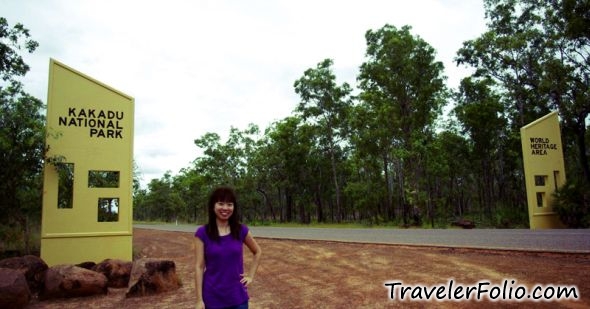
Ranger uranium mine
Along the way, we detoured to catch glimpses of Ranger uranium mine that’s surrounded by Kakadu National Park. Discovered in 1969, the uranium mined is sold for use in nuclear power stations.
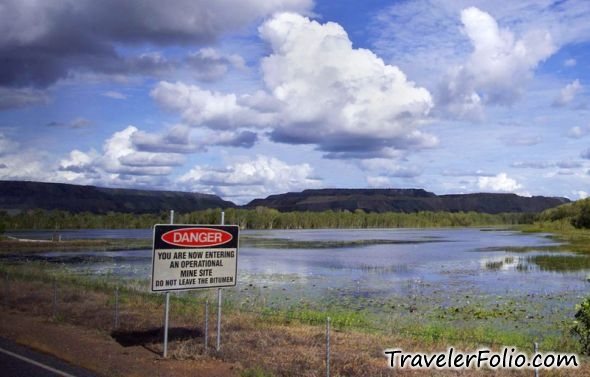
To have an overview of Kakadu National Park, make stops at Bowali Visitor Centre to learn about the landscapes and wildlife of Kakadu, and Warradjan Aboriginal Cultural Centre to understand the indigenous people’s culture through interactive displays.
Bowali Visitor Centre
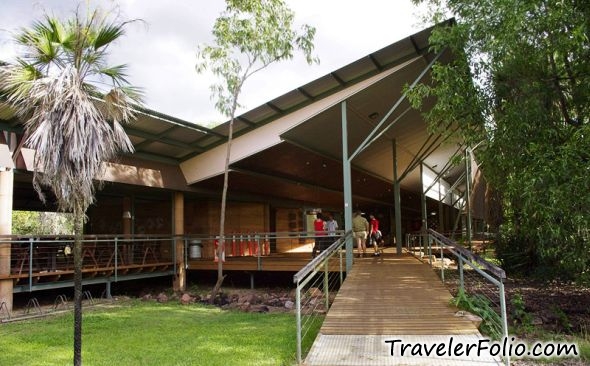
The Bowali Visitors Centre provides two views of Kakadu — Aboriginal and non-Aboriginal views. The centre helps visitors to gain insights of the park through pictorial descriptions and Kakadu’s habitat displays. Information staff are also around to help you plan your Kakadu visit.
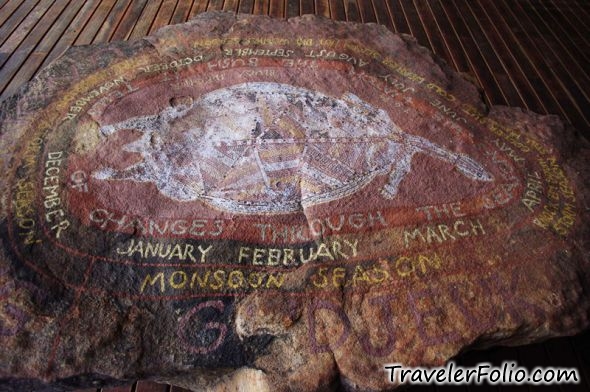
The Aboriginal rock painting that depicts the monsoon season of the region.
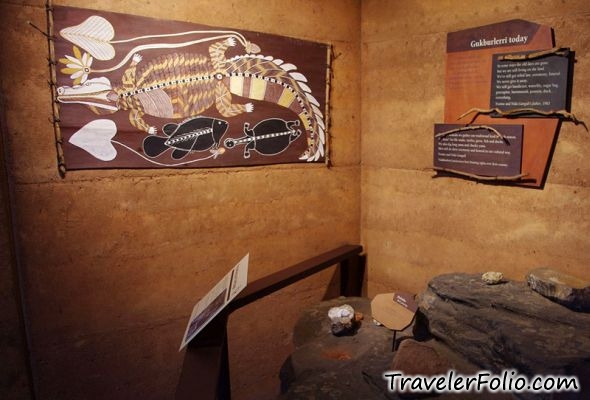
Read a rock! The ripples on this sandstone (Gu-warrde) were created by the currents of a massive river about 1,7 million years ago even before life on the land.
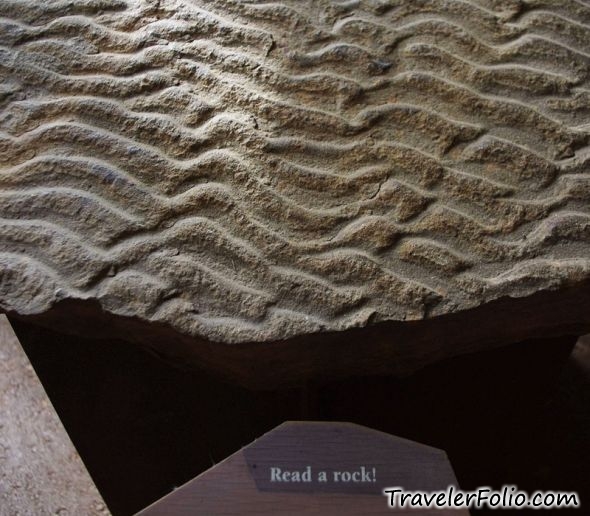
Unique toilet sign!
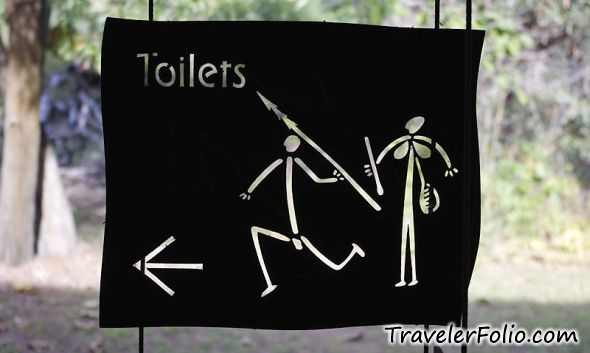
Visitor info on Bowali Visitors Centre Address: Kakadu Highway, Kakadu National Park Website: kakadu.com.au
Where to stay in Kakadu National Park
There are a few lodgings to put up with during your stay in Kakadu National Park. Nestled in the lush green surroundings, Aurora Kakadu Lodge features a lagoon style pool with a poolside bar, bistro and barbeque facilities. Located in less than a 3-hr drive from Darwin, the lodge offers studio cabins, two bedroom cabins, caravan and camping sites. Lakeview Park Kakadu provides self-contained budget accommodation, self-contained cabins, caravans and camp sites in the national park too.
I put up a night at Gagudju Lodge Cooinda . The lodge offers 48 spacious air-conditioned bungalows and each can accommodate up to 4 people. The bungalows are appointed with tea and coffee making facilities, television and other basic amenities. A 3-hr drive from Darwin into the heart of Kakadu, the lodge is the base of the world renowned Yellow Water Cruises, the kind of nature cruises where you may think you are part of the filming crew of National Geographic.
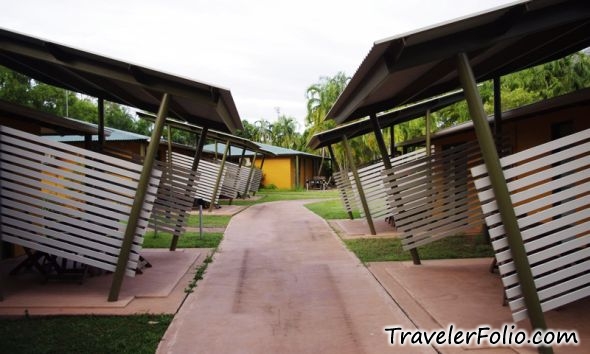
Staying in Gagudju Lodge Cooinda is like living with the wildlife in their natural environment. I was pretty excited to see the beautiful Blue-winged Kookaburra (a species of kingfisher) resting on the branch of a tree near my lodge.
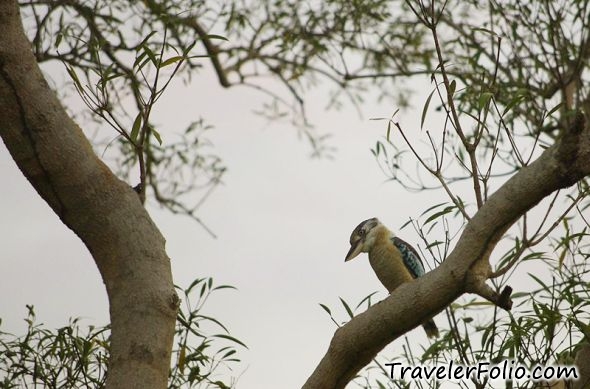
These are WILD horses grazing near the parking lot.
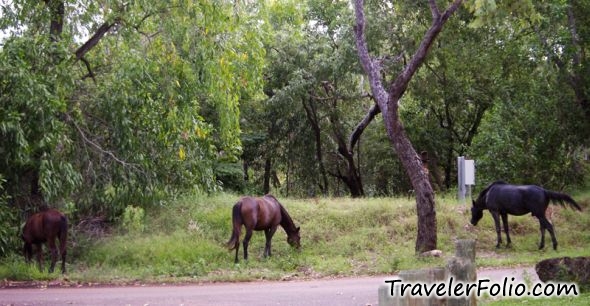
Sunset in Kakadu National Park.
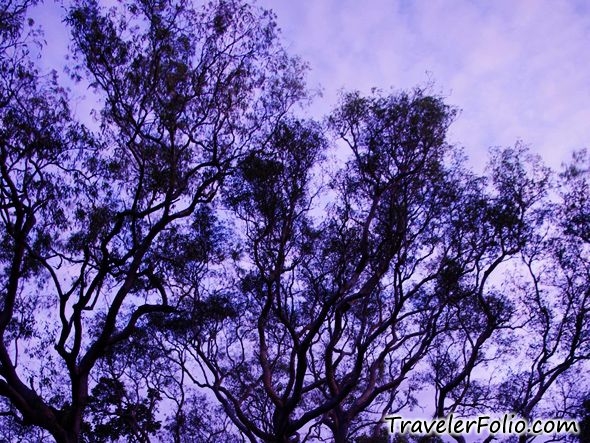
It was full moon that night, reminded me of werewolves prowling in the wilderness…
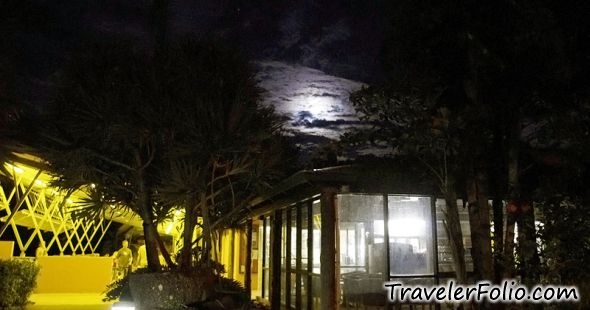
Address of Gagudju Lodge Cooinda: Cooinda, Kakadu Highway, Kakadu National Park Website: gagudju-dreaming.com
Please “Like” to follow Travelerfolio Facebook
Reader Interactions
March 1, 2011 at 11:55 pm
awesome experience.. 😀
March 15, 2011 at 4:17 pm
woah…… brings back my memories way back to a 10 days trip X’mas 2006.
Leave a Reply Cancel reply
Your email address will not be published. Required fields are marked *
Save my name, email, and website in this browser for the next time I comment.
Welcome visitor! Thanks so much for stopping by. Stay connected and follow us on social media. Happy travels!
Best wishes,

Guide to Kakadu National Park
Kakadu, Northern Territory 0822
Kakadu National Park is a sprawling nature reserve that boasts a collection of diverse and beautiful landscapes. Visitors can immerse themselves in a series of wetlands, rivers, and ancient sandstone escarpments in a region that’s rich in both stunning views and a fascinating heritage.
Proudly displaying the natural beauty of Australia’s Northern Territory, this 20 000 km² National Park is a great place for all who are looking to get in touch with nature. The park is divided into seven distinct eco-regions, from East Alligator to Nourlangie and Yellow Water, each region has its own unique features and natural attractions.
As well as more than 2,000 different plant species and hundreds of wildlife species, there is a massive amount of history and culture to soak up in the park. Centuries-old rock paintings adorn the soaring sandstone cliffs and sacred sites are scattered through the land.
The History of Kakadu
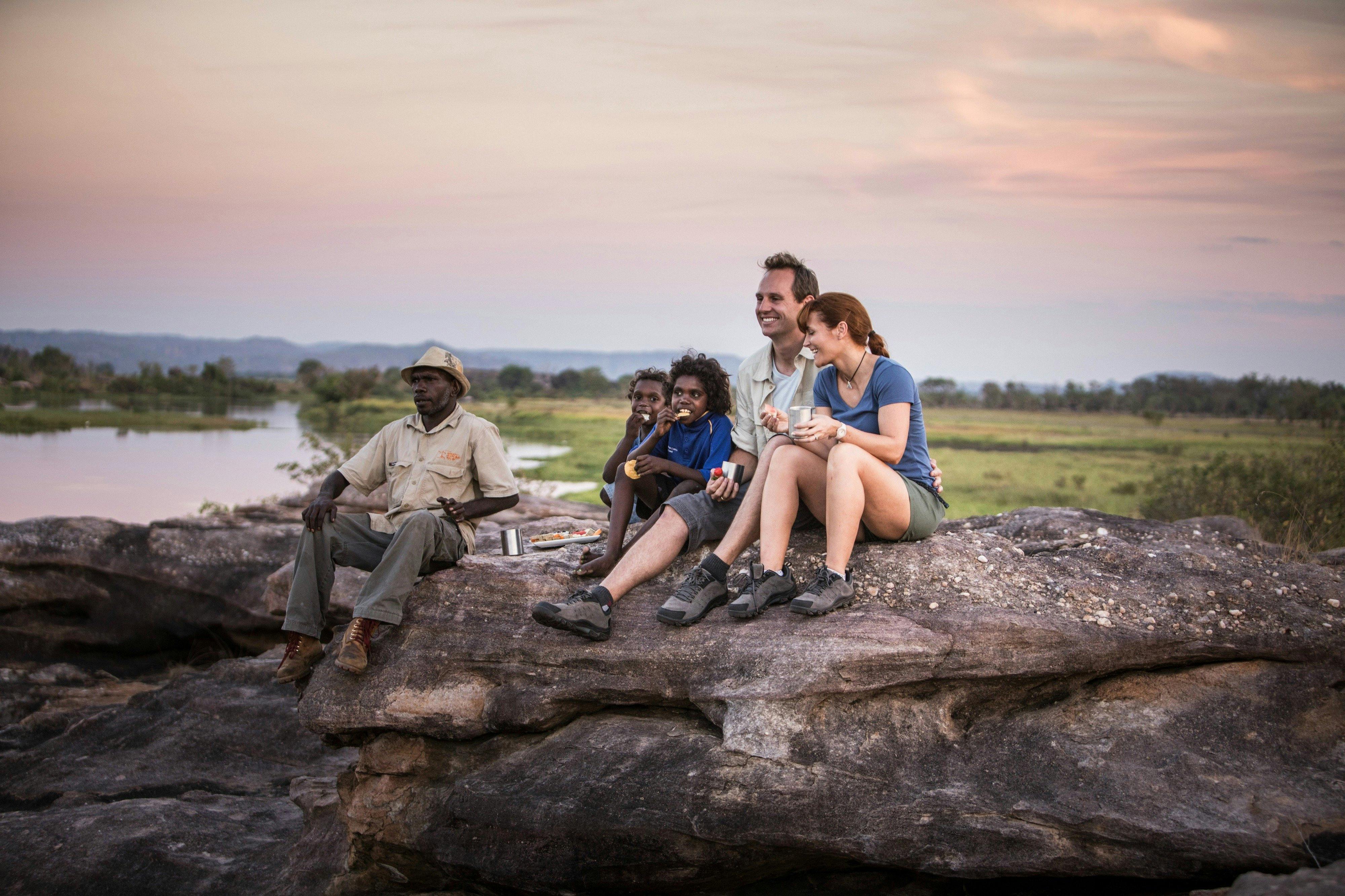
Kakadu National Park was first established in April 1979. The establishment of the region into a National Park was first suggested in 1965 when a cultural shift was occurring across Australia to recognise traditional owners and their land interests. At the same time there was a push for areas to be named as National Parks in order to preserve them for conservation. For over a decade, discussions continued with Aboriginal communities from the area and traditional owners about the declaration. It was during this time that the name Kakadu was first suggested as recognition of Gaagudju, a local Aboriginal language.
In 1975, the park was listed under the National Parks and Wildlife Conservation Act 1975 and, more recently in 2013, a culturally rich splash of woodland called Koongarra was added to the park.
However, Kakadu’s history extends back much further than 1965. The local Aboriginal people have been living on this land for over 65,000 years. They moved around the park’s land in response to changing seasons and their art and sacred sites teach us much about how their society operated and the ways in which they migrated throughout the parklands. According to local Indigenous stories, Kakadu has existed since the Creation Time, or the Beginning, when their creation ancestors travelled across the landscape. The Rainbow Serpent carved out the landscape for all creatures, and Namarrgon started the violent lightning storms that brings rain to the region each summer.
The Culture of Kakadu National Park
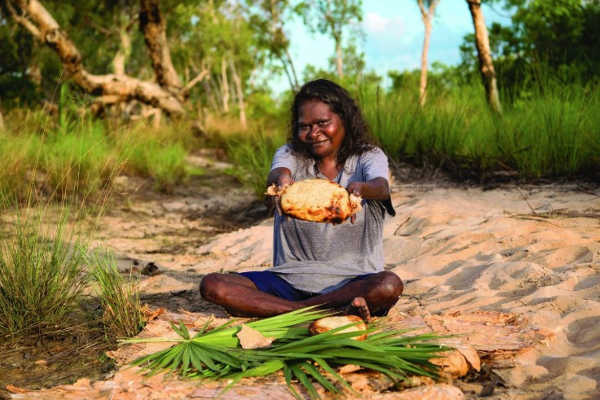
Kakadu is home to the oldest living culture on Earth. In the south live the Mungguy people, while the Bininj people live in the north. Many of the local Indigenous people live in the townships within the park while other live in more remote areas. Caring and understanding the land is fundamental in Aboriginal culture, and no matter where they live, the traditional owners have deep understanding and connection to land.
Within the park there are approximately 19 clan groups. Clans generally consist of two or more family groups sharing ownership of certain areas of land, these clan boundaries are passed down generations through the father. The clans within Kakadu have a complex kinship system that determines how individuals relate to each other. This kinship system dictates the ways in which individuals communicate and identify people as mothers, fathers, uncles, cousins, potential marriage partners, and so on. Kinship governs day-to-day communication in Mungguy and Bininj culture.
Tradition, responsibilities and culture are incredibly important to the Aboriginal people residing in Kakadu. This land has been theirs for thousands of years and you should respect their culture when visiting. Be sure to listen to tour leaders, or follow signage, to ensure you are not entering sacred or ceremonial sites, burial grounds, or someone’s home when in the park. Do not touch rock artwork you see and respect people’s privacy.
Before European settlement 12 languages were spoken in the Kakadu area, today only three are regularly spoken. Gun-djeihmi and Kun-winjku are spoken at the northern end of Kakadu and are regarded as dialects because speakers can understand each other. Jawoyn however is a separate language only spoken in the southern parts of the park. Though the Mungguy and Bininj people are happy to share their culture with non-Aboriginals, and welcome them to Kakadu, many stories and sites are only for the initiated and secrets must be respected.
Cultural Centres in Kakadu
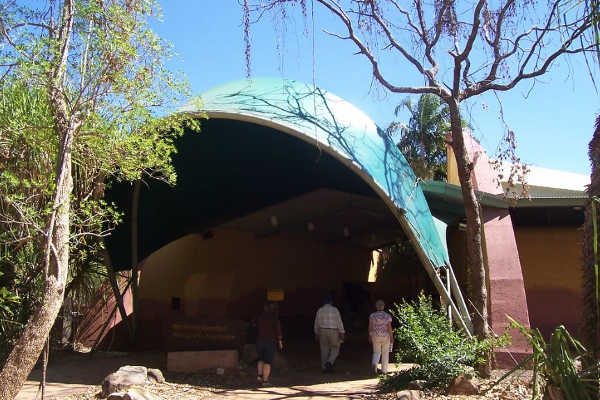
Cultural centres are a great place to learn more about Kakadu and its cultural heritage before setting of on your journey. There are two cultural centres in the park, each teaching visitors about different things.
Warradjan Cultural Centre
The first stop for any Kakadu trip should be the Warradjan Cultural Centre. Here you will learn about the relationship between resident Aboriginal groups and the land around them. Developed and run by the park’s traditional owners, the centre is the perfect starting point for any visitor to Kakadu.
Bowali Visitor Centre
The Warradjan Cultural Centre will teach you about the culture of Kakadu, the Bowali Visitor Centre will teach you about the landscape and wildlife. Designed to showcase both the Aboriginal and non-Aboriginal views of the park, it is hoped you leave the centre with a better understanding that we must look after the country of the Kakadu region.
Hit the Pools
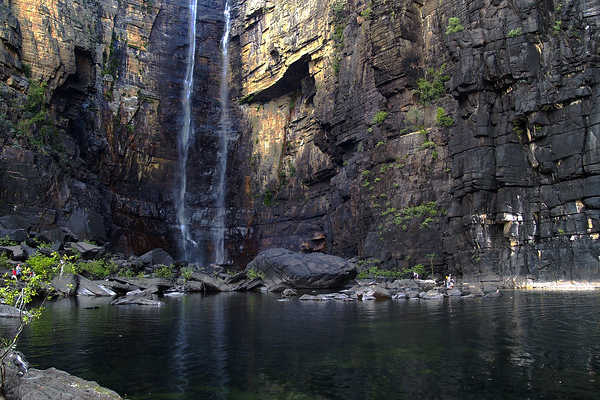
Kakadu is renowned for its selection of pretty plunge pools that are perfect for cooling off in. The wet season brings an abundance of water that sees falls violently flowing and pools flooding over. As the dry season rolls in the pools and falls calm to become some of the best places to cool down in the days heat.
Jim Jim Falls
maguk gorge, gunlom falls, rock art galleries.
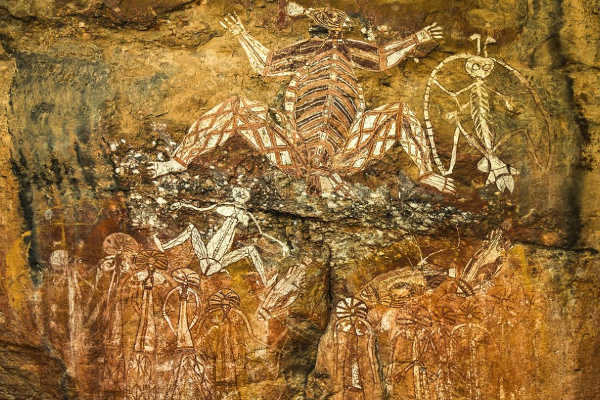
The rock art in Kakadu National Park is of significant international and cultural significance. With paintings up to 20,000 years old these artworks are some of the longest historical records of any group of people on Earth. Paintings are a form of cultural expression and for the Bininj/Mungguy the act of painting is more important than the painting itself, meaning in some areas you can see layers of paintings.
Paintings allowed people to express their stories, and some paintings could only be painted by people with the right knowledge. For example, only those who held magical knowledge could paint about sorcery. The paintings in Kakadu share a fascinating history of Aboriginal life and society over thousands of years.
Burrungkuy (Nourlangie)
nanguluwurr, wildlife in kakadu.
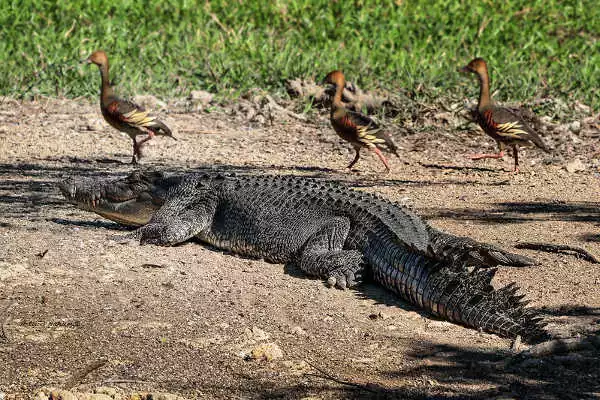
Kakadu is rich in native Australian wildlife, including endemic and rare species. Across each region you will find a new set of wildlife around you.
Saltwater Crocodiles
Black wallaroo, access to kakadu national park.
Before booking your trip to Kakadu National Park it is important to do your research. Kakadu’s traditional owners recognise six seasons within the park, however commonly the seasons are referred to as the wet season or the dry season.
Much of the park is not accessible during the wet season due to flooding, so be sure to check if the areas you want to visit are open during the time of year, you’re planning to take your trip. Kakadu National Park is Aboriginal land and has been leased to the Director of National Park. Today it is managed by the traditional owners in partnership with Parks Australia. Additionally, visitors need a Kakadu Pass to enter the park, you may also require a permit to visit certain areas. Book ahead online to ensure you can visit the areas you want to.
Kakadu National Park is one of Australia’s most culturally rich regions. You’ll never forget your visit to this truly spectacular area. Soak in Indigenous culture and breathe in the fresh air of rural Australia. There’s nothing like Kakadu National Park anywhere in the world, so don’t miss your chance to visit!
Explore Our Kakadu Tours
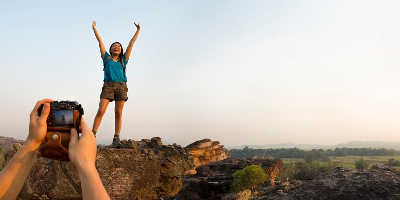
3 Day Kakadu National Park Tour $1812 – Accommodated
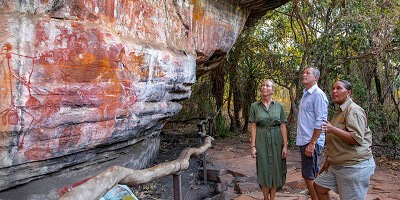
1 Day Kakadu Tour from Darwin $245
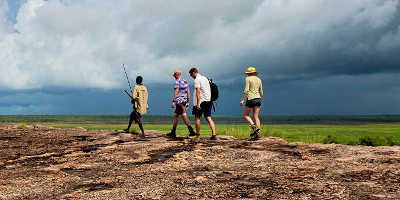
3 Day Kakadu & Litchfield Tour $815

5 Day Kakadu Tour with Koolpin Gorge $1682
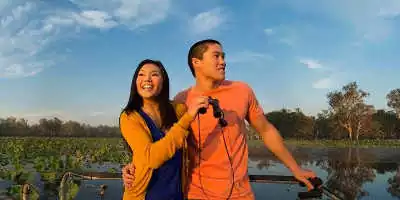
1 Day Kakadu Deluxe Tour from Darwin from $399

2 Day Kakadu 4WD Safari $350

4 Day Kakadu Adventure – Accommodated from $2060
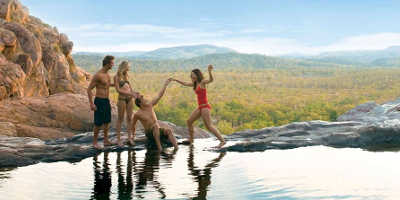
2 Day Kakadu Tour $400
An official website of the United States government
Here’s how you know
Official websites use .gov A .gov website belongs to an official government organization in the United States.
Secure .gov websites use HTTPS A lock ( Lock Locked padlock icon ) or https:// means you’ve safely connected to the .gov website. Share sensitive information only on official, secure websites.

International travel documents for children
See what documents a child needs to travel to or from the U.S. alone or with a parent or relative.
Children traveling to the U.S.
All children, including infants, must have their own travel documents such as a passport or document from a Trusted Traveler Program to enter the U.S. If you travel or are going to travel with a child, consider taking the following documents:
- If the child is traveling with only one of their custodial parents, they must have a letter of consent, preferably in English and notarized, from the other parent or signed by both parents. The letter should say "I acknowledge that my son/daughter is traveling outside the country with [the name of the adult] with my permission."
- If one parent has sole custody of the child, a copy of the custody document can take the place of the other parent's letter.
- Parents who frequently cross the border by land with a minor must always carry a letter of permission from the other parent.
U.S. citizen children traveling abroad
Ports of entry in many countries have security measures to prevent international child abduction . If you are traveling alone with your child, you may be required to present documentation proving you are the parent or legal guardian. You may also need a letter of permission from the other parent for your child to travel.
If your child travels alone, depending on the country, they may be required to present a notarized letter from both parents or their legal guardian. If a minor is traveling abroad and is not accompanied by both parents or a legal guardian, contact the embassy or consulate of the country you will be visiting and ask about entry and exit requirements for that country.
LAST UPDATED: December 6, 2023
Have a question?
Ask a real person any government-related question for free. They will get you the answer or let you know where to find it.

IMAGES
VIDEO
COMMENTS
Jim Jim / Twin Falls region. The highlight of Kakadu are these two waterfalls - Jim Jim and Twin Falls Gorge. 19. Jim Jim Falls. Jim Jim Falls is a stunning waterfall located in the southern region of Kakadu National Park. The falls can only be accessed by 4WD vehicles and require a short hike to reach.
What to Know Before You Go. To get into Kakadu National Park, you'll have to pay an entrance fee. It's $25 AUD for adults and $12.50 AUD for children between the ages of 5 to 15. If you're traveling with your family, you can get a group pass for $65 AUD. It's good for two adults and two children and is valid for an entire week.
From here, you are perfectly based to explore the following attractions in Kakadu National Park…. 1. Yellow Water Billabong Cruise: A Journey Through Kakadu's Wetlands. The mist floats above the water as the sun gently rises casting a soft yellow and pink glow over the billabong.
What a view! No, to enter Kakadu National Park you will need to buy a park pass, which is valid for 7 days. There are two main seasons in Darwin: wet and dry. During the wet season, the humidity is higher and there are many storms and monsoons. Prices are higher during the dry season, and cheaper during the wet season.
Kakadu Tourism is Indigenous owned, and is the largest collection of facilities catering to tourism in Kakadu. ... Their blog walkmyworld.com.au contains incredible adventures from around the world, but Kakadu certainly stood out for them as a must-do adventure destination. Following is an account of their experience in our beautiful backyard.
Elisha Updated on May 26, 2023 February 3, 2022 3 Comments on A Travel Guide to Kakadu National Park Without a 4WD Kakadu is a magical place. The expansive national park is one of Australia's largest and arguably most important, being at the core of the oldest living culture on earth.
Kakadu National Parkis one of Australia's most important and spectacular national parks. Kakaduprovides the visitor with a great introduction to many of the regions key elements: landscape, wildlife and weather. While interaction with indigenous folk may be somewhat limited, dialogue with local tour operators, guides and national park ...
Kakadu & Surrounds 3-day itinerary. Kakadu & Surrounds. Make the most of your 3 days to experience the diversity and beauty of Kakadu National Park. Follow expert guides to discover ancient local Aboriginal art. Get up close and personal with the largest reptile on the planet and learn about native wildlife on a river cruise.
When to go. The top end of Australia doesn't experience the usual four seasons. The wet season comes with the first crack of lighting on a late afternoon in November, and Kakadu goes from burnt orange to luscious green overnight. When the wet season ramps up, so does the humidity. So a normal 35°C day starts to feel more like 45°C.
Hike up the rocky and rugged plains of Nawurlandja. (Image: Tourism NT/Jewels Lynch) 3. Swim at Maguk. Best for: Active and adventurous traveller seeking off-the-beaten-path experiences. Of all the things to do in Kakadu, a swim at Maguk is one of the more under-the-radar activities, despite being absolutely stunning.
Jim Jim Falls. Kakadu National Park. See & do. Whether they are raging with water or reduced to a mere trickle, the majestic Jim Jim Falls are a sight to behold at the end of a challenging four-wheel drive track in the southern escarpment country of Kakadu National Park. (08) 8938 1120 Website Email.
Cooking up dinner at our campsite! This 3-day small group safari is the perfect option for budget-minded travelers who want to explore Kakadu without breaking the bank. We did this tour on one of our trips to Kakadu and loved it! The tour departs from Darwin and heads straight to Kakadu National Park for an exhilarating three days of hiking, swimming, wildlife sighting, and exploring.
One of our awesome Ultimate Travel gurus Holly Walker recently had the trip of a lifetime to the Northern Territory. Flying to Darwin from Sydney, Holly took part in a 4 wheel drive Dragonfly dreaming tour with Wayoutback Australian Safaris.. In Darwin, Holly stayed in the Youthshack hostel before heading into the national parks of Kakadu and Litchfield.
Take the first step. A journey of 1000 miles begins with a single click. Enter your email to get free trip planning advice from Kakadu rangers. Kakadu trip-planning ideas - find itineraries, where to stay, where to eat, where you'll find internet access and information on staying safe when travelling through the Kakadu National Park.
Kakadu National Park Travel Blog. Kakadu National Park is located an easy 3 hours' drive (171km) southeast of Darwin. Which is the capital city of Northern Territory. The park is open year round. Though certain parts can be inaccessible due to flooding during the summer (wet) season
Australia & Pacific. There is more than a national park at Kakadu; this place is also a vibrant, living acknowledgement of the elemental link between the Aboriginal custodians, the Bininj/Mungguy, and the country they have nurtured, endured and respected for thousands of generations. Encompassing almost 20,000 sq km (about 200km north-south ...
There are a few lodgings to put up with during your stay in Kakadu National Park. Nestled in the lush green surroundings, Aurora Kakadu Lodge features a lagoon style pool with a poolside bar, bistro and barbeque facilities. Located in less than a 3-hr drive from Darwin, the lodge offers studio cabins, two bedroom cabins, caravan and camping sites.
Jim Jim Falls. Jim Jim Falls is a popular place to go. These magnificent falls cascade down from a height of 200m and thunder into the plunge pool below. It's only open during the region's dry season, and it's only reachable by four-wheel-drive, making it a little less crowded than some of the other spots in the park.
Day 134 - Katherine to Kakadu The day started with Tropic Lesson Two - don't leave chairs out all night and then be surprised when you find a tiny f. menu continents | Sign In. Blog; ... Travel Blog » Oceania » Australia » Northern Territory » Kakadu National Park » Cooinda » Blogs » Kakadu - a definate must do!
July 21st 2012 We started the day in the cool pre-dawn on a boat cruise along Yellow Water and onto the South Alligator River (named before the explorers identified the species as crocodiles).
Background: Aboriginal settlers arrived on the continent from Southeast Asia about 40,000 years before the first Europeans began exploration in the 17th century.No formal territorial claims were made until 1770, when Capt. James COOK took possession in the name of Great Britain. Six colonies were created in the late 18th and 19th centuries; they federated and became the Commonwealth of ...
Kakadu National Park (KNP) ... travel along the way. It seems I got really lazy, as I neglected this travel blog between 2013 & 2018 despite having most worthy material to write about. During this time I was lucky enough to squeeze in more travel to parts of Sri Lanka, USA, New Zealand, Turkey, Vietnam, Hobart & Perth. ...
Children traveling to the U.S. All children, including infants, must have their own travel documents such as a passport or document from a Trusted Traveler Program to enter the U.S. If you travel or are going to travel with a child, consider taking the following documents: If the child is traveling with only one of their custodial parents, they ...
Kakadu national park one up was a 2m croc which definitly looked big enough for me until up popped the head of a massive 6m croc..the small one had no chance of getting any dinner there!! Day 3~We spent today climbing up to some of the amazing viewpoints in the park and looking at some of the ancient aboriginal drawings!